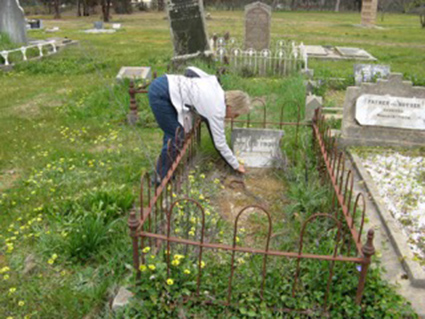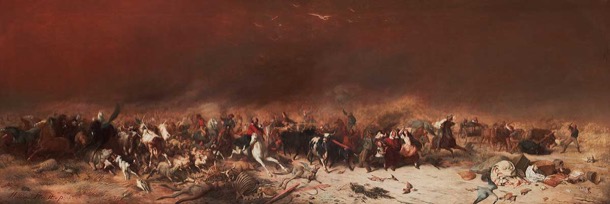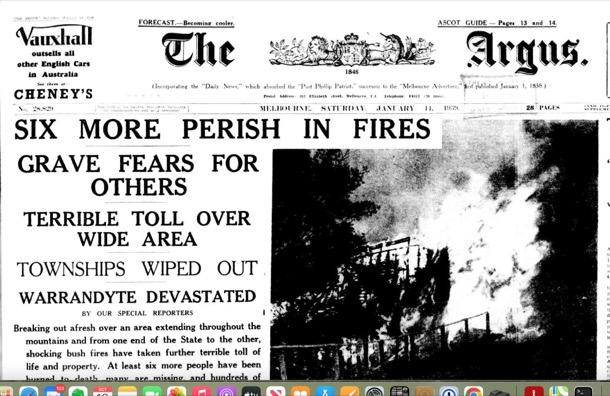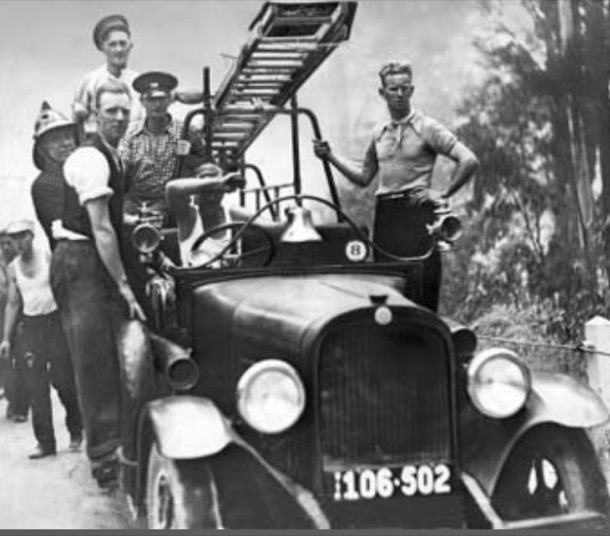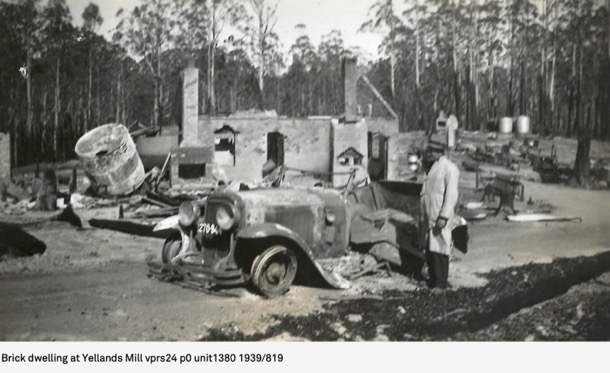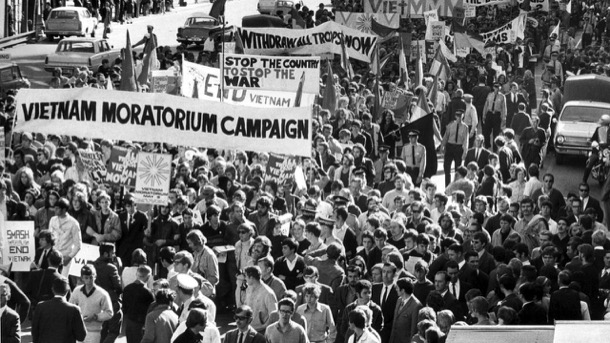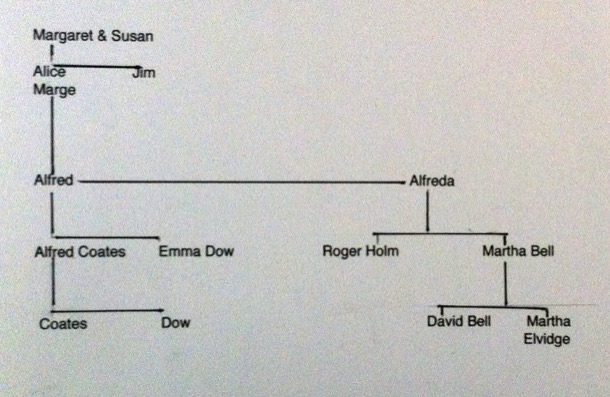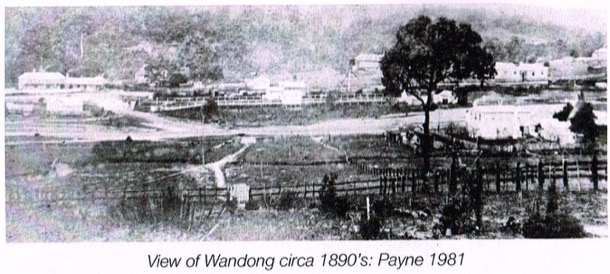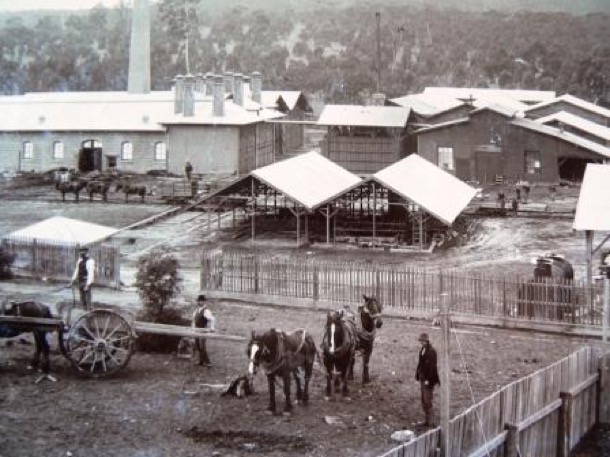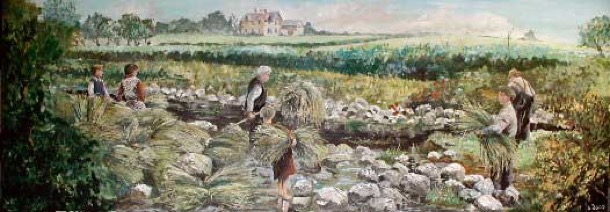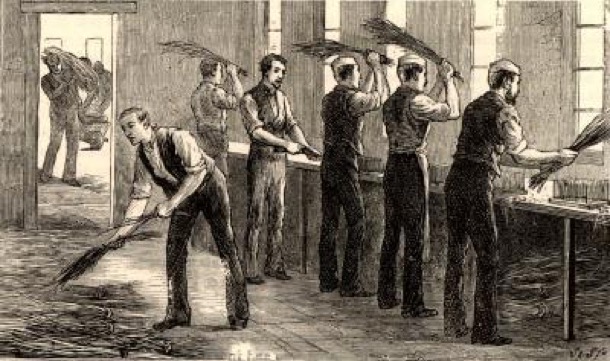Fire and Storm
MY COUNTRY By Dorothy MacKellar
‘I love a sunburnt country,
A land of sweeping plains,
Of ragged mountain ranges,
Of droughts and flooding rains.
I love her far horizons,
I love her jewel sea.
Her beauty and her terror,
The wide brown land for me.
Margaret and I learnt this iconic poem during our respective Grade 6 years and many of its lines are still etched in memory. In fact we can still recite much of it with exactly the same intonation and expression. This poem, written in 1904, captures the tenor of our post, Fire and Storm.
Fire, still very much part of our lives, has also been part of our family history.
BLACK THURSDAY 1851
The first reference to fire was in1851 with the fire known as ‘Black Thursday’.
Painting by William Strutt
This was the first catastrophic bushfire faced by white settlers in Victoria. The lead up to the fire followed what is now a familiar pattern of events. Reports at the time said that there had been wet years of lush growth followed by severe drought, leaving the bush and long grass tinder dry. Thursday the 6th of February dawned hot and windy, and the fires took off, leaving one quarter of the state black and smouldering. Our antecedents, the Bourke’s of Pakenham, were caught up in the fires in a dramatic way. Shortly before Black Thursday the Bourke’s had taken possession of Bourke’s Hotel in Pakenham. Michael Bourke remained at their selection, while Mrs Bourke was to run the hotel and Post Office.
‘On Black Thursday the whole district was ablaze. Mr Bourke was trying hard to save the station property. Water having been exhausted, milk was brought into play and ultimately the run was saved. Word was brought to him that the hotel property at Pakenham was surrounded by fire. Galloping down there, he found his wife and her children had saved themselves by crouching in the water in the bed of the creek.’
We took this photo of the exact spot, during our visit to Pakenham.
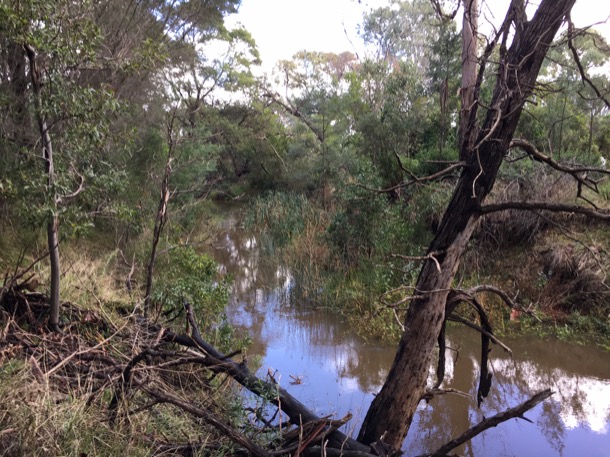
BACCHUS MARSH FIRE 1928
From an article in ‘The Argus' Thurs 12th July 1928
"FIRE AT BACCHUS MARSH.THREE SHOPS DESTROYED"
This was a report on the fire suffered by our grand parents, Alf and Alfreda, in which they lost almost everything, but escaped with their lives. We heard dramatic stories of this fire in childhood and is told below by Marge and Alice on the tape they made in 1990.
The hardware shop was their business, and they had gone out on their own, in an already a difficult time of their lives. Aunty Bert was staying with them to help out, as was her role in the family, as the unmarried sister. Auntie Bert, Alf and Alfreda would have been in their early thirties,Alice was five and Marge three years older. Thank goodness Bert was there as she seems to have had a cool head and took action to get everyone out as the fire took hold.
Marge and Alice’s recollection is fairly accurate, as the newspaper report comments on the strong North wind and the poor water pressure that hampered the fire fighting.
The Argus reports that at one stage,
…. the premises of Mr. G. H. Anderson were threatened , but this danger passed, with a change in the direction of the wind, A good portion of the stocks of Messrs. McLaren and Coates was saved, but considerable damage was done to Mr. Phillip’s stock. It is understood that all buildings and stock, except that of Mr. McLaren, were insured.
At half-past 7 o'clock, in the morning the fire was under control, and all that was left of three of the shops were the walls.’
Mr McLaren may have been uninsured but Alf was definitely not, as he had been unable to pay the insurance. They lost nearly everything.
We had wondered about Alice’s comment about Auntie Bert’s friend Nell Pearce, whose family took them all in after the fire, and yes it was a large and impressive brick house, still standing today: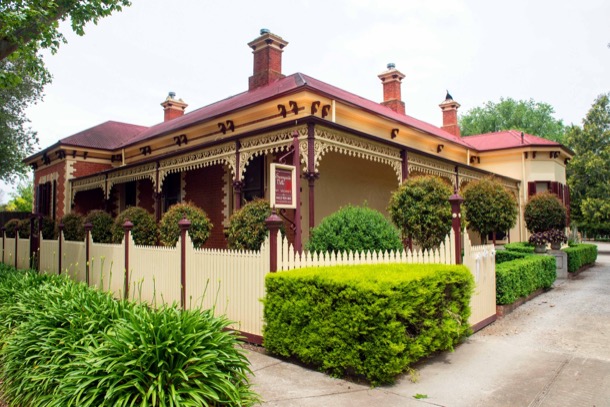
As Alice states the Pearces were an influential family in the town. They had been an early pioneering family in the area. They built and established the General Store that presumably was very profitable, supplying the miners on the way to the Goldfields as well as the local community. The family then went into farming and other small businesses, and were influential in civic affairs.
Auntie Bert maintained a lifelong friendship with Nell, and neither of them married. I remember Nell Pearce being a name mentioned in conversation and I have a vague recollection of her as an imposing figure. I also remember her at Auntie Bert’ s sewing rooms in Camberwell. She was probably there for a fitting. Little did we know the history behind that friendship.
After cleaning up and sorting our their affairs Alf and Alfreda, the girls and presumably Auntie Bert left Bacchus Marsh and stayed with Grandpa and Grandma Holm in Surrey Hills. Alf then got a job in Croydon as manager of the hardware shop, where they spent many happy years.
BLACK FRIDAY 1939
After the 1851 fires, bush fires occurred in many parts of the State with predictable monotony. The next major statewide fire was in 1939, once again after a prolonged drought. High temperatures and strong northerly winds fanned separate fires that eventually combined and created a massive fire front that swept mainly over the mountain country in the northeast of Victoria, and along the coast in the southwest.
Lilydale Brigade 1939.
Source - CFA Website
More than two million hectares were burnt in the 1939 fires.They lasted for a week. Many, unable to be controlled, were left to burn out.
Yellands Mill, where 15 men died:
The extensive damage to over two million hectares of farmland and forest, not to mention the loss of livestock and lives, prompted a Royal Commission. They were tasked with examining the causes of the fire and making recommendations for future management.
The Royal Commission’s specific recommendation was that the various Bush Brigades, and Country Fire Brigades be amalgamated to form a single organisation to fight fire on private land outside the Metropolitan Area. The Forest Commission was responsible for fire on public land and the Metropolitan Fire Brigade was responsible for fire in the Metropolitan Area. Instead of a myriad of uncoordinated small brigades these three organisations were responsible for fighting fires in Victoria.
EARLY BUSHFIRE EXPERIENCE - MARGARET
My first memory of wildfire is of a fire on the empty block next door. The vegetation was sparse: weeds and gorse, with patches of bare clay.
We think it was around 1955. Sue doesn’t remember it, and was probably at school. But I have a clear memory and so I was probably at least four. The image in my mind is of mum, armed with a hessian bag, beating flames. Hessian is a coarse, rough brown fabric made from jute, widely used for packaging. We had a supply of hessian bags, saved from buying bulk chook food. Mum was not a “bush woman” in the Henry Lawson image, but she would have seen this form of fire fighting, and she apparently felt able to take it on. 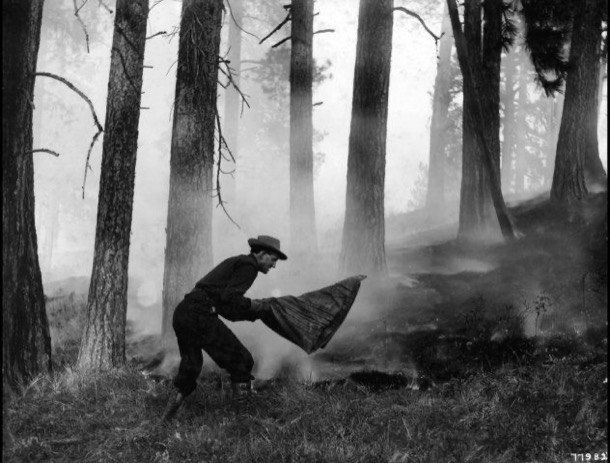
Fire fighting with a hessian bag.
I don’t remember bush fires being a big part of my life as a child, until I was eleven, in 1962. That year was a big bushfire year in Melbourne’s eastern suburbs: 32 people died and 450 houses were lost. Areas affected included Mitcham, less than ten kilometres away from our place. We were never in danger in suburban Box Hill South, but there would have been a red glow in the sky, and the vivid memory I have of burning gum leaves falling in the back yard, is probably from this fire.
In 1979, I moved to the Dandenong Ranges, where the CFA had much more of a presence, and bushfire awareness was part of everyday life over Summer.
In those first few years, there was still on old dugout just over the road in the forest. It had a wooden sign “Dugout” and what looked like a large wombat hole. A closer look revealed a heavy grey army blanket hanging over the entrance. During a fire, this would be kept wet. Inside was a rounded cave, with earthen floor, ceiling and walls. It would have held a maximum of six adults. There was a metal bucket and a pile of musty grey wooden blankets. I guess it might keep you safe while a canopy fire raced overhead, but I wouldn’t want to rely on it.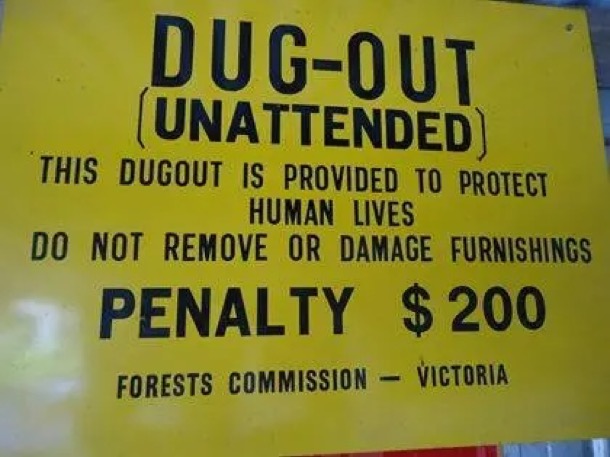
The CFA were, and still are, omnipresent. On weekends they collect donations at major intersections. On Good Friday, and in the week before Christmas, they drive through the streets, playing piped music and rattling collection tins. Their sirens regularly echo through the Hills. We can hear the Belgrave, Upwey and Kallista sirens from our place, and sometimes all three will go off. In the past, the siren was used to call in the volunteers, and on a set night of the week, on CFA practice night, they would test the siren at a set time. We like that the sirens are still used, not so much as a specific warning, but as part of our aural landscape.
Nowadays, when we hear a siren, we go straight to the Victorian Emergency app, to check what has happened. Often it’s a house fire, a car accident, a small bush fire. During the Summer months we are more attuned to the sound. Our practice has long been to evacuate on days of dangerous fire weather.
BLAIRGOWRIE FIRE 1980 - SUE
My only experience of fire first hand, was in 1980 at Janey’s house at Blairgowrie. We had all just sat down to lunch. Anna was nearly three and I was pregnant with Thomas. Everything was tinder dry, as it was January and we were in the middle of the 1979-1983 Eastern Australian Drought.
Halfway through lunch there were loud knocks at the door, and a panicking young man asked us for a hose, as he has seen a small fire beginning to build on the Spray Point Road, just fifty metres from the house. Jono and Janey raced down to investigate, but realised that they had not a chance of stopping the fire. It was spreading quickly, fanned by a strong north wind. This was a stroke of luck as this meant it was spreading away from us and towards the beach. We called the CFA who responded promptly, parking several fire trucks at the hydrant on the nature strip.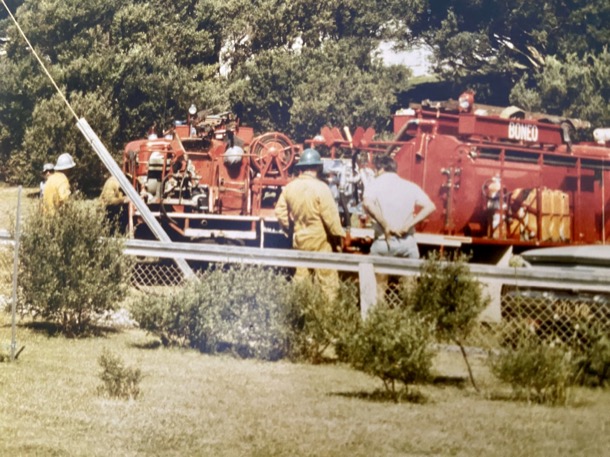
We were told to block the downpipes with oranges, fill the gutters with water, and shelter inside. The fire was brought under control fairly quickly but not before six hectares of the National Park was burnt.
It would have been a different story if the wind had changed and pushed the fire towards Janey’s house and of course all the other houses.
Local newspapers at the time reported on the fire and issued warnings and advice to residents and holiday makers for the rest of the holiday season that was only just beginning.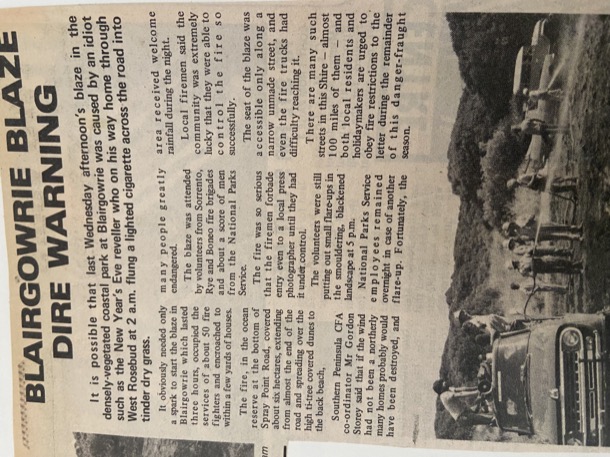
ASH WEDNESDAY
SUE
On Ash Wednesday I was at home with Thomas, as Anna had just started school. Thomas was happily playing with water in the shade of our pergola, as it was a very hot day. A nasty north wind intensified as the day wore on and many fires started across Victoria. I was listening to the ABC afternoon show hosted by Tony Delroy, who, as fires broke out, was reporting the outbreaks in real time. He also took many calls from people desperate for information. There were no centralised communications hub, warning system, or, of course, mobile phones. As the fires continued to burn during the evening and that night, the radio was the only source of state wide information. The 3LO radio hosts worked on a roster system to get the information out.
Since its inception the ABC had been responsible for emergency broadcasting, but only on the news bulletins.. In 1997 Ian Mannix was appointed as Program Director for Local Radio Victoria. He changed the nature of emergency broadcasting during the 1997 bush fire in the Dandenong Ranges. The fires burnt for days, three people died and forty homes were destroyed. Mannix asked the CFA for advice on what to say to to listeners ‘who were confronted with flames.’…Interestingly, the CFA had no experience of giving warnings and had never written a warning for people at risk.
Mannix went ahead and took the lead in creating the ABC’s approach to emergency broadcasting. He developed guidelines that included warnings at set intervals, including bush fire alerts for low level fires and urgent threat warnings for more serious fires. The system used in Victoria was expanded nationally after Black Saturday in 2009. Further recommendations were made by the Black Saturday Royal Commission that future refined and expanded the warning systems to television and commercial radio.
From this pioneering work by Ian Mannix, we now have an Australia wide warning system, and broadcasting training and guidelines in each state.
Ian Mannix oversaw the development and implementation of these systems and deservedly received the Australian Public Service Medal in 2012.
MARGARET
The first actual fire we had to deal with in Belgrave was the 1983 Ash Wednesday.
The name “Ash Wednesday” is nothing to do with ash from bushfires. It’s a historical/religious reference. It happens every year, and it marks the beginning of Lent, leading up to Easter, in lots of Christian denominations. It follows Shrove Tuesday, Mardi Gras … the last day of feasting before the deprivations of Lent. The ‘ash’ is sprinkled onto heads or swiped across foreheads as part of the Ash Wednesday service.
1982 had had a very droughty Winter, Spring and Summer. The little creek that runs through the forest over the road had almost stopped, and underfoot the leaves crackled.
The 1983 Melbourne dust storm, when 50,000 tonnes of Mallee topsoil turned the sky dark brown across the city, happened in early February. For me, it hit as I was crossing Burwood Highway on my way to the Ferntree Gully hotel, for an after school cool drink. The dust cloud was over 300 metres high and 500 kilometres long, and darkened the sky for an hour. It’s one of those iconic events where everyone can tell you where they were when it hit.
Image credit: Katsuhiro Abe/BOM
There were many fires that Summer. The CFA across Victoria attended nearly 3,200 fires. Wednesday February 16th was particularly hot and windy.
That morning I had woken feeling nauseous and weak. I rang in sick, and went back to bed. Within a few weeks, I would find out that this had been the beginning of morning sickness. Michael was born that October.
Later in the day I had a phone call from a friend who lived locally, suggesting I might consider leaving, as he had heard there was a fire in Belgrave Heights. Outside was stifling. My neighbour was packing her car but she was expecting to wait and see. I don’t remember having any sense of danger, though, later, we learnt that it was only the late afternoon wind change that stopped the fire from sweeping through Belgrave township and on to our place.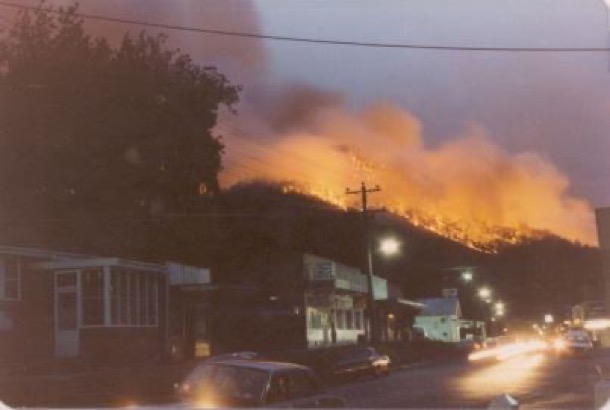
Photo: Tonia Van der Dungen. Christmas Hills CFA
Wind changes during bush fires dramatically widen the fire front, and this one swept through Belgrave South and on to Cockatoo and Upper Beaconsfield.
I don’t remember this, but apparently Ian and Lois were visiting me that day. Lois was pregnant with Sam who was born that winter. Ian speaks of driving home in the afternoon, and taking the sudden decision to drive straight on through Belgrave, rather than the more logical route through to Belgrave South. This would have been exactly the time of day when the fire swept through across the road they would have been on.
Later there were many stories, horrifying and heroic. In Cockatoo, 300 people sheltered during the night in the kindergarten, as a handful of local men kept the flames and embers at bay, saving many lives.
Across Victoria, 75 people died, more than 200,00 hectares were burnt and 2000 homes and buildings were damaged.
Friends from the suburbs rang to check that I was ok. Our little patch of the Dandenongs was untouched, but one didn’t have to drive very far to see the black horror.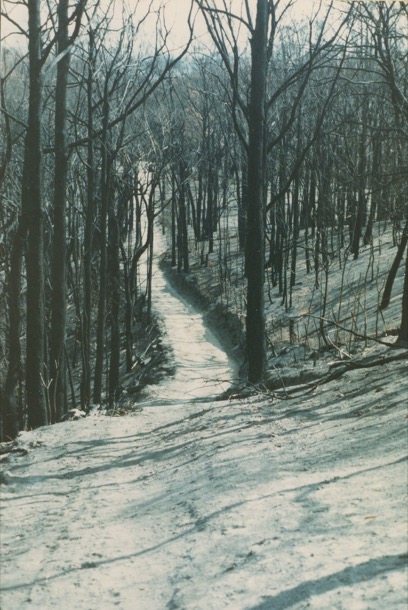
Photo: Critchley Parker Junior Reserve. Upper Beaconsfield CFA
Ten years later, I began teaching at Monbulk College, and some of our students were still affected by their experiences in 1983. My friend and colleague Sarah had her Year 8 English class make a booklet marking the ten year anniversary. Everyone had stories, which the students typed up and put together. It remains an important part of the history of Dandenong Ranges, and other affected parts of Victoria.
The tragic Ash Wednesday fires were like those of 1939 Black Friday in intensity, if not in range. They confronted the modern firefighting community with the limits of its capacity and technology. Among the 75 dead, 17 firefighters died that day, some of them next to their well equipped tankers on a forest road in Upper Beaconsfield, when the wind changed and the firestorm swept over them. Changes in firefighting strategies and philosophies were inevitable. The community needed to be better informed and more involved. This is certainly my experience. I was so naive and ignorant, compared to what we expect from Hills people nowadays! There was a huge Royal Commission.
It seemed, as the Commission heard people’s Ash Wednesday stories, that the most dangerous situations people faced were from hurried departures. People died in their cars, not their homes. But the CFA could not guarantee to be there during huge bush fires, protecting every home.
And then there were stories of people actively defending their homes from ember attacks, and saving them. “People save houses. Houses save people.” was the mantra.
The “stay or go” policy began to be developed. As the professionalisation of firefighting, and the ‘Science’ of fire behaviour developed, ordinary people’s anecdotes were often disregarded as over hyped and hysterical.
There was a huge campaign to teach the population about how to prepare their homes, and defend them. Because it was so centralised, the people who lived on the edges of grasslands and those, like us, in what nowadays we call the “flame zone”, were given the same advice. The “go” part of “stay or go” felt like an afterthought for people who were not able bodied. I remember some of our neighbours’ plans were that the men and older boys would “stay” and the women and little children would “go”.
In 1987 the very first General Achievement Test had as one of its tasks information about how to prepare a home for bushfire. It was clearly in the zeitgeist.
My personal experience of this policy is encapsulated by a CFA Fireguard group meeting, in the years leading up to 2010, that we attended on our neighbour’s verandah. The CFA man explained patiently about how bushfires behave, and how we should be preparing our houses, so that we could defend them. The expectation was clearly that we and our neighbours would stay, in the case of a bushfire, and, with mops and buckets of water, we would put out any embers that threatened out house. We pointed to the towering ash forest, metres from our house, and told him we didn’t think our house would be defendable. He was not impressed.
Throughout the Millennial drought, from 1997 to 2009, during the most severe summers, we kept a trailer full of things at Chris’s parents’ place, and had a very clear plan. We evacuated quite a number of times, staying in their spare room. The plan was to insure fully, and simply not to be there during dangerous times. The local schools built fire refuges, and the CFA kept on with its “stay and defend” message. Water saving advice was everywhere. Like many others, we set up a grey water system to water our garden.
BLACK SATURDAY - MARGARET
And then came the summer of 2008-9. It had been particularly dry and hot. This was the summer when tree fern fronds were scorched, lawns died and record high temperatures were broken day after day. The forecast for the first week of February looked horrendous in advance, with temperatures of 48 degrees forecast, and Chris and I decided to take ourselves camping by the Thurra river, and wait it out. I was glad to be retired by then!
We followed the news of Black Saturday, on the radio, and, once the cool change hit, we packed up and drove out along the Thurra Road, as news of the death toll mounted. Along the Princes Highway, we saw fire fighters’ camp sites with row after row of little tents. The air was smokey, and through the Latrobe Valley we drove through a blackened landscape. At home, the garden was scorched and everything still crackled underfoot.
Back with television coverage, we watched interviews with people who had miraculously survived, saw footage of people’s fire refuges that had been easily breached, and heard the stories of person after person, traumatised by their unsuccessful attempts to defend their homes. 173 people had died, 120 of them in the Kinglake area. More than 450 hectares had burned and 3500 buildings, 200 of them houses, had been destroyed.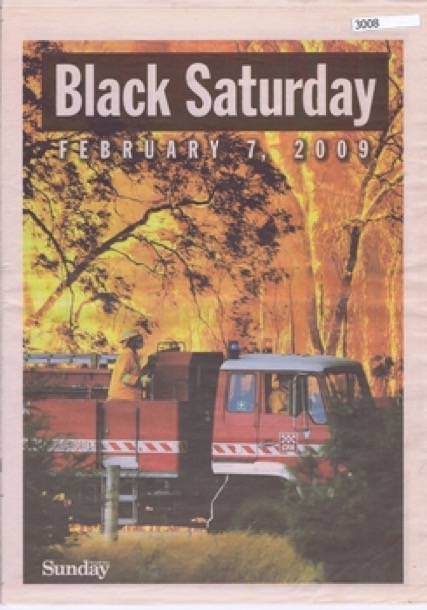
Herald-Sun
That cool change was not the end of the 2009 fire season. We evacuated a number of times that February. One day, a fire bug lit a fire just up the hill from us. I was sitting outside, and heard the crackle as flames licked up a nearby gum tree. Chris was walking in the forest. As I drove down to the Belgrave carpark, he was walking quickly back down through the forest, having seen the smoke. When he met a wall of flames, he backtracked hastily, headed toward the road, and hitched a ride with a stranger to near home. The wind was blowing the danger away from our place. I have been mocked mercilessly for my paper post it note on the door telling him I’d gone to the Belgrave car park, but at least he knew that I was out of danger.
In the car park, a gaggle of us watched the Elvis fire bombing helicopters head up the hill, and cheered, and very soon the whole drama was over.
2009 marked the end of the Millennial drought years. Summers since then have been cooler and wetter. But the legacy has been an obsession with rainfall figures, forecasts and climate outlooks.
Our local community facebook page has a member who is a forecaster with the Bureau of Meteorology, who posts every time there is a weather anomaly. It is clear from the responses to him, that we are not alone in our anxiety about rainfall.
THE BIG STORM - MARGARET
It was winter, 2021. There had been yet another Covid lockdown, this one lasting two weeks, finishing on June 10th. Life quickly went back to normal for most people in Melbourne.
But for us in the Dandenongs, the evening of June 9th, and the next morning, brought a massive windstorm which brought down huge swathes of trees, many across roads and onto 112 houses. The wind came at 120kph, but it came from an unusual direction, and our shallow rooted mountain trees were largely untested from that direction. They fell, roots and all, in their hundreds.
Even though the power went off immediately, and all the mobile towers were out, there were 9,500 calls for help logged by the SES. People were trapped in their houses, and many streets, including Michael and Katherine’s were blocked off. There was no way of communicating, in or out, for many days.
My most vivid memory of the storm comes from early on the morning of the tenth. Chris was standing with a view to the north of the forest out the window. His eyes widened, and yet another a great crash came from the forest. He had watched a two hundred foot tall mountain ash eucalypt gracefully fall sideways, taking down another tree of similar size, which in turn took out another one. Like enormous dominos, the three of them had joined the huge pile of previous victims on the forest floor. Later on we stood on the road, looking down where they had fallen and counted thirteen giant trees lying in a messy tangle.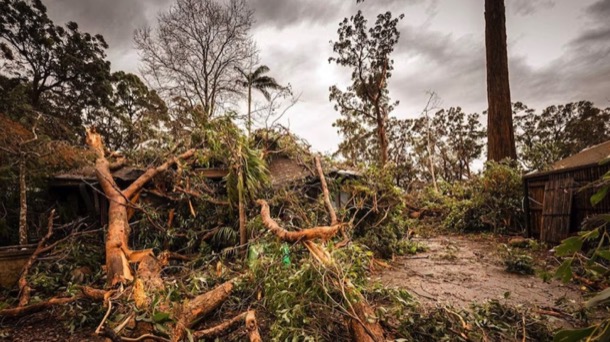
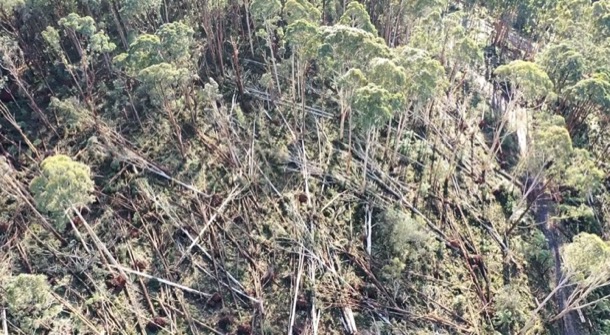
Elsewhere in the Hills, this carnage had been repeated in town after town. We lucky ones who still had homes, watched with dismay as the power company’s estimates of power restoration stretched out beyond a week. Eventually we were able to drive out. It was a weird feeling to drive down onto the flat and find life going on as normal. For us the feeling was very much as if we were still in lockdown. On the Monday evening, I went to choir rehearsal in Ferntree Gully, blinking in the unaccustomed bright lights. Many of us Hills residents had brought items to be recharged during the evening. At end of the night we drove back up into the darkened Hills.
At home, we went into camping mode. There was no hot water, but we had plenty of fire wood, and our very effective wood heater. We cooked with gas and our little portable gas fridge kept our essentials cold. I took to having my bucket bath in the afternoon, when it wasn’t quite so cold in the bathroom. It was ten days before our power came back on, on June 20th.
The reprieve from lockdown lasted only a month. By July 16, Melbourne was back into working from home, home schooling, and leaving home only for essential purposes.
Pins and Needles
SUE
Although I have grown up with sewing and sewers in my life, it has never captured my interest, until recently. I have horrible memories of sewing classes in Year Seven. We were supplied with rectangular brown, cardboard sewing boxes, which held all our supplies and the current sewing task. All went relatively smoothly during the first half of the year as we learnt to use the machines and made our cookery apron and cap for Home Economics classes in Year Eight. Then we graduated to making a white, lawn, lace trimmed slip with french seams.
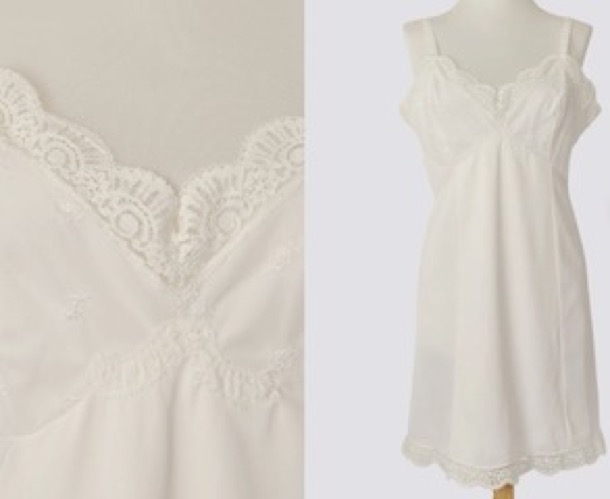
I must have made several mistakes and had to unpick the french seams around the bust several times and my work became very grubby and worn. I looked with envy at the neat and pristine garments of some of my classmates. Starting again was not an option so I decided to smuggle it out and fix it at home. This was strictly forbidden! In the general busyness in the storeroom as the girls put their sewing boxes on the shelves, I hid the offending item under my blazer. Even at home it was very difficult to resew neatly, because of all the needle holes and general grubbiness. At least I could move on with the easier straight seams and the hem. Thank goodness I was not caught smuggling the sewing back into my sewing box. I finished the garment but never wore it. I am sure I would only have received a D, which I would not have liked.
My next foray into sewing was in the first year of my Art and Craft course. The first year was “dressmaking”. I did not enjoy it much, but it was not horrific, as the petticoat had been. I certainly did not want to teach sewing, and I was never asked to, thank goodness.
Surprisingly, I have recently started sewing again. I, like many others, started sewing in lockdown during the Covid pandemic. I am part of a widespread sewing resurgence, facilitated by the technological advances that give me access to fabrics and patterns all over the world and in Melbourne too.
Choosing the fabric and pattern are the aspects of dressmaking that have changed the most. For instance, I recently bought a winter coat pattern and fabric. Once, I would have gone to a local shop and leafed through thick, well thumbed and worn.pattern books by Butterwick, McCalls and Vogue.
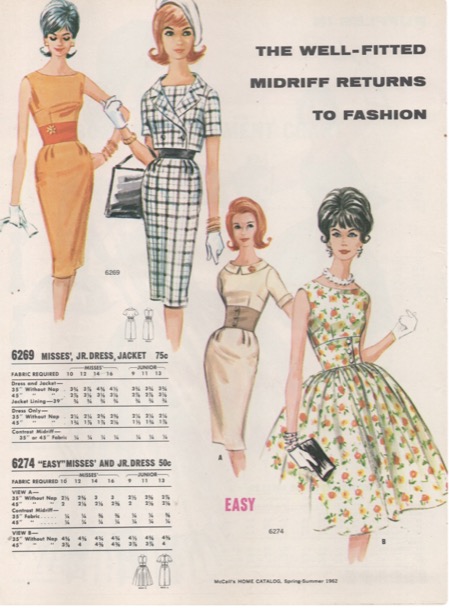
Instead, I chose my vintage coat pattern online, from a business in Germany. It was converted to a PDF format and delivery was almost instantaneous. Then the fun began as the pattern had to be printed. Two options were available for printing. The pattern could be printed on a home printer in A4, with the disadvantage of the pages needing to be joined with sticky tape. The alternative was to go to Officeworks and have the printing done for me, as one large sheet.
I have also discovered the joys of shopping worldwide for fabric. One of my favourites is a haberdasher in Hull in the UK, whose ethos is the creation of long lasting, wearable clothes from their patterns and their sustainably and ethically sourced fabrics. Merchant and Mills is part of a worldwide niche market, that is a reaction to the fast fashion industry, where very cheap, mass produced garments are expected to be thrown away after only a few wears.
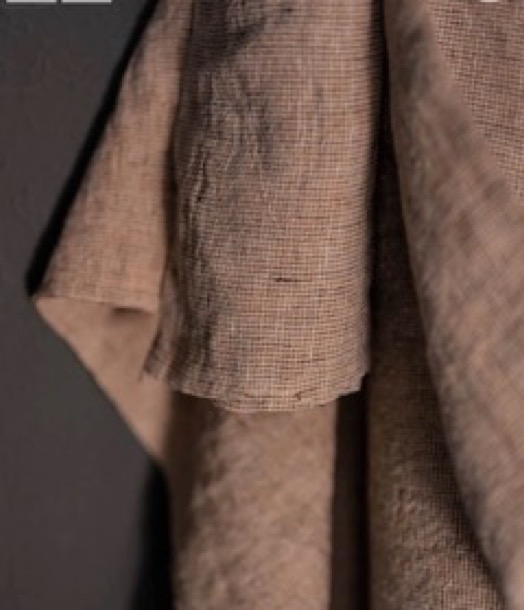
‘This European laundered linen, tumbled at the mill for softness, is a dusty peach and dark brown. It is produced in small batches in Eastern Europe where there is a strong heritage of spinning and weaving linen fabric’
MARGARET
One of the joys of retirement is having time for the little ones. For me, this included making special things for them, mostly sewing and knitting, and always geared to their particular interests and preferences.
Sometimes the occasion was birthdays and Christmases, but sometimes special requests came my way.
The first of these was a Christmas: matching pink fairy dresses for the three little girls. Here is Harper in hers:
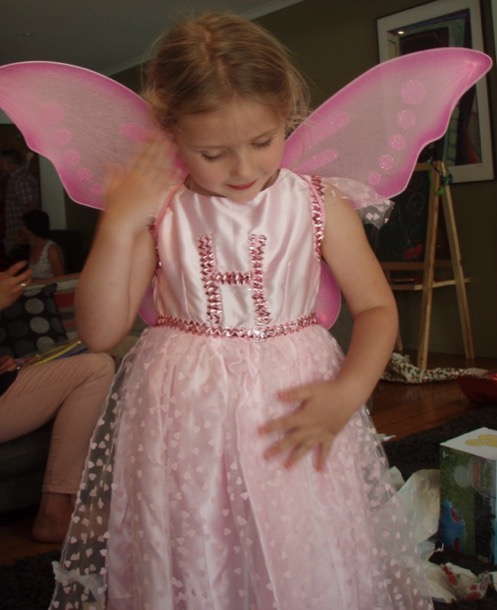
Later on, Harper’s colour preferences changed. For more than a year, she was all about cyan. You and I might have called this colour aqua or turquoise.
This was the colour specified for her special request for a jumper with a bunny on it for her, and one with a girl on it for her bunny.
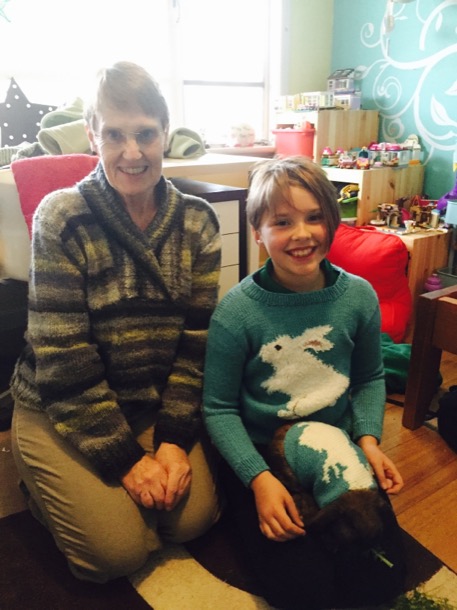
Aurelia was exactly the generation to be all about Disney’s Frozen. Her first frozen dress was a bought one, and she wore it out, before she tired of it. Thus it was, that my first Frozen job was to rehabilitate it:
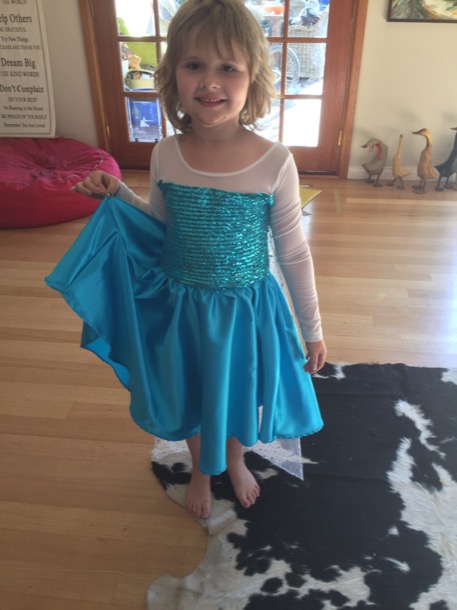
Then, when Frozen 2 came out, with that green dress, Aurelia and I trooped off to Spotlight to choose fabrics for her new one.
Here, she models the front and back of the final product:
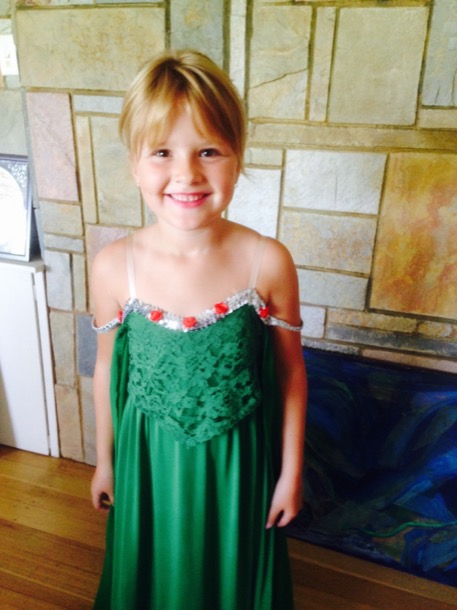
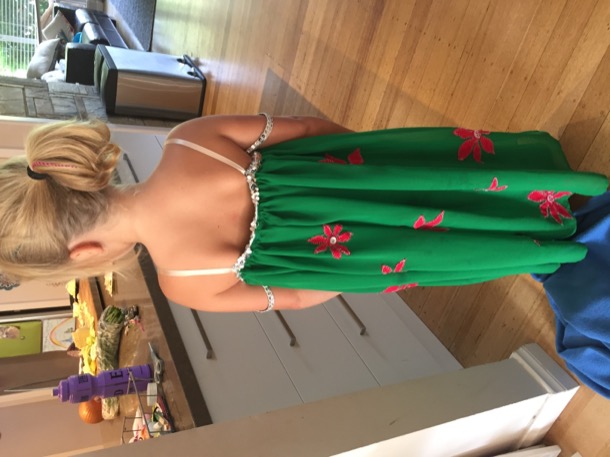
When my own grandchild came along, son of an artist, my initial contribution was a lacy baby blanket, not baby blue, but dark grey.
His first winter coat was also designed by Katherine, and made by me:
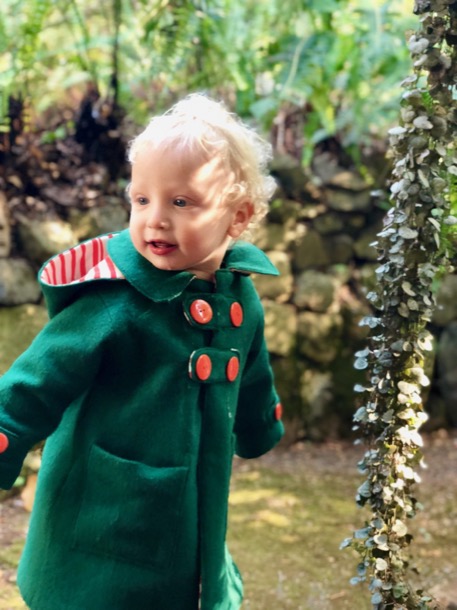
After a while I began knitting him jumpers to match his preferences.
The first one was Percy, his favourite Thomas the Tank Engine character:
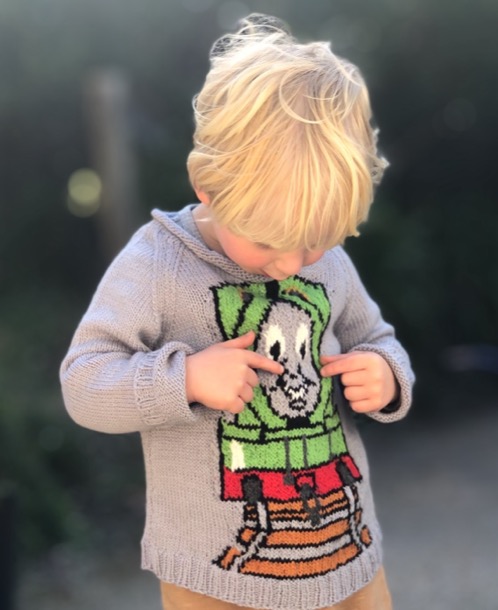
Then Bluey:
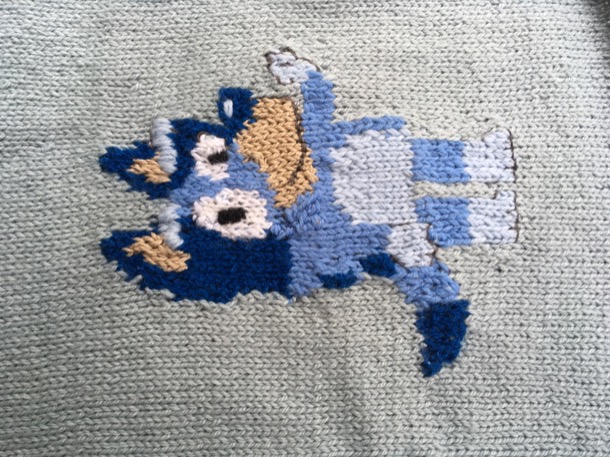
Optimus Prime:

And, the most recent, a Minecraft T shirt, with, by request, a Sniffer:

THE ACCIDENTAL CRAFTIVIST.
In 2013, Chris and I became involved with the community protest against the building of a McDonald’s in Tecoma.
Over time, this evolved into groups of protestors spending many hours standing holding signs on the main road, and maintaining a vigil at the back of the building site.
My favoured place was sitting at the back gate, with a camp chair. Of course I took my knitting.
Here is a typical scene from “the site” at that time. The police were frequent visitors. For a long time, there was stalemate. We were backed by the union movement, and no building contractor could be found.
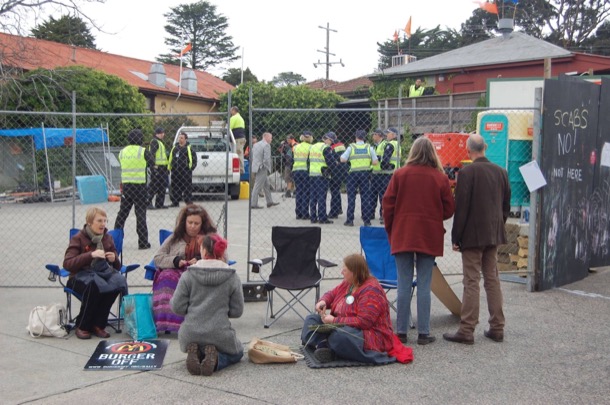
As the building progressed, we were no longer able to meet at the back gate. Every morning my friend Jan put up a little shelter we called “headquarters”. Every truck had to run the gauntlet of polite older women explaining why they should not enter the site.
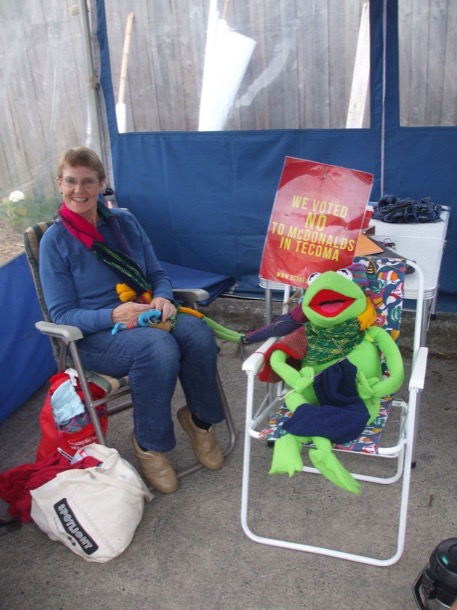
The Banner.
After a while, as we all finished off our various projects, we began knitting squares with all our scrap wool.
We became a group of close friends, and called ourselves The Picket Knitters.
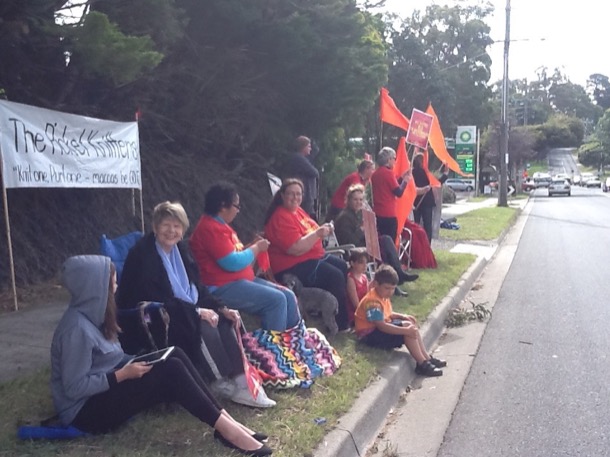
As our movement became more and more well known, we had people from all over the place sending squares. We embroidered the place of origin on some of them. This one came from Cairns.
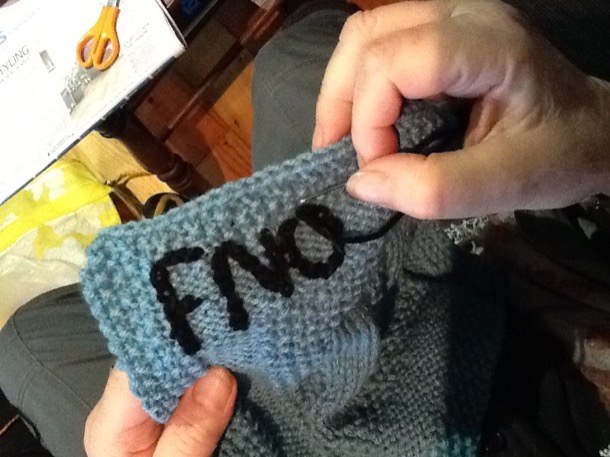
Eventually we put all the squares together, and made it into a banner.
By the time we had the official launch of the banner, the building was under way. Here, the knitters crouch behind the road barrier, with crossed needles. Sue and I are both there.
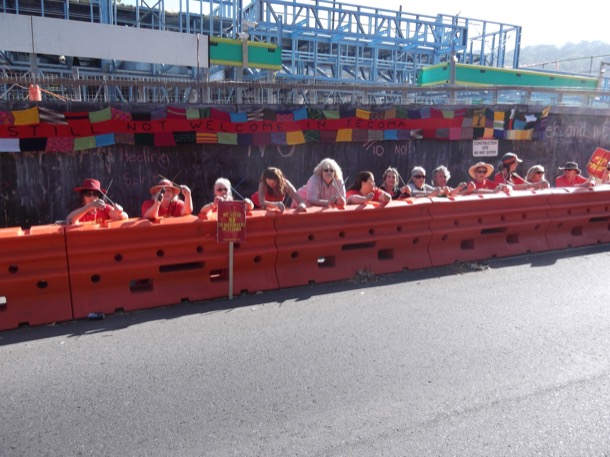
The local papers loved us.
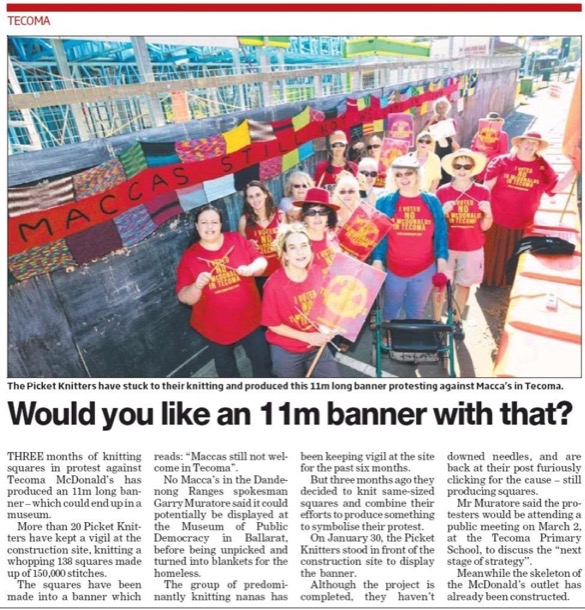
Eventually, we presented the banner to our fellow craftivists, the Knitting Nanas of Toolangi. We reconfigured the squares and it became part of their Great Tree Project.
Here it is decorating the base of one of the precious Mountain Ash trees.

Gnomageddon
“Gnome Maccas”, derived from our “No Maccas in Tecoma” slogan, spawned a range of Gnome related activities. The biggest of these was our Gnomageddon, where the community gathered to break the Guinness Book of Records record of the most people dressed as gnomes.
I made all our knitters a red gnome hat.
Here are a few Picket Knitters in their gnome outfits.
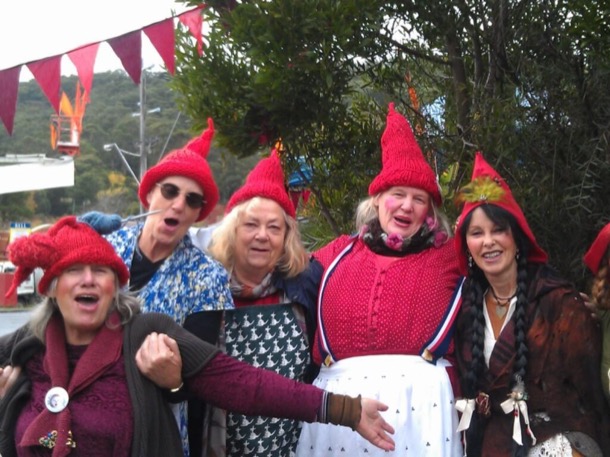
And even a gnome rat.

Once the McDonald’s in Tecoma opened, albeit usually deserted and initially the lowest grossing McDonald’s in the country, we continued to meet at each others houses.
In 2016, we all created tea cosies and entered them in the Fish Creek Tea Cosy Festival.
Here is my offering:
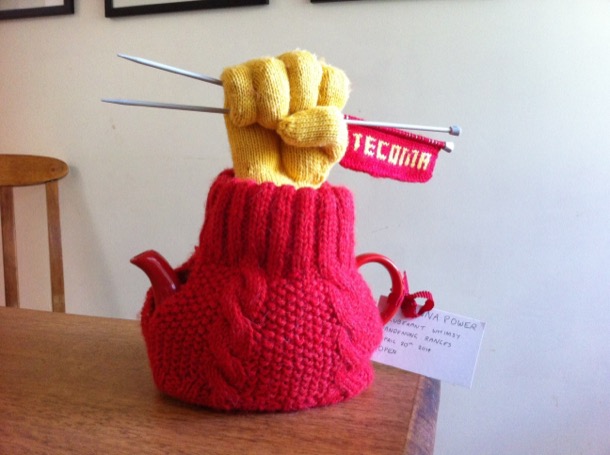
The local paper chased us up to find out what The Picket Knitters were doing now.
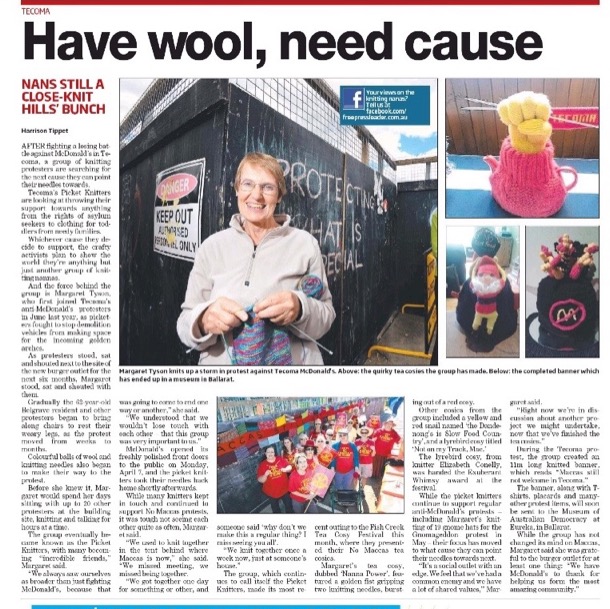
This article prompted a phone call from a Melbourne Radio Station shock jock. Based on the tone of the article, he was very excited by the idea he could paint us as serial protesters for hire. I very much enjoyed my live interview with him, where his aim was completely transparent. When he pressed me for possible “causes” we might move on to, clearly hoping for left wing politics he could ridicule, I listed a range of completely apolitical charities, and played my role of “just an ordinary person” who “of course didn’t want a McDonald’s so near the forest”.
We no longer knit together, but we do meet every fortnight for a lavish lunch and a long chat about how to put the world to rights.
ALICE
This is Sue and Margaret in about 1955.
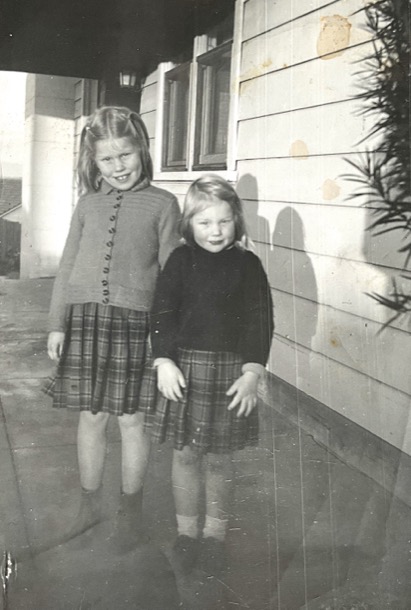
Two small girls, sisters, on a cold winter day in suburban Box Hill in the nineteen fifties.
What does it tell us of life then and the different world we lived in?
From the bottom up, starting with our shoes: We both are wearing lace up shoes, Margaret’s may have been hand me downs. She had a lot of these, as clothes were an expensive item to buy. Mine were my school shoes and these shoes were our one pair: worn to school or kinder, to play, to visit and to church on Sunday. On wet days we wore galoshes over them. These were rubberised over shoes, that fitted over the shoes, saving both feet and shoes from a soaking.
The life of our expensive shoes were prolonged by being reheeled by our father using his shoe last.
He also put little u shaped metal clips on the outer edge of the heel and toes to prevent wear on those vulnerable areas. Amazingly, looking for photos of ‘vintage ‘heel and toe clips I came across a host of You Tube videos of how to fix them to your shoes It is still a thing on leather soled shoes. The two worlds meet.
Our cotton socks were much the same as today. We only had a few pairs. Above these ankle socks were bare legs, in the depth of winter. We both remember cold legs on winter mornings: little girl plump legs with that blueish pink tinge.
At least we had woollen skirts that kept us warm. Once again only one, and home made by our mother. They were always tartan, pleated and then sewn to a cotton calico bodice.
The cotton bodice was at times a little grubby, but was usually hidden under our hand knitted woollen jumper or cardigan. Under this was a singlet possibly woollen. Margaret remembers shocking our mother. School Open Day was quite a big deal with many, mainly mothers in attendance. Mum walked into class confronted by an oblivious Margaret without her jumper on, as it was hot. She was sporting her tartan skirt, complete with a grubby bodice held up at the shoulder with a large safety pin. What a sight!
We think we wore these garments for almost everything we did during winter, from roller skating to going to school. We vaguely remember having twin sets to wear for best with the pleated skirt and a winter coat and raincoat, all worn with.our school, lace up shoes.
And then there was summer sewing.
It’s the week before Christmas. School has broken up, and four children, a dog and a cat clutter up the house. It’s hot, and there is no air conditioning. Not even a fan.
Christmas presents are partly organised but still require a few trips to Chadstone Shopping Centre.
In the garage, Dad is tuning the car, ready for its two hour trip to Shoreham camp. The tent and most of the camp furniture has already been set up, but a trailer full of odds and ends is still to be packed.
The plan is to leave early on Boxing Day.
In the centre of the house, between the kitchen and dining room, is a scene of colourful mayhem.
The sewing machine runs all day and into the night.
Cotton fabrics have been bought, perhaps at a discount fabric shop. They are spread out across the floor, with well used pattern pieces pinned to them. Mum crawls across the fabric cutting out multiple pieces. She makes enough shorts and tops for us each to have a set to wear and a set in the wash. There are hand-me-downs involved for me, the second child.
We find it hard to remember the details of her sewing. How were the seams finished? Were the necklines bound or faced? The hems were all hand sewn: we can both remember hems coming undone.
She didn’t cut the thread ends as she went, there were always multiple loose threads to trim off at the end.
In this photo, taken about 1958, little Sue and Margaret stand in the centre, in that year’s shorts and striped tops.
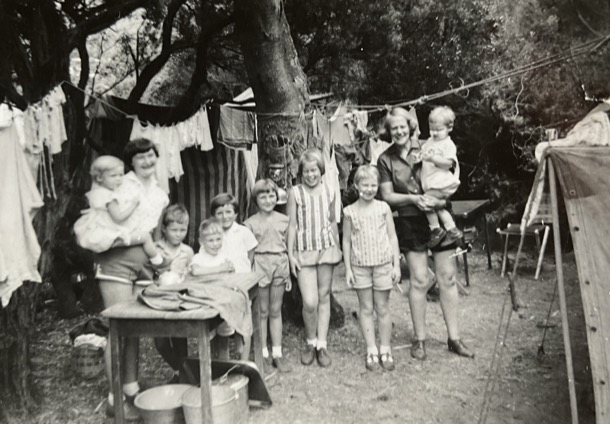
AUNTIE BERT
Our Great Auntie Bert was an important person in our lives and those of our extended family. We have fond memories of her kindness, but it was only as we researched the position of sewing in our family history, that we fully appreciated her dressmaking legacy. We knew that she had had a career as a dressmaker, and had run her own business. She passed on her dressmaking and fitting skills to Margaret and me, and to our mother and Auntie Marge, but we had not appreciated the thoughtfulness and kindness that was an intrinsic part of each garment.
My crushed strawberry viyella dress and Margaret’s mustard yellow check one epitomise this:
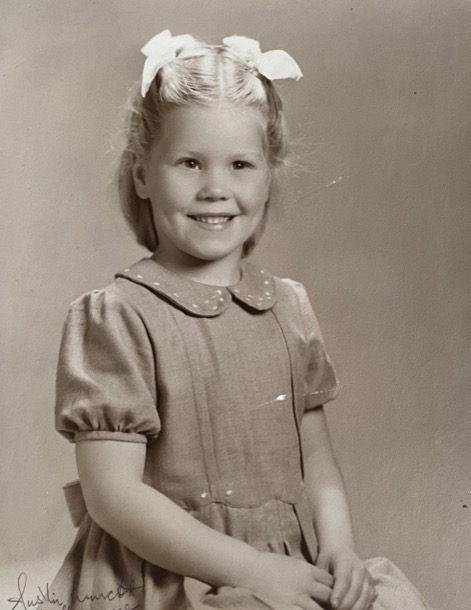
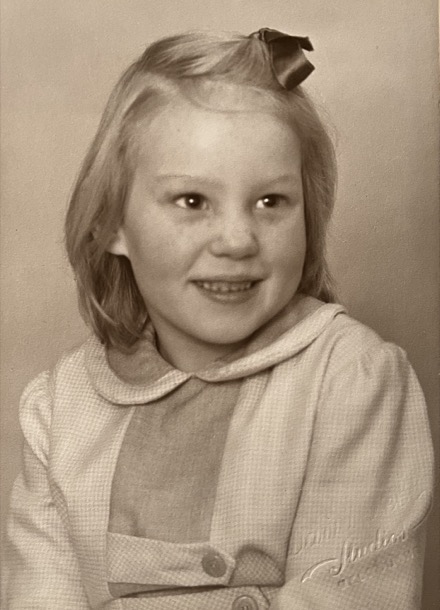
Now that I am sewing more, I can begin to appreciate the level of skill and detailing involved in the creation of these winter dresses. Margaret’s dress is made in a mustard check with a plain contrast panel and collar insert, all beautifully sewn and constructed. My dress, in one colour has detailed pleating on the bodice and skirt and a scalloped edge stitched waist that would have been fiendishly difficult to sew. Hopefully Auntie Bert would have enjoyed creating these “best” dresses, in which her love and care for her family are so evident.
Auntie Bert was also called upon to make many “best” dresses for the adult women of the family, some of them wedding outfits.
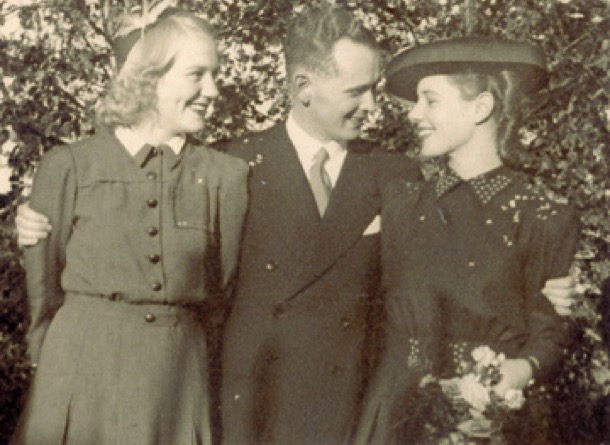
In my late teens when Auntie Bert was living in the flat behind our house, she made me a beautiful tweed winter overcoat , fully lined. I wish I still had it. During the process she taught me some of her tailoring techniques, for instance how to attach hair canvas to the collar , stitching it to ensure an even roll over.
During the last years of her life Auntie Bert lived with her sister’s family at the Cockatoo farm, as we explained in our post ‘Auntie Bert: A Sterling Character.’. During this time she was mostly clad in clothes she had made. In winter, she wore straight woollen skirts and layers of woollen jumpers and cardigans. In summer she wore a dress and cardigan, more often than not, covered by an apron. We never saw her in a beanie, which her sister wore constantly, even inside.
Sewing in many guises has been a feature of the lives of women in our family for generations. Probably there are more stories even further back that we are unaware of. In this short story we have gone from treadle machines, paper patterns and sewing for necessity, to sewing for pleasure and sewing as a form of protest.
Hair
This post therefore is about hairstyles, but we have allowed ourselves a much broader scope.
ALFRED JOHN COATES
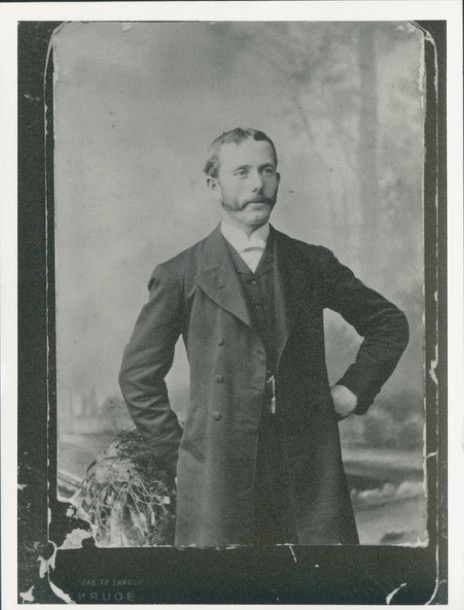
Alfred John Coates, born in 1857, was probably in his late twenties when this photo was taken. He was our maternal great grandfather and was a Methodist Pastor for most of his working life. In this photograph Alfred is a young man in prime of life, dressed in formal dress and sporting the fashion of the day: mutton chop whiskers, carefully manicured to join artfully with the moustache. A man of destiny, the misty ‘bush’ behind him, he stands erect, eyes on the future. At this time Alfred was apparently a boiler maker in Ballarat.
Men’s facial hair trends were changing rapidly in the late 1800s. Long beards were out and clean chins and cheeks and a well-manicured moustache were in. To achieve this look men would need to go to a barber two to three times a week or shave themselves.
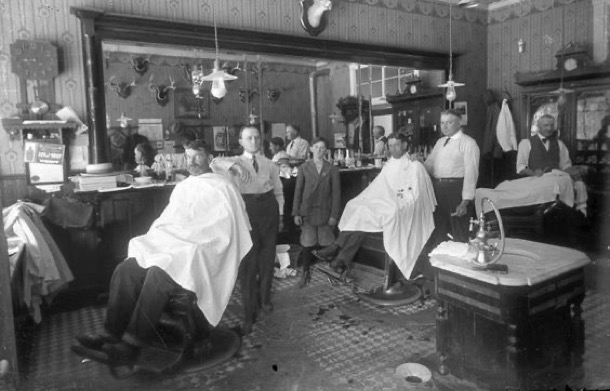
Shaving oneself may have been a financial necessity at times but it could also be a dangerous procedure. Shaving was done with a straight steel razor that required care and expertise, not only in the act of shaving the gentleman, but also in the care of the blade. To keep it sharp, the blade was rubbed against a leather or canvas strap before each new shave. As well as the blade, shaving soap, shaving brushes, combs, oils and wax were essential items to achieve the desired effect.
Having a photograph taken in a studio was a special occasion and a relatively expensive exercise. One can imagine that Alfred may have had a trip to the barber to ensure that he looked his best.
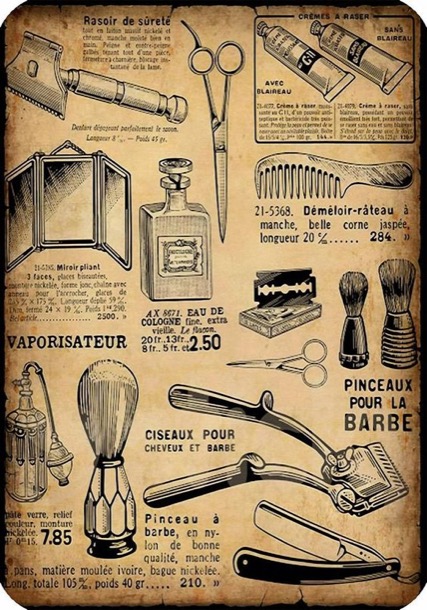
Safety steel razor blades that made shaving much easier were not invented until 1895 by an American business man with French heritage.
King C. Gillette invented a low cost blade that was easily replaceable and gave men safety and the freedom to achieve the look desired themselves.
EMMA ELIZABETH DAU
Alfred married Emma Elizabeth Dau in 1888. He was thirty-two and she was twenty Maybe this photo was taken at this time:
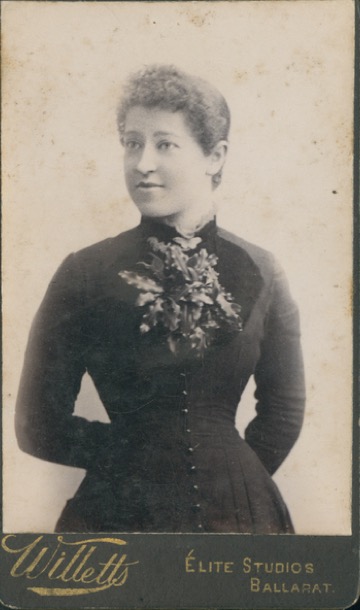
Emma is dressed in the style of the day, hourglass figure no doubt with a corseted waist as she gazes into her future with a determined tilt of her chin. Her hair is tightly curled at the front and pulled back into either a bun or pinned up plait.
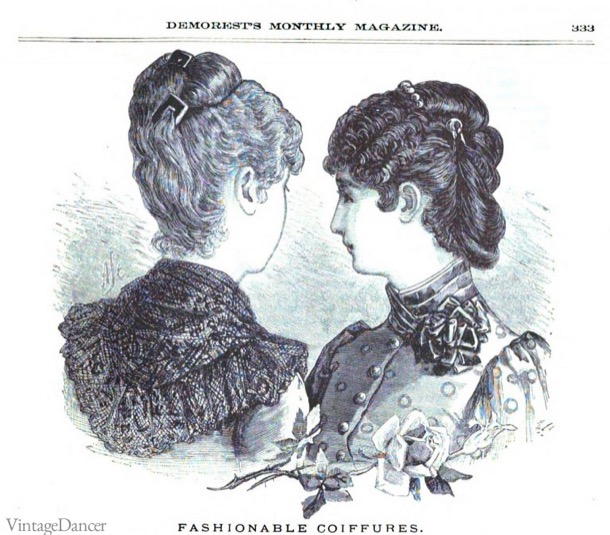
Unlike the men who had barbers to attend to their needs, there don’t appear to be many ladies' hairdressers. Women had many home implements and potions and maybe sisters and mothers helped each other with their hair.
Young Emma’s tight curls may have been created with curling irons. A curling iron consisted of a metal rod that was held over a flame or burning alcohol to heat it, before wrapping the hair around it. Hey presto, curls!
Later in life, Emma wore her hair in a more relaxed style, loosely pulled back from her face and pinned up into a bun at the back:
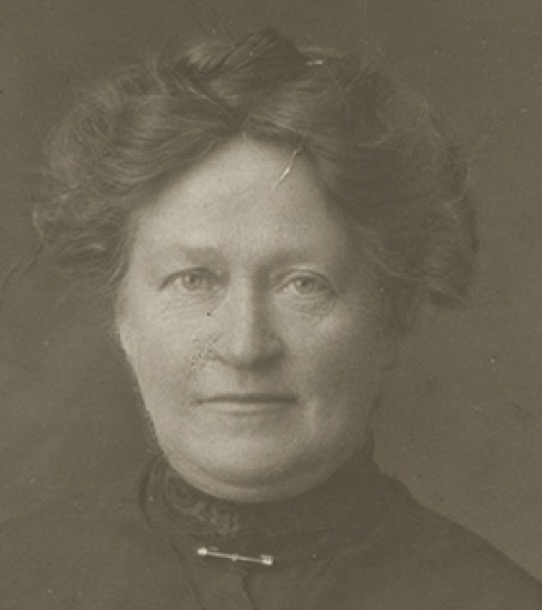
When this photo was taken, the height of fashion for women was to wear their hair with more volume at the sides. This was created by using clumps of hair leftover in combs and brushes, to pad out the sides. Emma would not have gone to these lengths in later life, but on her dressing table she would have had a brush, comb, hand mirror and china box, with a lid for the collection of hair caught in brushes or combs. We can remember our grandmother, Alfreda, also having these items on her dressing table. She wore her hair long all her life. During the day it was loosely tied back in a bun, brushed out at night, and the ‘ratts’ collected from the brush and placed in the china box. She then plaited her hair into a loose, single long plait and was ready for bed.
NINE DAU SISTERS
Emma Coates, was born Emma Dau. She was one of seventeen. The first nine of these were girls.
We have three amazing little photos of some of the Dau children. We have spent a long time staring at these images, noticing little details, wondering about the lives of these nine little girls.
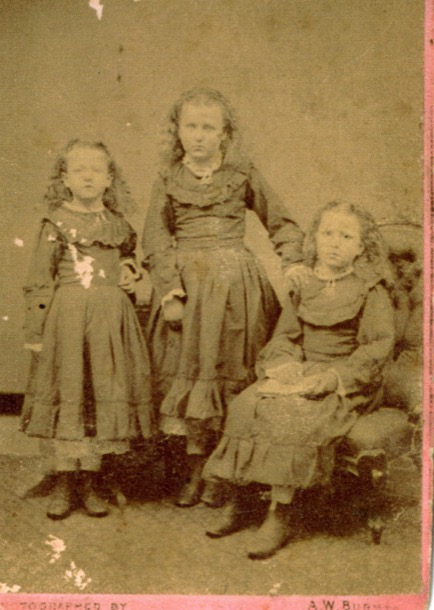
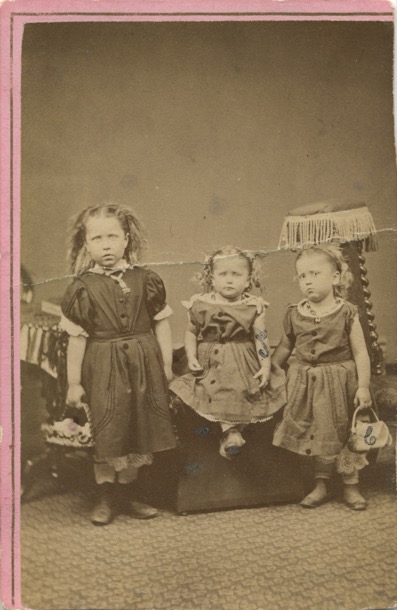

The first question we had was, "Were the three photos taken at the same time?". There is such a family resemblance, we weren’t sure at first whether they were different people in the three photos. The carpet gives away that they were taken in the same studio. On the back of one of the playing card sized photos, we see “one shilling per copy”. For context, at that time, a shilling was more than a day’s wage for a working man.
It seems most likely that the three photos were taken on the same day, and they are the nine oldest children, all daughters, of Joachim and Martha Dau, our great, great grandparents.
The photo of the three eldest has writing on the back:
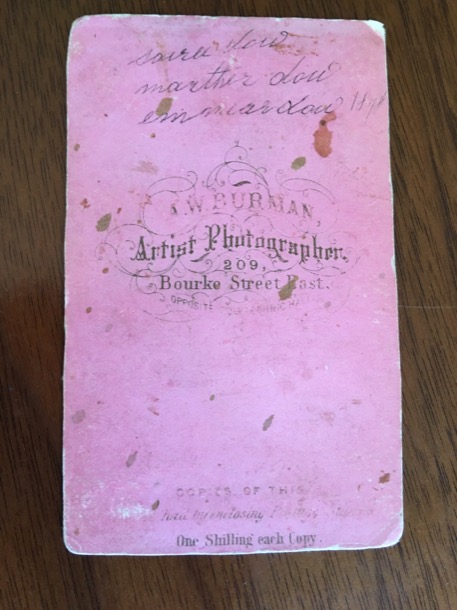
The fact that Martha is misspelt as “marther”, and that no capital letters are used, might be a clue. It was not our mother Alice, nor her parents. None of them would have made such a basic spelling error! The surname is listed as “Dow”.
If those names are correct, then these are the three eldest Dau children. Standing is Sarah, the eldest. the other two are Martha, known as Mishi, and Emma, our great grandmother.
Thanks to the Wandong Historical group, we have the details of nearly all the Dau children.
The next three girls are Bella, Jane and Sophia, followed by Alice, and two others, possibly Annie and Nance, although some sources have Annie and Nance as the same person.
There is no date on these photos, but there are nine girls. The nine first Dau children, all girls were born between 1866 and about 1878. This puts the date of the photos at about 1880, with Sarah, the eldest, aged 14 and the youngest aged 2.
The girls’ father, Joachim, had spelt his surname, Dau. We don’t know the exact date they changed it to Dow, but Frederick enlisted to fight in the Boer War as Dow in 1901, and Arthur, who became a professional soldier, changed his name by deed poll to Dow. The same anti German sentiment that caused the British Royals to change their surname to Windsor from Saax Coburg was no doubt responsible. And yet the Dau spelling persists alongside the Dow spelling, right up until 1929, when Sarah, the eldest wrote about her childhood. Our mother and aunt did not even know about the Dau spelling.
The photographer is listed on the back as Burman, 209 Bourke St Melbourne. The building is still there. This is what it looks like today:
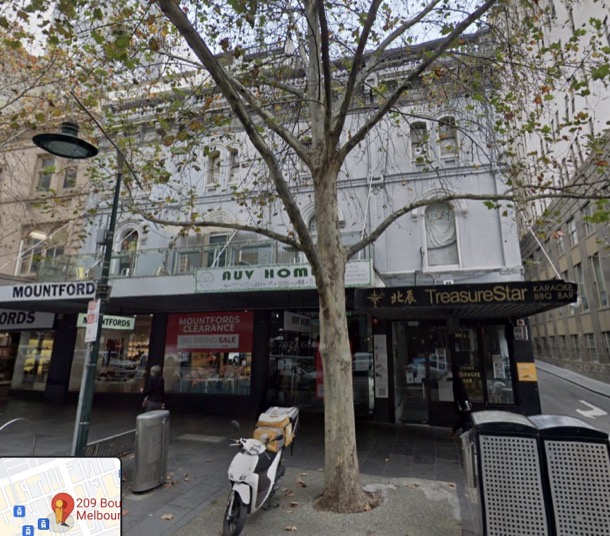
There are a number of old photos by Burman available on line, with that tell-tale carpet visible in some. This one, “Portrait of a Lady”, which uses the same chair as two of our photos, is from C1865.
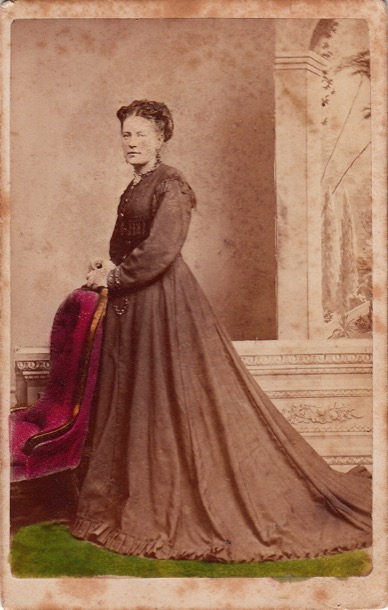
We picture the little farm girls, in their new dresses, in the big noisy city. They would have come on the train, to Flinders Street from Wallan, and walked the three city blocks to the studio.
The city streets would have looked like this:
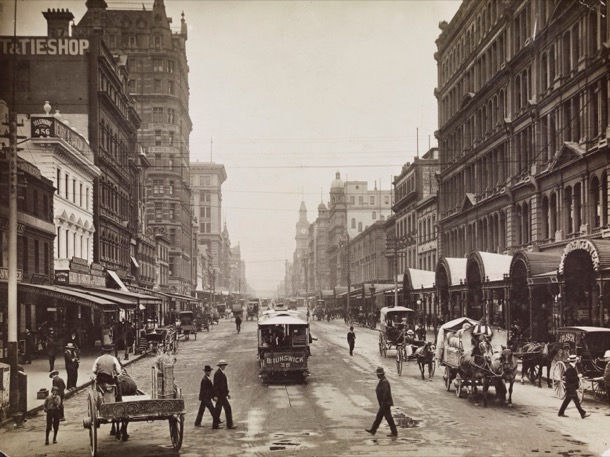
Their hair would had been in rags overnight. The curls in Sarah, Martha and Emma’s hair have been successful; the others less so. All of them have a ribbon holding their hair back from their face.
The dresses are interesting. The same fabric and pattern seems to have been used for the three eldest girls. Who made them? The next three also have a similar style. All have sturdy boots and frilly pantaloons. These outfits would have been worn to church on Sundays. Did they wear them for the train journey, or change at the studio?
The only other girl, born in 1887, preceded and followed by the seven boys, was Ethel. She wrote diary entries, still held by the Wandong Historical group. Ethel wrote about the boots, which are such a feature of these little girls’ photos. “the rough track across the paddocks and hills, two miles to the little school at Wandong. In wintertime, we had to cross many flooded gullies. We wore strong boots and I was often peeved, as I compared my strong shoes with the dainty ones worn by the other girls at school.”
It was quite an expense to provide boots for so many children.
Our appetite for finding out more about this family is well and truly whetted. We plan further exploration, including an excursion to Wandong.
THREE HOLM SISTERS
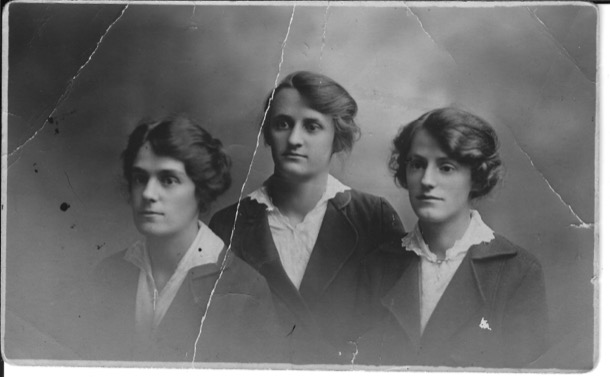
These three young women, probably photographed just before the first world war are (left to right) Alfreda, Beatrice and Berta Holm. Alfreda, our maternal grandmother, was the oldest of the three, perhaps just twenty at the time. The three sisters have their long hair swept back in gentle waves, to a loose bun or twist at the back.
We wonder whether they did the white work on their shirts? We know that Beatrice and Berta spent time working in Finders Lane, doing the white embroidery known at the time as “white work”. So much we can only guess at.
They all gaze into the distance: Alfreda with a determined steely gaze, Beat with a quizzical half smile and Bert’s beautiful eyes not quite hiding her vulnerability. We can only guess, as they gaze into a future where world war is imminent.
Alfreda wore her hair long all her life. We can remember her brushing her hair at night and putting it into a long plait.
TWO COATES SISTERS
It’s hard to be a younger sister, but our mother Alice, was the fairly plain younger sister of an extraordinary beauty.
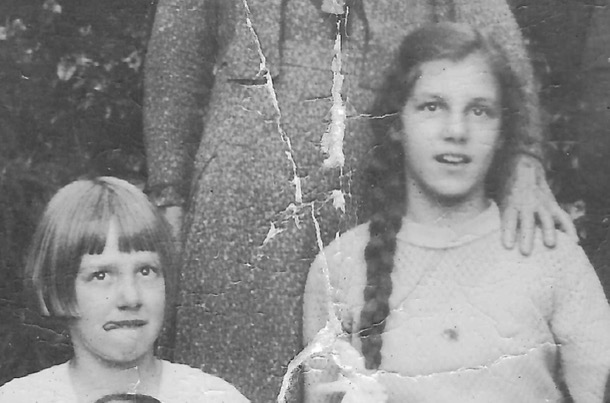
She didn’t have to deal with social media, but, when she was growing up in the 1930s, feminine beauty was important for girls.
Alice was an intelligent and able scholar, and, thank goodness, this was highly valued in her family. Her mother, Alfreda, had made sacrifices and fought for her own education. For their later secondary school, the girls were sent, at huge expense, to a city based secondary school, all the way from Croydon.
Only the wealthiest or most determined families sent their girls to school, after the age of fourteen. At McRobinson Girls’ High School, Marge and Alice were taught by, and shared classes with, the very brightest and best: future women scientists, lawyers and doctors, who would pave the way for our own generation.
But, from her school reports, we see that, while she held her own on the whole, Alice was not exceptional in that auspicious company. And she was crippled, probably her whole life, by a sense of inferiority.
And it is in their respective hair cuts from that time, that we see how the contrast between the two girls was accentuated.
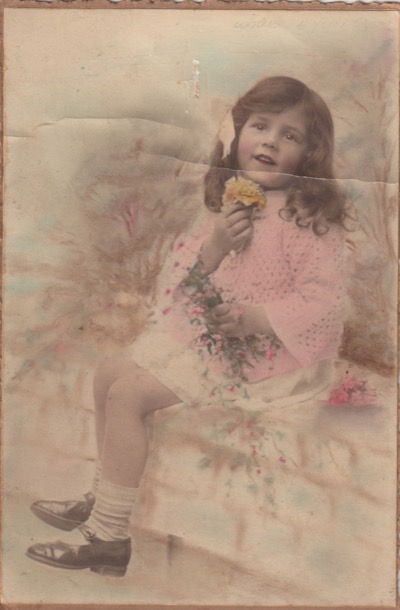
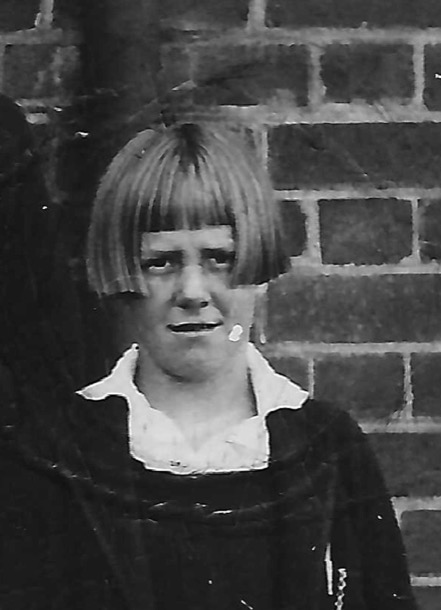
When I stare at those grainy old photos, at Marge’s lush locks, and Alice’s blunt, unfashionable short bob, and straight fringe, I cannot help but ask “Why?”. Why did Alfreda allow her younger daughter to wear such an unflattering style. Why was the difference in feminine beauty accentuated and underlined so prominently by the two hairstyles? How might Alice’s life have been different, had she been encouraged to make the most of her looks, as well as her brains?
Even as they began working life, both at Maribyrnong Munitions Factory, in 1939, the difference remained. Here Marge is on the far right, and Alice on the far left. Alice is nineteen and Marge twenty-one. But the choice of hairstyle reflects very different attitudes about their appearance:
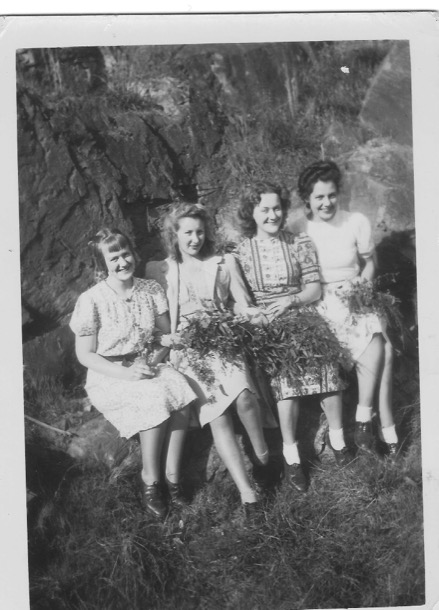
THE VICTORY ROLL
These two studio photographs of Marge are portraits of a beautiful young woman, but what does the hair tell us?
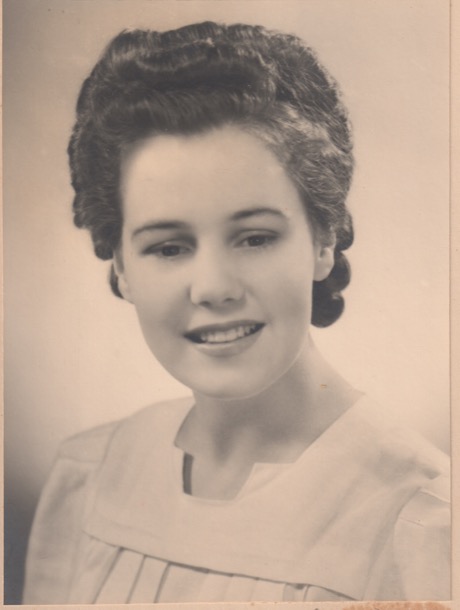
Here, a younger Marge still has very long hair, worn up now, as befitted a young woman who was no longer a child. Pretty curls and barrel curls were the look, and Marge had beautiful, wavy, very cooperative hair and was able to construct ‘the look’ very successfully.
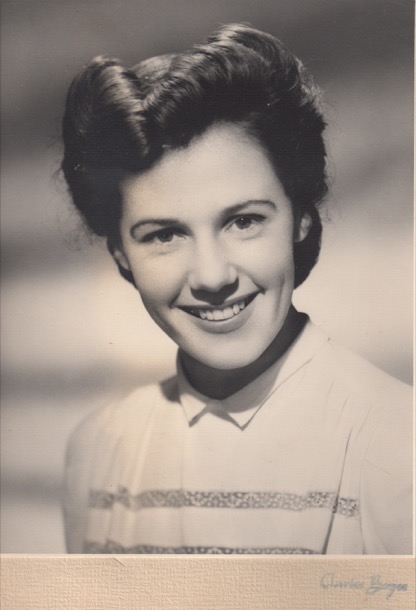
An older Marge, maybe just twenty, posed for this studio photograph as a young woman of the war years, in the “hottest” style of the time. This photograph shows a confident young woman with a job, and presumably many admirers.
During the war, particularly during the Battle of Britain, the ‘Victory Roll’ evolved as a very popular and flattering hairstyle. The style was based on an aerobatic manoeuvre performed by pilots to signify victory. The planes would spin horizontally in celebration. The ‘Victory Roll’ hairstyle would have been difficult to execute, so hours of practice and experimentation was required. The style has stood the test of time, as it is still popular today in ‘retro’ dressing. There are many YouTube videos available with full and detailed instructions.
‘THE SET ‘
After the second world war, women’s hair fashion was dominated by ‘the set’, often a weekly set. Some women did their own at home, but others, such as our mother Alice, went to their local hairdresser.
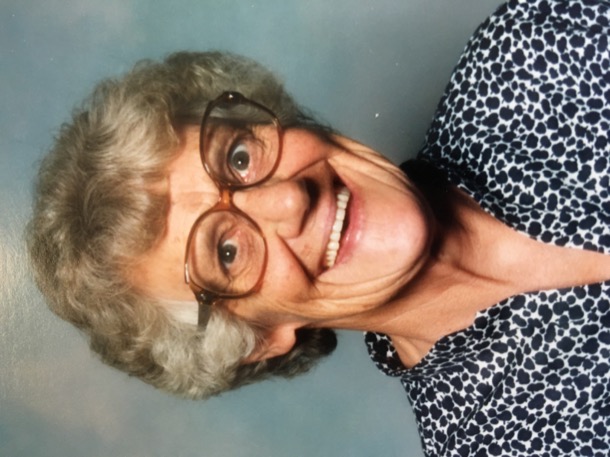
The set involved a headful of rollers, tightly wound on wet hair, then dried under a hood dryer. This often took almost an hour, so there was time to read or chat.
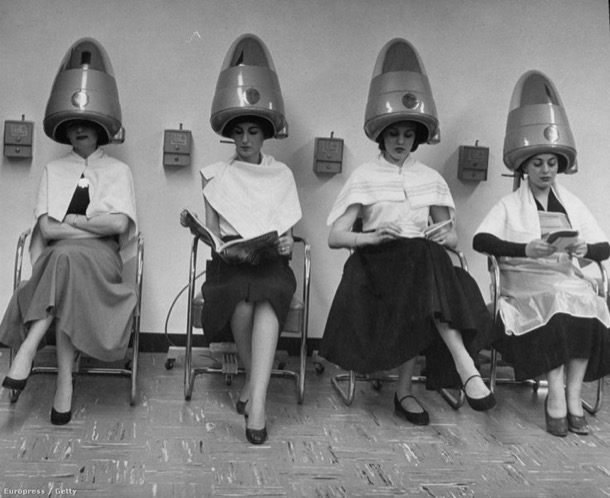
Through the ages, and the generations of our family, both sexes’ hair styles have been influenced by the fashion of the day. We have all had cuts, or not. We have curled and permed and coloured and bleached, with varied results.
Today, people are not rigidly restricted to one style, as they were in the past, but have any options.
The lyrics from the musical Hair says it all: .
‘Gimme a head with hair
Long beautiful hair
Shining, gleaming,
Streaming, flaxen, waxen’
Women's Work
Like women throughout history, most of the women in our family have had the primary job of parent and homemaker. Those homes range from simple pioneer cottages to majestic residences with grand staircases and sweeping verandahs. Nearly all of those women have also done paid work. And some of those who have not been specifically employed, have had supporting roles in their husband’s careers. Some jobs have been done by different family members across different generations.
None of our women have had traditional men’s careers, but, across the generations, we have covered a wide range:
AGRICULTURE (Dairy maid, Famers’ wives)
HEALTHWORK (Doctors’ wives, Aide, Occupational Therapy Assistant)
HOSPITALITY/TOURISM (Publican, Office Administraion, Horse Trail Guide)
RELIGIOUS SERVICE (Lay Preaching and other good works, Nun)
ADMINISTRATION (Postmistress, Sales Administration Supervisor, Office Administrator)
THE ARTS/CRAFT/DRAFTING (Whitework, Semco and Dressmaking, Drafting and Drawing Office, Drafting, Drawing and Card production, Art and Craft Activities for At Risk Children, Set Design and Construction, An Artist in the Hills)
RETAIL (Grocer, Checkout Chick)
SCIENCE (Laboratory Work)
EDUCATION (Teacher)
AGRICULTURE
Dairy Maid
Our paternal great, great grandmother, Catherine Bourke, née Kelly, worked as a dairy maid in Limerick before marrying Michael Bourke, and emigrating to Australia, in 1839. When they arrived in Melbourne, their first job was managing a dairy farm in Moonee Ponds. Catherine’s knowledge and skills no doubt influenced this decision.
The “famers’ wives”
A recent (2022) Guardian article tells us that, until 1994, women could not list “farmer” as their occupation on the census form. Instead they were viewed as “non-productive silent partners”. Even today, when 49% of real farm income is contributed by women, our image of an Australian farmer is almost entirely male. This puts “farmers’ wife” in this exploration in a particular light.
Another interesting aspect of these women from our family history is the divide between the wealthy squatters and the ordinary people of the land.
Martha Rye, the “poor little thing”, whose story we told in the June 2016 post, was a “farmer’s wife”, as was her mother, Elizabeth. Both of these women had very large families.
Elizabeth, our great great great grandmother, had eleven children. We can work out quite a bit about Elizabeth from a newspaper story, written about her husband, Adam’s life. She had worked in service, as a housekeeper, before she and Adam emigrated to Australia, in 1848. She could read, but not write.
They grew potatoes and onions, first on a rented farm near Geelong, then on two acres in Broadmeadows. The whole family would have been involved in the farm work, especially at harvest and market times.
We know that Adam not only worked as a labourer on neighbouring farms, but also spent time away trying his luck on the goldfields. It would have fallen on Elizabeth and the children to keep things going on the farm.
Martha, Elizabeth’s daughter, was married to Joachim. They would have had long days on the dairy farm, Heather Farm, near Kilmore. We learned a bit about her from her daughter Sarah, born in 1866. We wrote about this in August 2016. Sarah wrote with sentimental nostalgia about milking the cows, Blossom, Peggy and Strawberry; feeding poddy calves; working the separator; and rearing seventeen children. But between the lines, one can see the massive workload.
Around the same time, our paternal great great grandparents, John and Johanna McCormack, bought their 15,000 acre grazing property, Balham Hill, fifty kilometres to the west. So, in a sense, Johanna was also a “farmer’s wife”. But what a different life! John, a Justice of the Peace, and community leader, had staff to attend to the farm. Their four surviving children all went to boarding school in the city, for their secondary education.
John’s father, also called John McCormack had also been a wealthy grazier. His wife, Grace, lived there at the property “Landscape”, at Tallarook, until her death aged 83. I doubt she would have thought of herself as a “farmer’s wife”.
Two generations on, Johanna’s granddaughter, our Auntie Tish, also married a farmer, near Warrnambool. Matt Rae was probably more of a hands on farmer than John McCormick, but he, too, was considered a grazier, and Tish’s life did not run to milking cows and feeding poddy calves.
Around 1950, close to the time Tish became a “farmer’s wife”, our mother’s aunt, Beat, and her husband Bill, sold their Surrey Hills grocery and bought land for a dairy farm in Cockatoo. The activities on this farm were similar to those at Heather Farm, a hundred years earlier: milking, feeding calves, working the separator. The difference in their lives is technological. An electric milking machine and separator, tractors, hay bailers, meant that they ran a dozen cows instead of three. And they had three grown children instead of seventeen. Nevertheless, they all had to work hard to make the farm pay enough to support them all. We wrote in detail, in our November 2017 post, about our childhood visits to this farm. There we described Beat’s pigs. This was her major farming contribution. She was not just a “farmer’s wife”, but actively involved in the decision making and physical work of the farm.
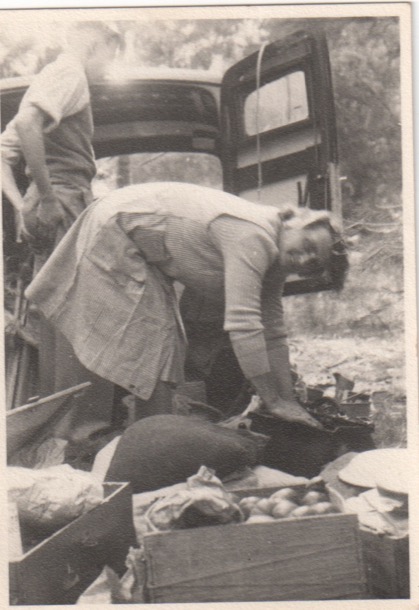
Auntie Beat
HEALTHWORK
Health work does not feature much among the women in our family. there are no doctors or nurses, that we know of.
Doctors’ wives
Our grandmother, Grace, and her daughter, Joan, were “Doctor’s Wives”. Wealthy, well connected, pillars of society, these women had no real job. In both cases, their husband’s surgery was within their house, but they were not required to deal with actual patients.
Among the women in our family, there are a few cases of unskilled health work.
Aide
Like so many women, our mother, Alice, “went back to work” when her youngest child was about ten years old, in 1966.
The only job she had had, since leaving school aged seventeen, was the wartime munitions work she had done at Maribynong, which today would have been called Lab Technician.
What skills did she have to draw on, apart from housework and parenting?
So her job as an “aide” at Lady Herring Spastic Centre was a low paid, unskilled one. She was assigned, with one other carer, to a “class” of Cerebral Palsied kids roughly the same age, none of whom had the ability to speak, and many of whom could not feed themselves. This was before the days of Communication Boards, so even the most able kids could not communicate much.
I, too, had a job at Lady Herring, after I finished school, and before I began the university year.
The centre was in Malvern, and Alice, and I, for the few weeks I was there, travelled by tram, along a very familiar route, down Riversdale Road.
There were a few qualified staff at the centre, physiotherapists, occupational therapists, but the program, such as it was, seemed to be up to people like Alice to devise. With the exception of the bus drivers, the whole staff, including the boss, was female.
The kids commuted on a special bus, and spent the whole day at the centre. Much of the time was filled with dealing with their physical needs, but there were excursions, shopping trips, walks around the neighbourhood, music sessions, and a memorable overnight “camp”. Although low status and poorly paid, it was stimulating, challenging work.
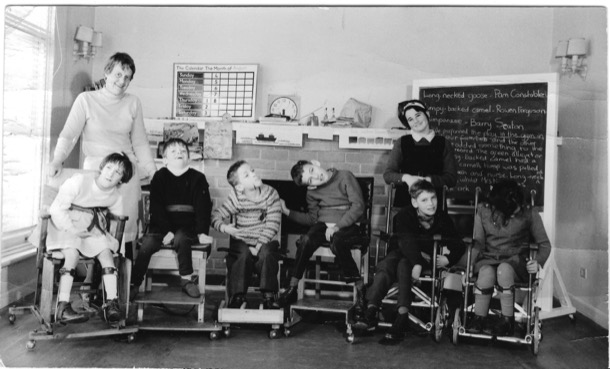
Alice with her "class"
Occupational Therapy Assistant
On the strength of my experience at Lady Herring, I did two other holiday stints as an OT assistant.
I worked with our OT friend Rikki, at Fairfield Infectious Diseases hospital for a little while. This was before HIV made it such an important place. My memories of Fairfield include the beautiful historic buildings; dozens of beds in a row, in the children’s Hepatitis ward; and the iron lung ward: people who had contracted polio as children and spent their life lying inside huge metal chambers that helped them breathe.
My job was mostly helping tidy up the activity room, and working in the ward with the Hepatitis kids: mostly bringing them things to do.
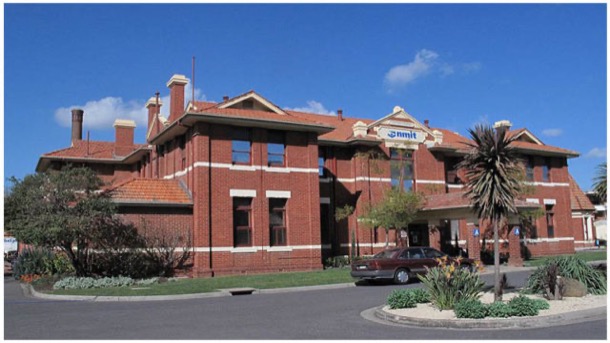
Fairfield Infectious Diseases Hospital
And then, during another long uni holiday, I worked at Montefiore (Jewish) Aged Care in St Kilda. It was perhaps 1970. Most of the Occupational Therapy “workers” there were volunteers: generally well off middle aged Jewish women doing their bit.One of those volunteers, who I remembered just as Mrs Hayman, later became Sue’s mother in law.
In my memory, the whole staff, except the doctors, were women.
In our centre, where the patients came to us, we ran activities like singalongs, bingo, games etc.
Many of our patients were post war immigrants from Europe, and some had been in Nazi concentration camps. It was the year that Melbourne emergency vehicles changed from sirens to “nee naw nee naw”, the same sound the SS vehicles had used in wartime Europe. When we heard the distant sounds approaching along St Kilda Road, we needed to be aware of some patients’ reaction.
I remember being told that that gentleman with his trousers barely held up with string, had been one of Melbourne’s top barristers. I still have the book called “Favourite Jewish Songs”, piano accompaniments I used for the singalongs I accompanied.
HOSPITALITY/TOURISM
Publican
Catherine Bourke, in her new home near Pakenham from 1844, helped with the establishment of Minton’s Creek Run, the farm in the Toomuc Valley, that they bought with another family. But in 1850, they bought the Latrobe Inn, on the main Gippsland Road, in current day Pakenham. Catherine moved out of the slab hut up the Valley, with her seven children, and became a publican. The inn became known as Bourke’s Hotel. Michael was still very involved with the family, and they had another eight children, but it was Catherine who ran the hotel.
As well as a stopping place for travellers, Bourke’s hotel was the local post office, and a hub for the community.
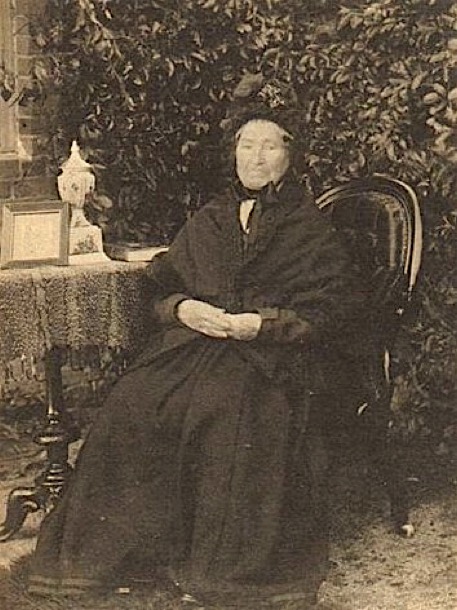
Catherine Bourke
Horse Trail Guide
Catherine’s great, great, great, great, great niece Eliza, one hundred and seventy years later, also moved to the country to start a new job in tourism. Seeking a change from office work, Eliza moved to Mansfield to work for Hidden Trails by Horseback. This company runs trails in the Victorian High Country and also at El Questro Station in the Kimberly.
In Eliza’s own words her job entailed the following:
Up at the crack of dawn. Run the horses in. Feed the ones we are working that day. Brush and saddle the horses needed for the rides.
Determine the guests riding experience, match to a horse. Sign indemnity forms, Go through basics (stop start turn etc) and then lead the ride out, float in the middle of a big group, or tail the group at the back.
We go out on four rides a day:
*AM 2 hour ride (around the station)
*Kids intro ride (around the paddock)
*1 hour loop (around a different part of the station which includes the deep moonshine creek crossing)
*PM 2 hour ride (incorporation of the 1 hour loop with a look out stop where we would take a pack horse with drinks and nibbles and tie the horses up and have a sit down)
In between those rides we feed lunch to the horses working. Then back to the stables in the afternoon, Unsaddle, wash down and tip out the horses. And then do it all again the next day. Shuffling them around in different paddocks so we could keep them all in work.
There was 40 horses total.
Long days. Great experience.
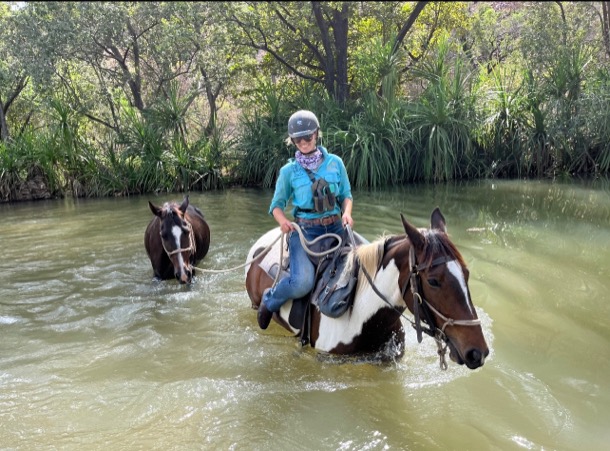
Eliza at El Questro
RELIGIOUS SERVICE
Lay Preaching and other good works
Both our mother Alice and her maternal grandmother Emma Coates (née Dau) were staunch protestants and indulged in a little lay preaching and good works.
Emma Dau, one of seventeen children, was married to Alfred Coates, who was a Wesleyan Methodist Pastor. Emma’s married life consisted of raising a family, and her duties as the Pastor’s wife. Family stories tell of her devotion to these duties and of her riding around the parish on a push bike.
At some stage in her life, when our mother was still a child, Emma also became a Home Mission Sister and was known as Sister Bessie. As a Home Mission Sister, Emma wore an impressive uniform, that is described vividly by our mother and Auntie Marge, who as children were very impressed by this formidable woman. Here they are discussing her:
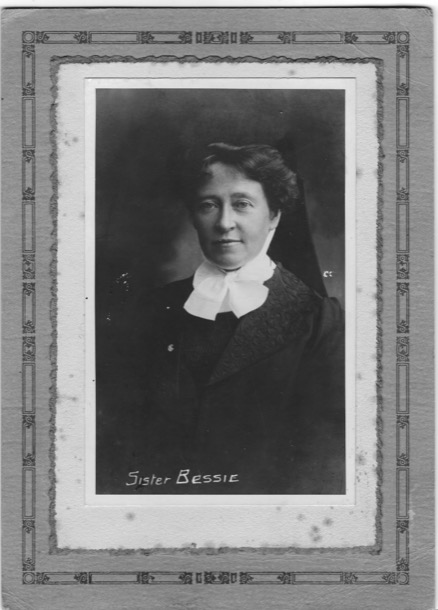
Sister Bessie
Sister Bessie worked at the Methodist Home Mission in Brunswick Street Fitzroy, in the 1920s and 30s. Sister Bessie’s work with the ‘fallen women’ and the poor, in the slums of Fitzroy was also vividly remembered by Marge and Alice. Sister Bessie’s good works involved anything from delivering babies to rescuing unmarried mothers. All of this was carried out ‘in the slums’ and in ‘poor, dirty houses’. One story has it that Sister Bessie once took off her own petticoat to give to a poor woman who did not have enough clothing.
The slums of Fitzroy were indeed slums, with a reputation for dirt, filth, disease and crime, a fearsome place. Streets were unpaved, there was no running water in many of the crowded and small weatherboard houses and children often ran barefoot.
So bad were the Fitzroy slums, that in the 1950’s they were demolished and the population was moved to the Housing Commission Towers, still standing in Brunswick Street.
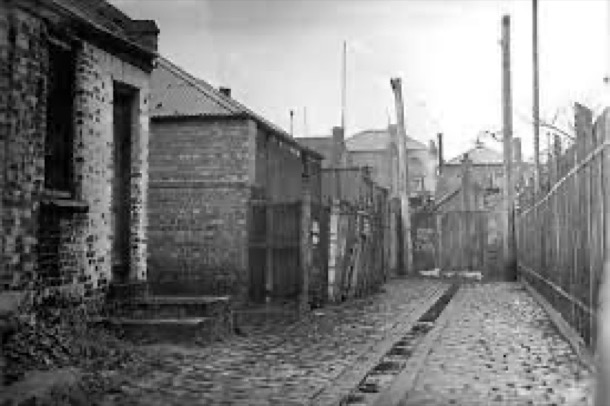
Slums in Melbourne
Sister Bessie also travelled within Victoria and Tasmania. She was lay preaching, called ‘deputation work’ and raising money for the Home Mission. Apparently she was a very good story teller and must have not only impressed her young grand daughters but also her audiences, as she regaled them with stories from ‘the slums’. So impressed was one small child, that she gave up her doll ,to be given to the poor children who had no toys.
Half a century later Alice stood in her grandmother’s shoes at the same pulpit of a small, now Uniting Church, at Jung in the Wimmera.
Alice was also doing ‘deputation work’ in a fashion, preaching about world poverty and inequality. She was also raising money for the Uniting Church’s fight against poverty. Alice mentioned that her grandmother, Sister Bessie, may also have preached here. Incredibly a member of the congregation remembered as a small child listening to Sister Bessie preaching and telling stories. She said,“She was a wonderful story teller.”
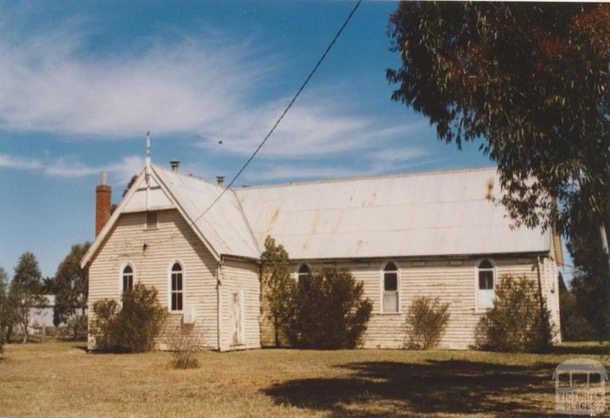
Jung Methodist Church
The Nun
We grew up with stories of a nun in the family but knew no details. With the assistance of Google, we now know that Frances Bourke, [1883-1964] Jim’s Great Aunt, joined the Presentation Sisters, probably as a young woman, and became Sister Magdalen.
Presentation Convent was founded in Windsor in 1873 ,after a request by the Parish Priest for sorely needed teaching staff at St Mary’s school.
We are intrigued about Sister Magdalen and her role. Was she a teaching Sister or did she have another role at the Windsor Convent? Did she spend her life in the Order? Watch this space, hopefully more to come.
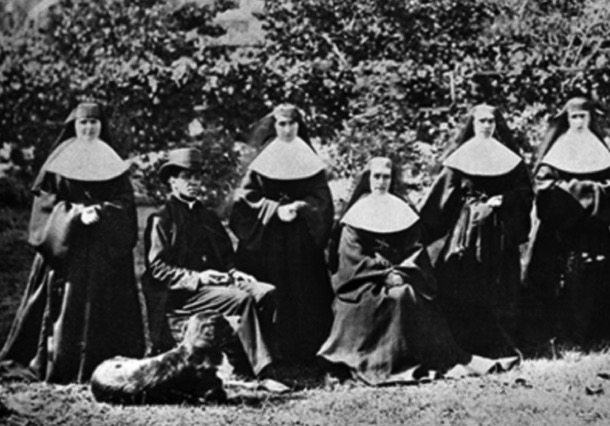
Presentation Sisters
ADMINISTRATION
Administration is part of many jobs, often the least pleasant part; writing reports, managing co workers, attending meetings, communication, ordering supplies, keeping records. These tasks are familiar to many workers.
Postmistress
In 1859 Bourke’s Hotel in Pakenham also became the community post office, ten years after Michael had bought the license. He became the founding post master of Pakenham. After his death, in 1877, Catherine became the Pakenham postmistress.
Up until 1901, each of the colonies operated their own postal service. After Federation, they all merged to become the Postmaster Generals Department (PMG).
Cecelia,(Cissy), Catherine’s youngest child, who never married, continued the role after Catherine’s death in 1910.
The job of postmistress would have involved taking sacks of mail to and from the Cobb and Co coach, later the train, and sorting it for people, who would come in to collect their mail.
Over time, the job of post mistress also included a savings’ bank, money order office and telegraph station; quite an important role in the local community.
Sales Administration Supervisor
But for a proper administration job, Tessa is our woman. Her job at Kenworth Trucks is to project manage the outfitting of each truck. She manages a team of people who put 22 trucks per day together, to the specifications of each customer. Keeping all the balls in the air, making sure everyone is gainfully employed, smoothing relationships with customers and between workers, maintaining records, supervising departments. It’s a very large and stressful job.
Office Administrator
Another organised young woman is Eliza who has also worked in office administration, at Nautilus Training and Curriculum, the company founded by her dad, Ian.
THE ARTS/CRAFT/DRAFTING
Whitework, Semco and Dressmaking
Three of our women worked in the textile industry, a generation apart. Both Great Aunts Bert and Beat and our Auntie Marge were involved in the embellishment of textiles with embroidery, and in dressmaking.
In our post on Auntie Bert, ‘A Sterling Character’, in March 2019 we explored ‘Whitework’. Whitework embroidery is the general term for hand embroidery worked with white thread on white fabric. It was used on many household items from babies’ bibs and tea towels to under clothes. Bert and Beat who, as young women, worked in this industry, probably worked in Flinders Lane. At this time it was the centre of the “rag trade”.
Auntie Bert, being unmarried, needed to continue in the workforce, but also be available to help her elderly parents with whom she lived. A talented and resourceful woman, she started a dressmaking business, working from home. Although self taught, her reputation for fine tailoring and expertly fitted ladies’ wear soon spread amongst the ladies of Camberwell and Surrey Hills. As her clientele increased and business grew, she had to move to bigger premises, and Bert leased space for a workroom and office in Riversdale Road Camberwell. This business is also described in our post ‘ A Sterling Character”
Drafting and Drawing Office
Our Auntie Marge worked in a number of drafting and drawing offices during her working life. After her short stint teaching, Marge began work in a drawing office in Collins Street, and then, during the war, moved to the drawing office at Maribyrnong Munitions Factory where Alice also worked. In 1941 Marge moved again, this time to the drawing office at ICI.
Later in life, Marge used her artistic talents at Semco, designing patterns for embroidery transfers. The designs were created as line drawings and printed onto tissue paper transfers, to be sold to women to embroider for items for the home, or as gifts. The transfers were ironed onto cloth after which the item could be embroidered accurately following the design. Margaret and I can remember embarking on an Semco embroidery project that I don’t think we finished.
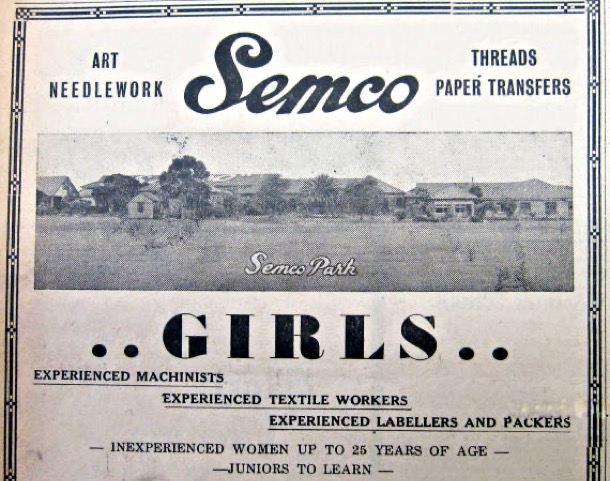
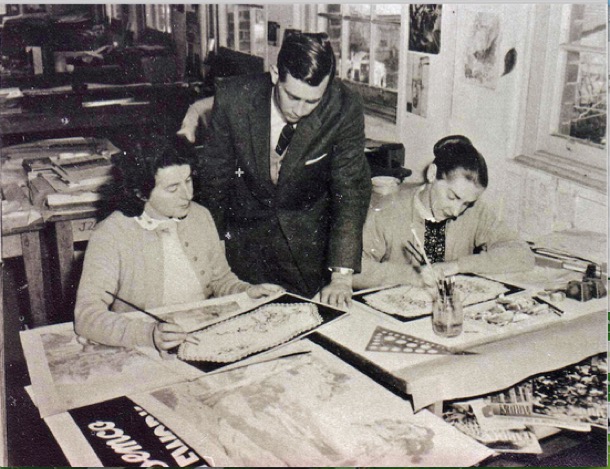
Semco Workroom
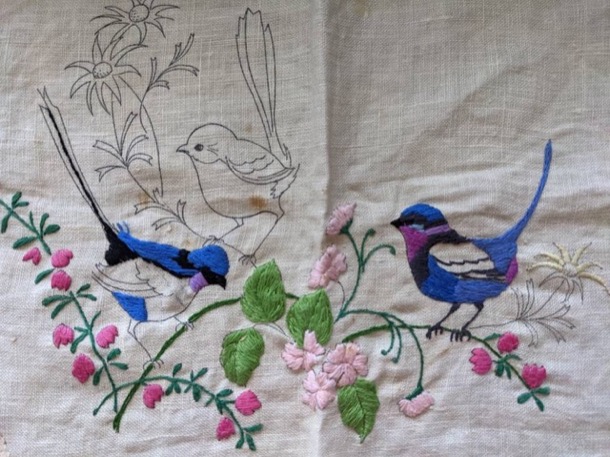
Typical Semco Embroidery
Designs subjects were flowers and animals, both European and Australian, cute houses, toys and even landscape scenes. Amongst the many items destined for embroidery were doilies, tablecloths and serviettes, tray cloths ,handkerchiefs, babies’ outfits and children’s clothing.
Margaret and I can also remember visiting Auntie Marge at Black Rock and seeing her designs on a big drawing board. A working mother was a novelty for us, as our mother did not work outside the home.
The Semco factory and workshops located in Semco Park, Black Rock, was quite a progressive company and treated its employees well. They paid award wages to women, and provided recreation facilities for the staff, including six and a half acres of garden and lawn for their enjoyment. It was a large employer, as not only were the designs created and printed, but the embroidery cottons were also spun and dyed.
Marge worked for Semco as a part time employee, and at the same time studied Interior Design at RMIT. Both were unusual. For many women of her era, part time work outside the home was difficult to find, even once children were at school. Marge was fortunate to have Semco in her area and for it to be accessible on public transport. This allowed her to work there for many years, while pursuing her life long interest in further study.
Drafting, Drawing and Card production
Marge worked in a number of drafting and drawing offices during her working life. After her short stint teaching, Marge began work in a drawing office in Collins Street and then, during the war, moved to the drawing office at Maribyrnong Munitions Factory where Alice also worked. In 1941 Marge moved again, this time to the drawing office at ICI.
In between jobs outside the home Marge, like her Aunt Bert, started a business from home. Using her artistic skills and her design experience at Semco, Marge launched a greeting card business. She designed and screen printed the cards, packaged them and sold them to shops specialising in handmade original work.
Art and Craft Activities for At Risk Children
From this heading, it is obvious that this position could be fraught with difficulties. As a nineteen year old I was blissfully unaware of the worlds these children came from. Orana was a Uniting Church children’s home for at risk children and ‘orphans’. I remember mostly a group of cardigan and jumper clad children in skirts and shorts, traipsing into a linoleum floored space to participate in whatever I decided to do. I don’t remember anyone checking the activities, or that I had to run them past any of the staff. Some of the activities were very, very messy, but the children willingly helped me clean up. The confronting and difficult part of this job was not the behaviour of the children, but the heavy prevailing air of sadness in that place.
Set Design and Construction
Lois learnt woodworking from her dad. Together with her design and craft skills, she developed her “Top Props” business, designing and creating stage props. For instance, Deirdre’s Tappers’ concerts would not have been the amazing spectacle they were, without Lois’s colourful props.
An Artist in the Hills
Through her meticulous fine drawings and paintings Katherine explores a fantasy world inhabited by little creatures and characters, who are at home with spiderwebs and toadstools or nestled under gnarled old trees . Working from her house and studio in the Dandenongs, she is pursuing her interest in children’s book illustration.
RETAIL
Grocer
Our Great Aunt, our grandmother’s sister, Beatrice Morris (nee: Holm) owned a grocer’s shop in Maling Road, Canterbury, for a number of years. Bill Morris had previously worked at Lawson’s Grocer in Middle Camberwell , so having experience, this was a logical move. We are not sure how long they were in Maling Road but presumably Auntie Beat helped in the shop as well as raising a family of three boys. It must have been reasonably profitable, as during this time they built a house in Balwyn, and then sold the business to buy the farm, Sefton Park.
“Checkout Chick”
Anna, Beatrice’s great, great niece, is the only other woman in the family who has worked in retail, and this too was in grocery shop: the Renaissance Supermarket, Hawthorn, in the 1990’s: it was a supermarket of course. At sixteen Anna was keen to have a part time job and earn her own money. Her position was ‘checkout chick’, working on the register, before scanning of prices using barcodes was all entirely automatic. For instance, the checkout chicks had to memorise the PLU code for all the individual fruit and vegetable items, and this had to be entered on the register, manually.
SCIENCE
Laboratory Work
After the horrific use of chemical warfare (gas), on the European battlefields during the 1914-18 war, many countries began to work on ways to protect their populations from gas warfare.
Australia began its own “Chemical Defence” research program in 1926 at the Munitions Supply Laboratories, in conjunction with Melbourne Uni. They developed and assembled “respirators”.
By the time the second world war began in 1939, scientists were well advanced in this work. In 1940, over half a million respirators were manufactured at Maribyrnong Munitions Factory, and more than 500 people were employed there.
Our mother, Alice worked there, in the microscope section, testing the penetration of gas that came through the filters. When she would describe this work, she would indicate tapping and counting as she stared down the microscope. She had studied Year 11 Chemistry the year before she started.
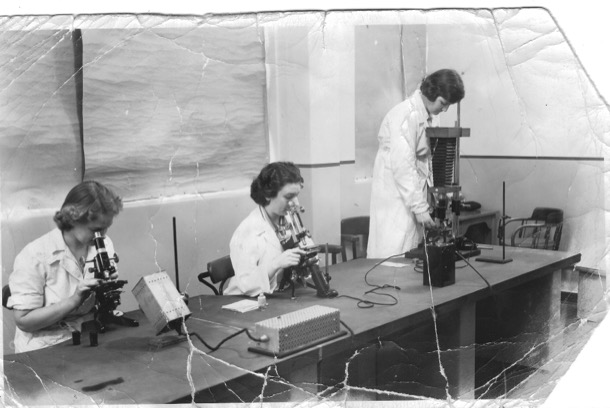
Alice, left, working at Maribrynong
EDUCATION
Teachers
At least five of the women, in four generations of our family, have been teachers, some primary, some secondary.
The earliest we know of is our Nana, Alfreda, who taught primary school, before marrying Alfred in 1916.
She had fought for a chance to continue her education after secondary school. There was not enough money for university, and so she went to Melbourne Continuation School, which later became Melbourne High School. Its focus was teacher training and thus, after two years, Alfreda became a teacher. Presumably she taught for about four years. Women had to resign from teaching when they married.
Our Auntie Marge, Alfreda’s eldest daughter worked as a teacher for a year, straight from school. She taught 50 five year olds at Balwyn North, as a “junior teacher’. She also went to RMIT three nights a week dong Fine Art, her real passion. She only lasted one year, having decided that she was not suited to teaching. Our mother, Alice, while not actually teaching, worked as a school librarian assistant for the last years leading up to her retirement.
The next generation is ours, and at least four of us worked as secondary teachers: Pauline for a few years, and Sue, Anne and I until our retirements. All three of us did our initial tertiary education, including teacher training, on “Studentships”, which provided free education and a small wage, in return for three years service, usually in the country. Sue went to Sale, Pauline to Portland, and Margaret to Moe. Sue and and I wrote about our first year teaching experiences in a post on October 28, 2015, filed under “Young Adults 1970s”
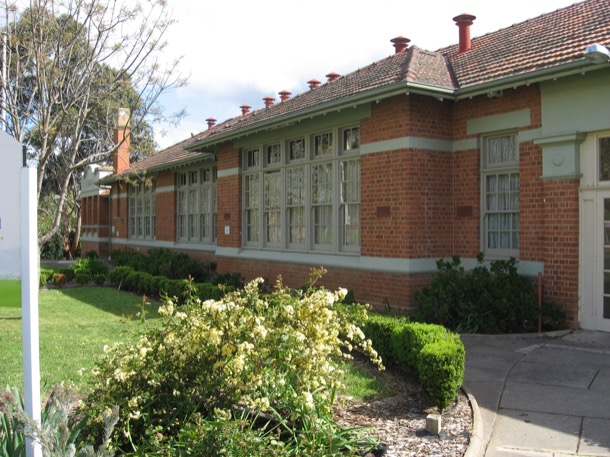
Sale High School
Of our own daughters and nieces, only Anna has taken on the mantle of teaching. She even completed most of a PHD in Education. Recently, in her mid forties, she has gone back to the English classroom in a secondary school, where she is thriving!
Such a lot of different job experiences, and yet, within relatively narrow parameters. No astronauts, truck drivers or plumbers.
And, it must be stressed, the most important job for almost all these women, over six generations and nearly a century, is that of parent and homemaker.
The Built Environment - Box Hill
We grew up in Box Hill South in close proximity to Surrey Hills where our family has had an association for five generations. 28 Moore Street was our family home.We all spent our childhood and early adult years there, before moving out on our own. The family ventured out into Box Hill in 1946 when our parents bought a block of land in a new subdivision. They paid one hundred pounds plus ten pounds in taxes. Jim and Alice also looked further out in Donvale, where, for a fraction of the cost, they could have purchased two acres of bush. Unfortunately this was not an option as there was no public transport and we did not own a car.
After the war, Box Hill South was opened up for new housing. The City of Box Hill revised its land valuation system and residential subdivision started to boom across the municipality. The small holdings of mixed farming and orchards, were quickly replaced by the unmade road network of the subdivisions. Electricity and gas were provided, but no sewerage until the 1950’s, so it was outside toilets for all.
Our parents could not afford to have the house built, so Jim decided to build it himself. He bought a book on basic carpentry and the tools, all hand tools of course, and proceeded to build. The house is still there today, straight as a die.
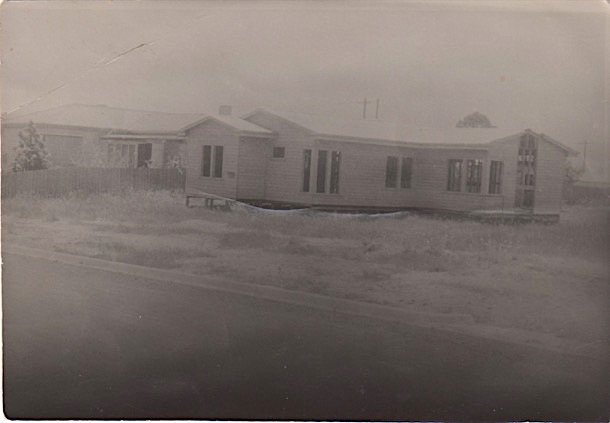
It was a very liveable and rather nice design, set on stumps, weatherboard cladding and with a low slung, pitched roof. It had the standard three bedrooms ,one bathroom, kitchen, dining room, lounge room and laundry. When first built there was an outside toilet attached to the single garage that also had a chook pen attached to it.
Over time, the surrounding paddocks filled with houses and our house changed a little too. The view of the Dandenongs from the french doors in the lounge room disappeared, the toilet moved inside and our grandparents built a flat on the back. The addition of the rumpus room and flat spoilt the spaciousness of the living rooms and the back garden. The old weatherboard garage, toilet and chook pen were removed and a new double garage and new chook pen took the new additions to the back fence.
Little appears to have changed externally to the house since Mum sold it about 1981.
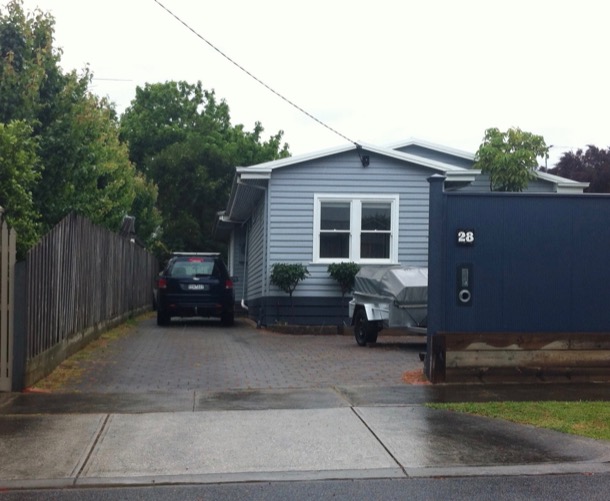
When we were children, Wattle Park itself consisted of large trees with mown grass underneath, like a traditional park, but with native trees and grasses. It was owned and maintained by the Tramways Board, responsible for the tram system in Melbourne. The Tramways brass band played in a rotunda every Sunday in the park. Nowadays those grasses are no longer mown. It looks much more like remnant bushland.
The 137 acres opened as a public park in 1917.
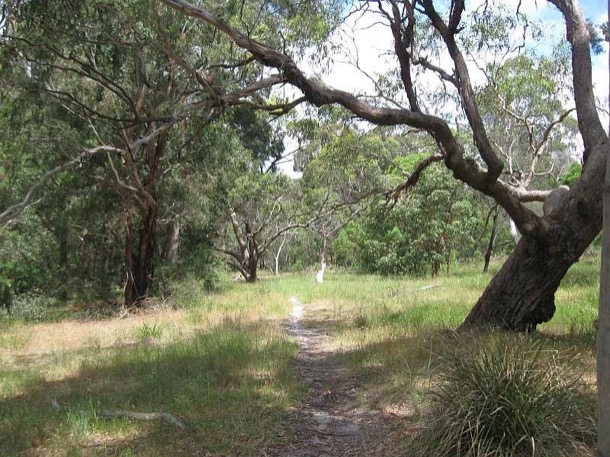
The chalet, designed and built by a Tramways architect, opened in 1928. it was promoted as a dance hall and wedding reception venue and, amazingly, it still is. It is listed on both the Heritage Victoria and National Trust Registers.
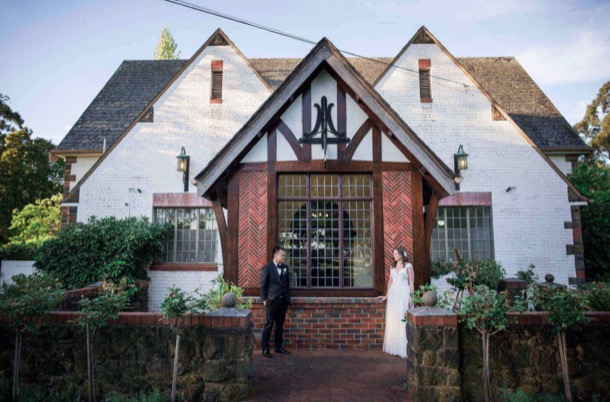
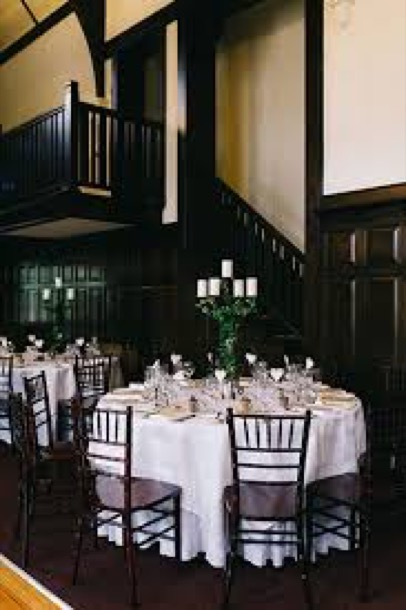
Our own parents’ wedding reception was held there in 1945, after they had been married at the Wyclif Surrey Hills Congregationalist Church in Surrey Hills.
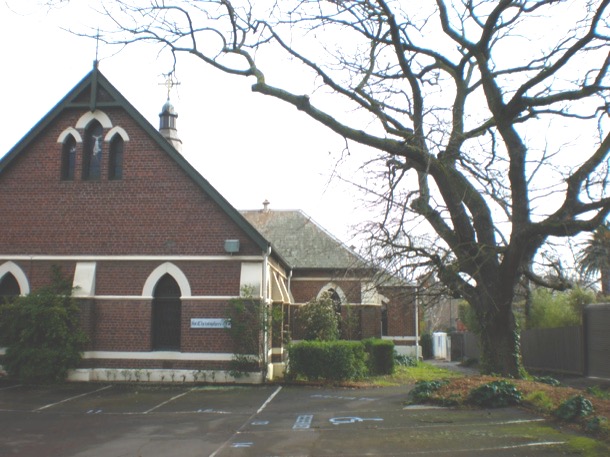
Box Hill Gasworks is now gone, but it was an important part of our parents' history. It was built early in the history of Box Hill:
7/1/1890 The Argus
Some twelve months ago the Nunawading and Boroondara councils granted permission to Mr. Thomas Coates, hydraulic engineer, to lay down gas mains in the streets of the two shires. Mr. Coates purchased an eligible site near Elgar road, Box Hill, upon which to erect the gasometer and the other necessary buildings. At the present time all the mains have been laid down in the shires named, and Mr. Coates is now in a position to light up Surrey Hills and Box Hill with gas. The local works are of such a nature that Mr. Coates contemplates being able to supply the wants of the district for many years to come without enlarging the gasworks. Last night a trial was made in Box Hill and Surrey Hills, when the corporation lamps were lit with gas for the first time. Illumination works were erected at the intersection of the leading streets. The trial was considered a very favourable one, the gas burning bright and clear. In connection with the lighting of these shires with gas a public banquet will be held in Surrey Hills next Monday night.
Over time three gasometers were built.
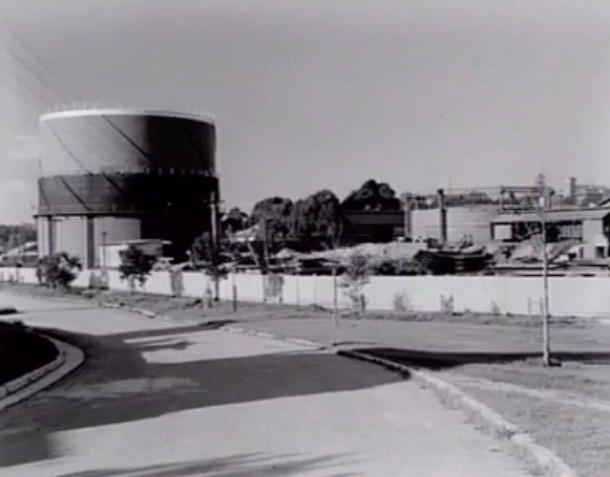
We don't know exactly when Jim started work at the Box Hill Gasworks, but in 1945 he left the Maribinong Munitions factory, where he had spent the war years. It was that year when our parents married and Jim moved into his in-laws’ Surrey Hills house. Soon after, he started work at the gas works as an analytical chemist. He worked there until began teaching in 1954.
Sue remembers him riding his bicycle to work, and later, a motorbike.
He worked in the laboratory, doing things like checking the calorific value of the gas.
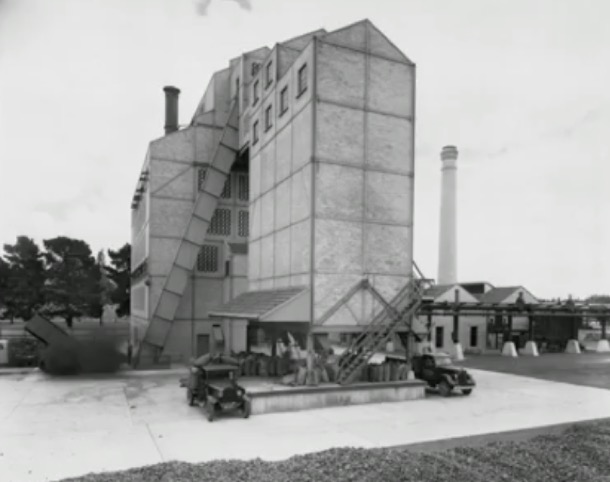
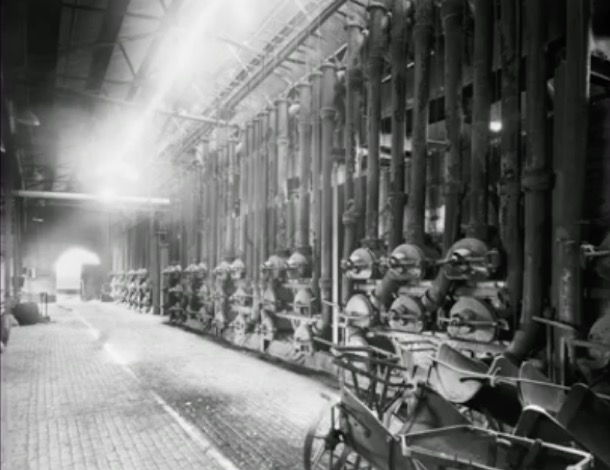
Melbourne’s gas supply was made from Latrobe Valley brown coal, sent by rail to the various gasworks, owned by Colonial Gas Company. Box Hill was one of the biggest. As Melbourne expanded after the war, the demand for gas meant that the various gas works were very busy.
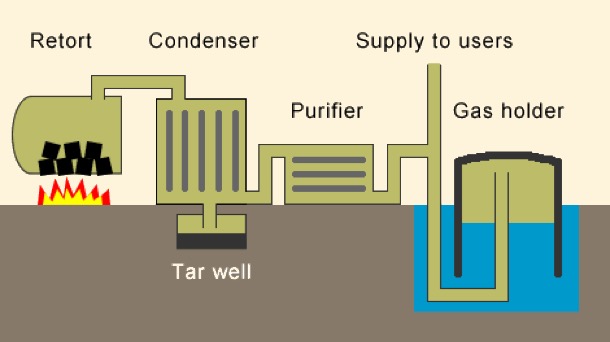
But, by 1960, substantial natural gas reserves had been discovered around Australia. Over the next five years all the Gas plants in Melbourne had closed down, and over 1000 workers were made redundant, by the discovery of natural gas deposit in Bass Strait. Over one million gas appliances in Melbourne were converted to natural gas in 1968. We remember the conversion time. There must have been plenty of publicity. Natural gas has no smell, and, for safety, they put in an additive to make it smell quite strongly. The flame was slightly different, but all the existing burners still worked.
The Gas Works are long gone. Box Hill Institute now occupies the site.
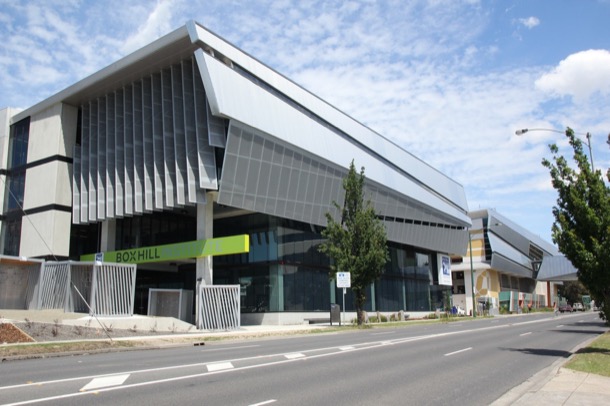
One of the fortnightly highlights in our simple lives was a trip to Box Hill Library. We loved this excursion, as we spent many hours reading on our beds. Books were expensive and we only owned a few. We had to rely on the Library so that we could finish our favourite series like Famous Five and the Billabong Books.It was very exciting if the next book in the series was on the shelf.
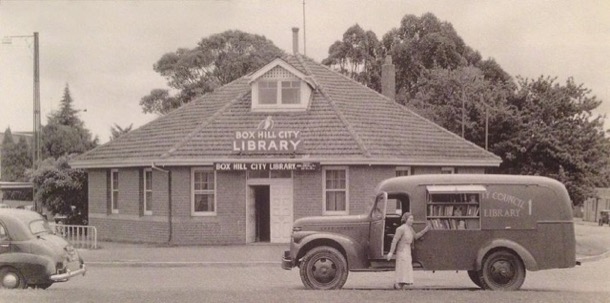
This small brick building was opposite the Town Hall at the end of the shopping centre. Whitehorse Road always had a wide, tree lined median strip, as it does today, and the library was right in the middle. It was later replaced by a grand modern library, but the small brick building is still there.
In our childhood, a trip to Box Hill shopping centre was quite an excursion, involving a four mile walk. In 2019 Google Maps says it takes thirty two minutes, but with small legs and a pusher as well, maybe it took a little longer. I remember it was fun and not arduous at all. The route went through suburban streets until Canterbury Road and from there it was ovals and open ground.
Box Hill Brickworks was one of the best sights on the walk to Box Hill, as the brickworks were still in full production. We marvelled at how small the men and carts were at the bottom of the quarry, and watched the procession of carts pass up and down the steep rail track to the actual brick works.
Box Hill Brickworks was founded in 1884 and was one of fifty or so brickworks throughout Melbourne, producing bricks, tiles and pipes for the building boom and ever expanding city. During the working life of the brickworks the clay was extracted from two clay holes or quarries. The first became Surrey Dive which became a popular swimming venue, but off limits to us. Sometimes however, we also gave ourselves the horrors, looking at green, mysterious waters. There were rumours of 'the dive' being bottomless and of swimmers disappearing in its murky depths. One story was of a man who took a very deep dive off the cliff side and simply disappeared. Some time later his body surfaced in Blackburn Lake, five kilometres away. No wonder we looked in awe and horror through the fence.
Today Surrey Dive is an attractive small urban lake used for swimming and remote controlled boat races.. A walking track around the ‘old dive’ and the brick works is planted with indigenous vegetation and a relaxing and attractive area.
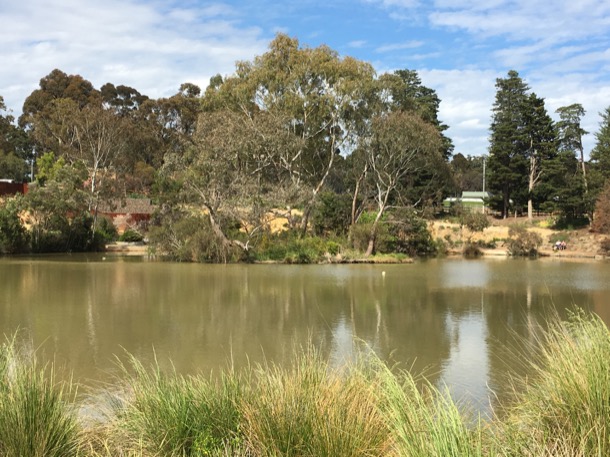
The other clay hole was the quarry that was in operation doing our childhood. It was adjacent to the brickworks and kiln, now derelict but still heritage listed. Unfortunately no restoration work has been carried out. The kiln itself was a massive, red brick building constructed on two levels and, of course, with a huge brick chimney.
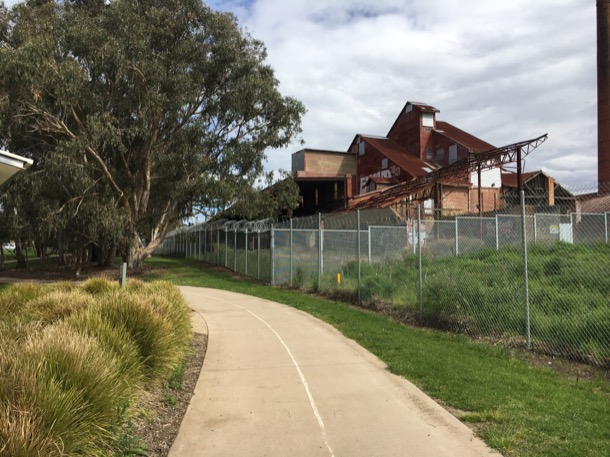
The quarry that was still in full production in our childhood, is now completely filled in. That cavernous hole in the ground is now a large mound covered in every weed known to man. On the horizon above the weeds, are the sky scrapers of twenty-first century Box Hill.
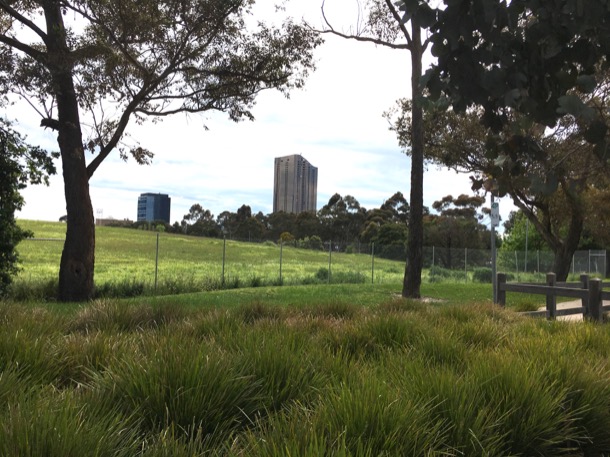
Box Hill shopping centre developed as a commercial centre, as soon as the railway line between Hawthorn and Lilydale was finished in 1862. It became an important transport hub for the eastern suburbs and beyond. During our childhood, Box Hill was the shopping destination for a big purchases. For instance, I can remember choosing a ‘walking’ doll with opening and closing eyes for a birthday present and the excitement of choosing a winter coat with a brown velvet collar. Another favourite shop was the delicatessen where such delicacies as rollmops, sauerkraut and frankfurters could be bought. Amongst the many single fronted small businesses were several large shops such as Taits haberdashery on the corner of Whitehorse Road and Station Street and Maples furniture shop. We also had a Coles variety store that sold anything from socks and singles to cosmetics, and MacEwans Hardware whose slogan was, “You can do it with McEwans because we’ve got a million things.”
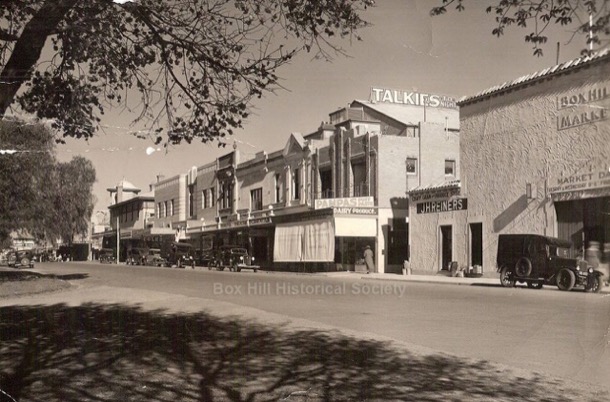
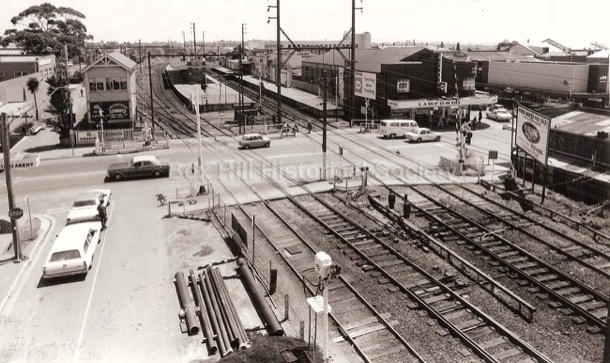
This is a photograph of Box Hill Station and the surrounding shopping precinct in the 1960s. In the centre of the photograph is the old station, that is now underground. Today, above ground, occupying the whole block surrounding the old station, is Box Hill Central and surrounding shopping malls. The signal box, the tall structure on the left of the railway gates is now occupied by the thirty-six storey golden residential tower, called Sky-One.

In the twenty-first century, Box Hill, as a commercial centre and transport hub, continues to influence the built environment around it, as you have no doubt witnessed. Officially designated as a development hub, Box Hill now sports high rise office and apartment towers. The streets we once drove down are now shopping malls, the station is underground, the railway gates are long gone and the strip shops have been replaced by a multi storey modern shopping centre. When we were children the shopping crowds were white and Anglo-Saxon. Today they are predominately Asian and the shops and restaurants reflect the change in population.
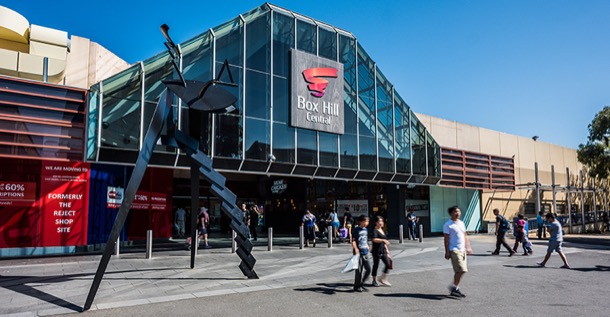
When we, as a family, first started going to the local Presbyterian church, it was called Presbyterian, Wattle Park. We had PWP embroidered on the front of our blue gym uniforms. This was before the advent of the Uniting Church. Church services were held in a cream brick building, called Forsythe Hall.
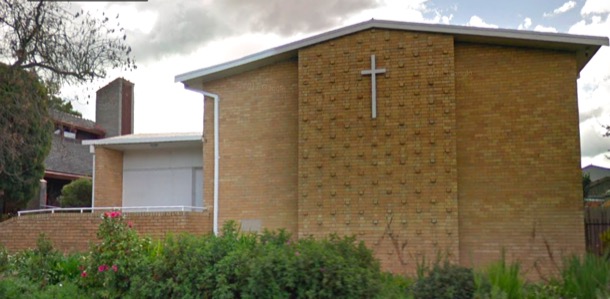
Attached, behind it, was an older little wooden building. During our childhood, this wooden building, Staley Hall, was used for a kindergarten during weekdays. In the evenings, various groups used it, including church boys’ and girls’ clubs (PBA and PGA) and the mixed club (PFA- Presbyterian Fellowship Association), we went to as teenagers. Sue and I both learnt to dance there, and I broke my front teeth on the heater in that room.
We have many memories of Forsyth Hall… dances, performances, Saturday afternoon movies, gym classes and, of course church services.
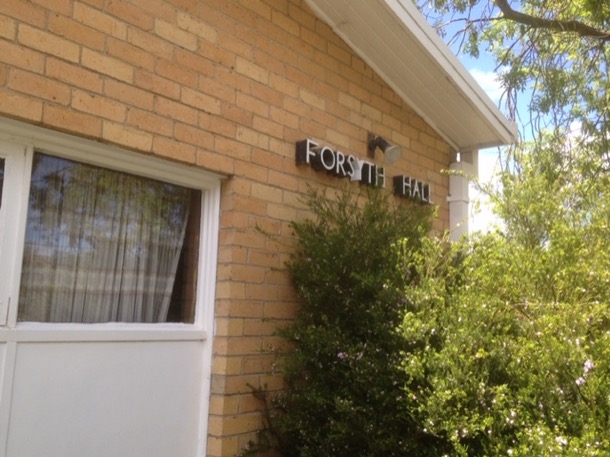
Both our parents were Elders of the church. Our mother taught Sunday School, our father ran the PFA for a while, and was on the board of management. The church was their only real friendship group, and was the only social life we had, as a family.
In the early 1960s the church community began the project of building a new church on the site. The size and scale of the project was a source of much disagreement between our father and others on the management committee.
In the end, a very grand architect designed building was commissioned. The new building was designed by well known architects Chandler & Patrick. An 1887 pipe organ was relocated from a church in Melbourne and extensively rebuilt. The new church, renamed St James, opened in 1965.
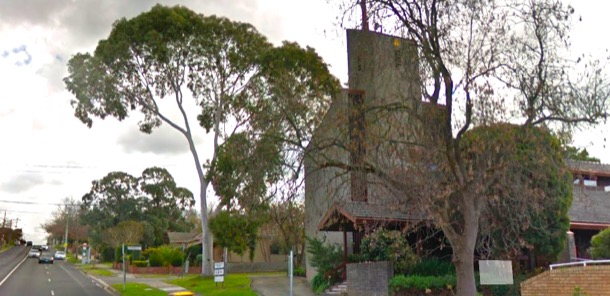
I loved it, because I sang in the church choir, and it had a choir loft at the back and great acoustics.
The buildings are still there. Sue and I visited as a detour on our “back to school” walk in 2016.
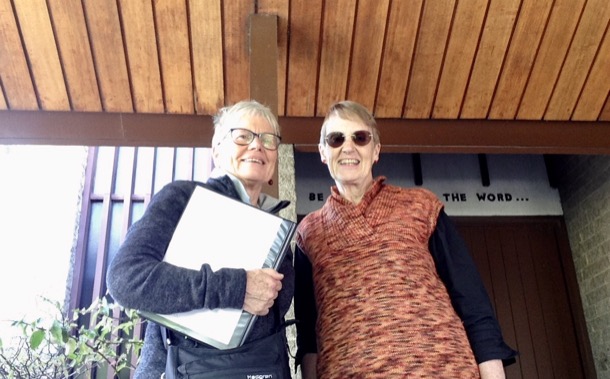
Auntie Bert, a "sterling character"
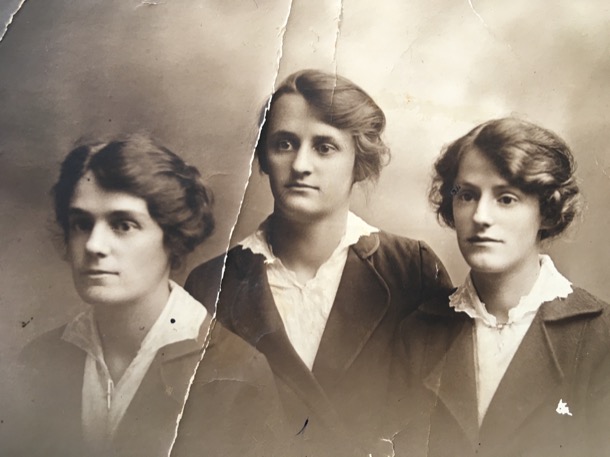
These three young women are our grandmother Alfreda on the left, with her two younger sisters, Beatrice in the middle and Berta on the right.
Alfreda’s set jaw and determined look reflect her independence and demand for an education. I fancy I can see both the rebel and the farmer in Beatrice’s broad face. But look at the gentle, faraway, passive prettiness of Berta. What experiences are already clouding her young face?
About ten percent of the whole of Australia’a population, the country’s young, fit men, set off to war in 1914. More than half of them were killed, gassed, wounded or taken prisoner. There was no such diagnosis as “post traumatic stress”, but we can extrapolate from the modern experience of returning soldiers.
What happened to the equivalent ten percent of young women, who, in different circumstances, would have been marrying them and having their babies?
Our Auntie Bert became one of the many “maiden aunts” of that very specific generation. The family lore is that she “had opportunities” to marry but “chose to stay in the bosom of her family”. We do not know what the reality of her young life was. Had she been a boy, she would have been one of the 417,000 men who enlisted. One would presume that virtually all the young men she might have had a romantic interest in… brothers of her friends, boys from church, at work, on the train, in her neighbourhood… nearly all would have been absent for four years from when she was 18 until she was 22.
Berta Holm was born in 1896. Her childhood and early adult life was spent in St Kilda.
The family story is that Berta and Beatrice unlike their older sister, Alfreda, did not hunger for an education.
Alice and Marge said this in quite a disapproving tone, which made us wonder about the accuracy of the statement, that Auntie Bert left school at Grade 4, declaring that she would prefer to help her mother at home. In Grade 4 she would have been nine or ten!
At the time Victoria was a progressive state and proud to be the first Australian state to create a system of free, secular and compulsory education. This legislation introduced in 1872, required all children aged 6-15 years to attend school unless they had a reasonable excuse. Schools were built, and a system of inspectors employed to enforce compulsory education. Fines for non-attendance were five shillings and increased for further offences. Did Auntie Bert leave school at the tender age of nine or ten? We think it more likely that she attended a State school, maybe unwillingly and, after trying a private school for young ladies, left at the age fifteen. Their disapproval of the lack of enthusiasm for education, compared to their own mother’s, probably colours the story about their aunt. The view of Auntie Bert we were brought up with, was that she was good with her hands, but, to soften and elevate this statement in true Holm fashion, it was followed by, she was a superb craftswoman and much in demand: not academic but exceptional.
Some time after she left school Berta went to work in Flinders Lane.
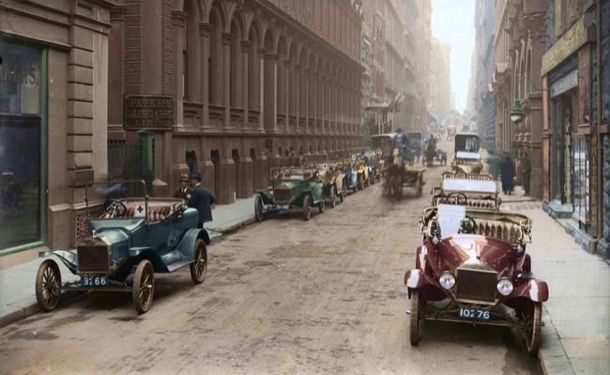
At that time Flinders Lane was the centre of the ‘rag trade’ where many Jewish firms had their businesses. Amongst them was Slutskins, for whom both Berta and Beatrice worked doing ‘white work’. Whitework embroidery is the general term for hand embroidery worked with white threads on white fabrics. It is one of the most elegant and timeless styles of embroidery and was used on underwear, night gowns, table linen, handkerchiefs, baby bonnets, christening gowns and many other small items.
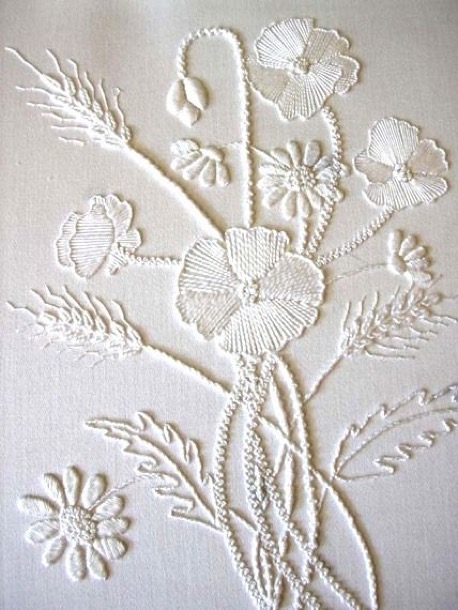
After some experience in this area Berta became forewoman, in charge of a group of other women.
We only have Alice and Marge’s childhood recollections from which to piece together Berta’s life.
In early 1925, when she was twenty-nine, perhaps moving away from her parents’ home for the first time, she left her job, probably that responsible position as forewoman. She went, for an unspecified time, to the country, to help her married sister with a toddler and a baby, and to help serve in her brother in law’s hardware shop.
Alfreda had given birth to Alice, our mother, in 1923. She had had a terrible time, alone, during her first delivery, resulting in the death of the baby. We don't know anything about Marge’s birth or the subsequent few years, except that they were quite near to family help. But when Alice was fifteen months old, Alf and Alfreda moved to Bacchus Marsh. Alfreda was “weak from the birth”. The descriptions of her crying, while scrubbing the floor and having to spend whole days in bed, apparently requiring the help of her unmarried sister, makes us think of post natal depression.
Alf too had what we would today call “mental health issues”. He was a gentle, quite scholarly person, and the business venture in Bacchus Marsh, on the eve of the Great Depression, took a toll on his health. It is no wonder Marge and Alice remember Auntie Bert as a tower of strength and support.
In 1928, the old dry house they had been living in caught fire. At the top of the burning staircase were the little girls in their nighties, Alf sedated, because he was in the midst of a “nervous breakdown”, Alfreda, reportedly trying to find her stockings, and Bert, who carried Alice down the stairs. Marge was carried down by her father, finally awake.
The destitute family were taken in by “the Pierces”. Nell Pierce was a lifelong friend of Auntie Bert. Did they meet there at Bacchus Marsh? We don't know.
The family stayed on for at least a year in Bacchus Marsh, but Berta moved back to Melbourne, once again moving in with her parents, probably her only option.
Now in her early thirties and unmarried Berta must have turned her attention to a job. As far as we know this is when she decided to start her own business as a dressmaker. At first she worked from her bedroom, building her business and reputation.
The business was eventually profitable enough to allow her to move to premises in Riversdale Road, Middle Camberwell and then to Burke Road in Camberwell, just over the junction.
I can remember the junction premises quite vividly. It was one big room on the first floor. Big windows looked out onto Burke Road, letting in light and sunshine that fell on the big work tables. Several dressmakers dummies stood in the corner where the fitting room was screened by curtains. It seemed a very busy place.
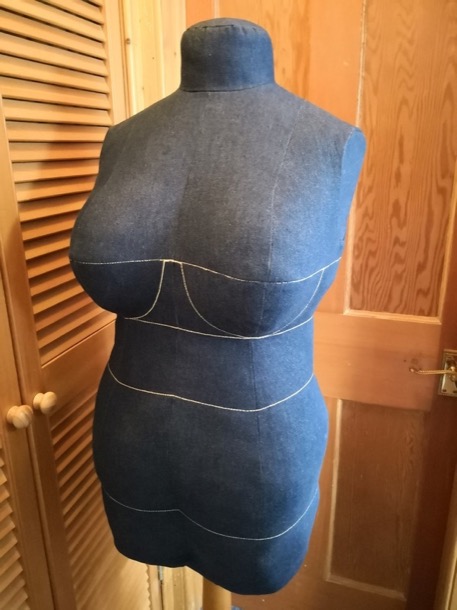
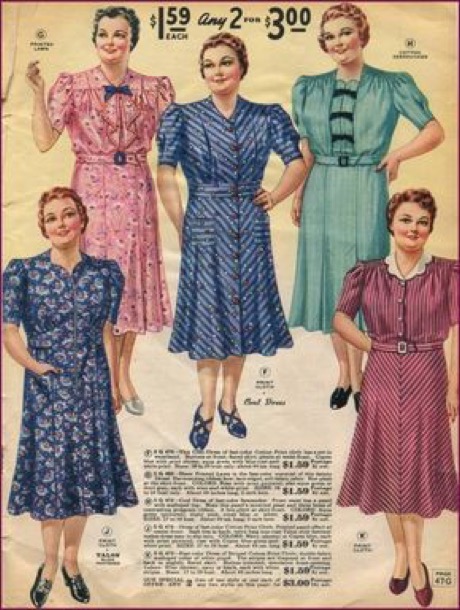
The big tables, that dominated the space were covered in the paraphernalia of dressmaking. There were several sewing machines, many reels of sewing cotton, several pairs of big dressmakers shears, other dressmaking scissors and many tins of pins. Rolls of fabric and garments in various stages of construction took up the rest of the table space. Another woman was sewing at the table, presumably an employee, so business must have been good. We were probably there for a fitting, as Auntie Bert made ‘good clothes’, for Mum. These beautifully tailored clothes were worn to Church and were for special occasions, including weddings:
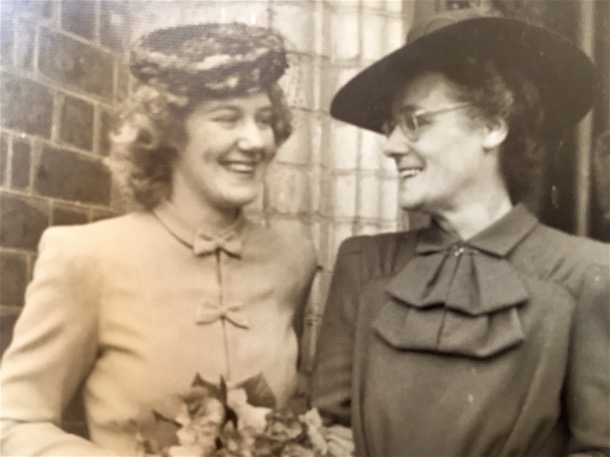
She also made us beautiful clothes including these woollen dresses:
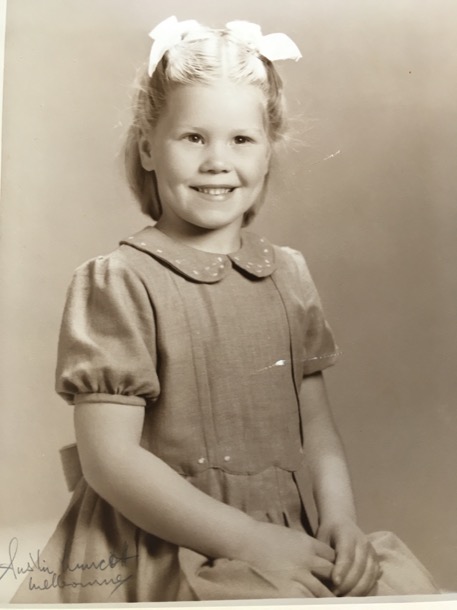
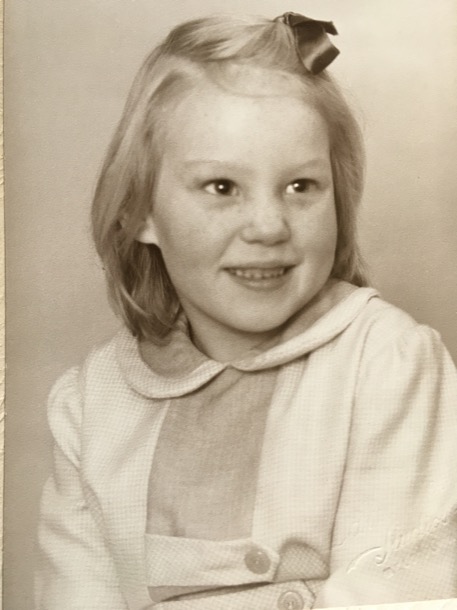
Auntie Bert had an account at Ball & Welch, a prominent department store in Finders Street, Melbourne. She needed an account for her business and a reliable source of good quality fabric for her clients. Its four floors occupied one third of the total block and stretched between Flinders Street and Flinders Lane.
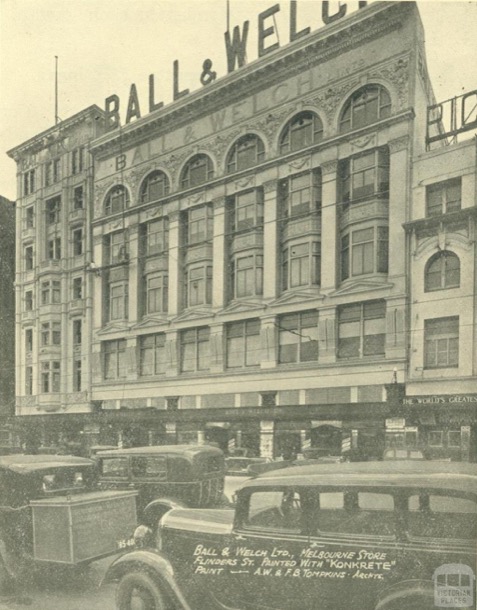
Its many departments included gloves, umbrellas and handkerchiefs, fabrics, furniture, china, millinery, furs and corsets. At one time twenty-six assistants were devoted to the sale of lace alone.
Members of the family were generously given access to Auntie Bert’s account, making it possible to buy items on account and pay later. This was very useful at times, as there was no such thing as Credit Cards. At the end of the month, Auntie Bert sent out letters to all those who had used the account, and we reimbursed her by cheque. This was probably quite a task, not only the arithmetic, but also the sending out of all the individual letters.
I can remember enjoying trips to Ball&Welch. The lifts were staffed by attendants in uniform who recited the list of items available at each level as the lift rose between floors. Parcels were wrapped up in brown paper and string, on huge wooden counters. The expert shop assistants were reserved, formal and a little forbidding to a young child. The exchange of payment was quite a process. The shop assistants' job was to serve the customers, not handle the money. When payment was made, it was placed, with the hand written docket, in a metal canister that went shooting on wires across the departments and then upstairs to the Accounts Department. The docket was checked, change inserted, a receipt written and the canister whizzed back from whence it had come. Transaction complete.
The cash-ball system worked reasonably well, but the rails were intrusive and the interior layout of some stores did not allow certain counters or departments to be connected by inclined tracks. The ingenious Lamson then hit upon the concept of the “aerial railway” and set about tinkering with a gondola-like design, which became known as the wire-line or cable-carrier.
By the late 1880s, sales staff could secure cash inside a small wooden jar or canister, suspended by wheels from a taut wire that ran overhead from the sales desk to the cashier’s station, which was typically a cage-like booth situated in the center of the store. By tugging firmly on a spring-loaded cord or lever known as the “propulsion,” the canister would be catapulted along the wire, reaching its destination in mere seconds.
The cashier could then “return fire” with change and a receipt. Cashiers who worked in booths on levels above the sales floor could simply release the canister and let gravity return it to the appropriate counter.
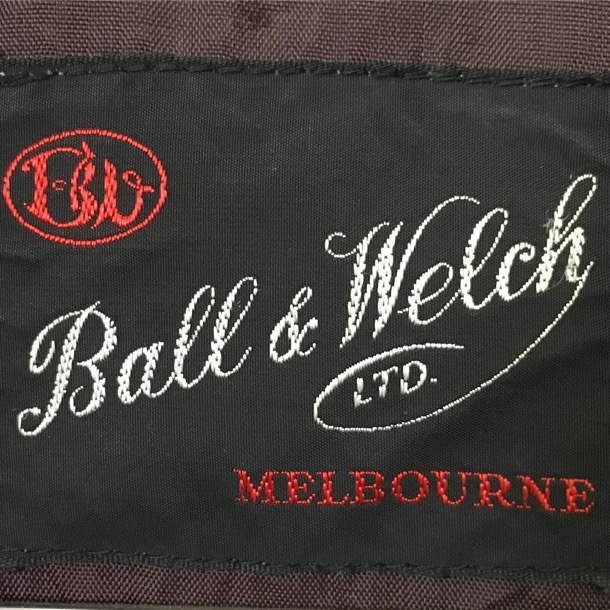
Ball and Welch closed its doors in 1970, the end of an era .
Berta’s sister, Beatrice had taken up dairy farming in the early 1950s, near Cockatoo, in the Dandenong Ranges. The bulk of the work was done by her husband, and three sons. In 1955, the wife of Rob, the middle son, died, leaving a baby daughter, Julie, to be raised by her grandmother.
Into the breach stepped Berta. She moved into a small bedroom in the farm house, and became a second mother to Julie. We remember her room. It had been part of the farmhouse verandah, and the whole room was about twice the size of the single bed. It was neat, sparse and dark.
Our memory of Auntie Bert at the farm is solely inside the farm house. Unlike Auntie Beat, who mucked out the pigs, wearing layers of old jumpers and a woollen beanie, Auntie Bert was always nicely dressed. We remember her in well-cut woollen skirts, stockings and heeled court shoes, with classy jumpers and cardigans. We picture the two of them in the kitchen, both wearing aprons, turning out scones and cakes on the wood stove. Auntie Bert became a permanent and valuable member of the family, looking after the “boys” and Julie.
While her main home and focus was life at the farm, Auntie Bert continued, as she had her whole life, to be the family helper and nurse. She had looked after both her own parents in their final years, and she came to live with us to help out with her elder sister: our Nana, Alfreda, who had dementia. We remember her as a quiet unobtrusive presence in our home. A few years later she came again and helped with Alf, our grandfather, in his final weeks.
So Alice saw first hand, the skill and care of Berta’s nursing:
Apart from staying temporarily with other members of the family, usually to help out during family crises, Berta lived there at the farm, until her death in 1976, aged 80.
Alice reflected on Berta’s death and the simple generous life she lived:
From left to right, Nana, Auntie Bert and Alice: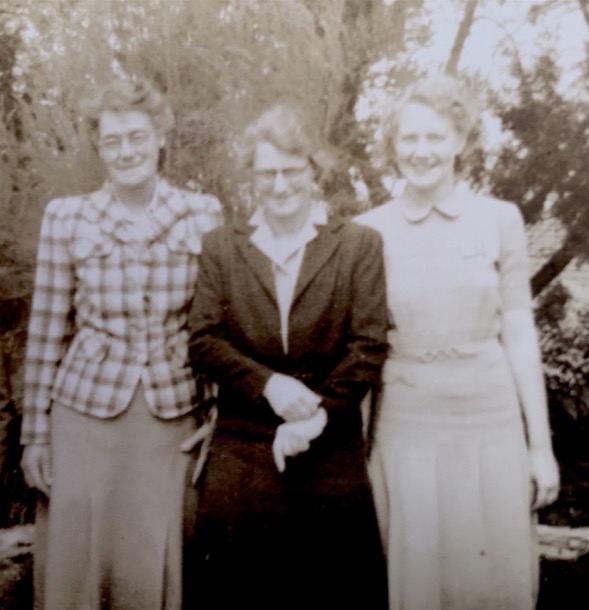
The Croydon Years
When the Coates family moved to Croydon it was the beginning of the Great Depression and many men were out of work. To complicate matters, Alf had been in partnership in a hardware business in Bacchus Marsh that had burnt down. Not only was the fire a personally traumatic experience for the family, as their house had also burnt down, but the business was not insured. As manager, Alf was responsible for the lack of insurance. He was therefore "lucky indeed" to have the job as the hardware store manager at the Croydon Timber Yard. He was on a reduced salary as recompense for the losses of the other Bacchus Marsh partners, who now owned the Croydon business.
Croydon was at that time a pretty, country town, connected to the world by the railway that ran, as it does now, from Flinders Street to Lilydale.
White settlement had reached Croydon in the 1850’s, as timber cutters arrived seeking new sources of timber for the needs of rapidly expanding Melbourne. Many small, and a few large land holdings were taken up, and fruit trees were found to flourish in the area.
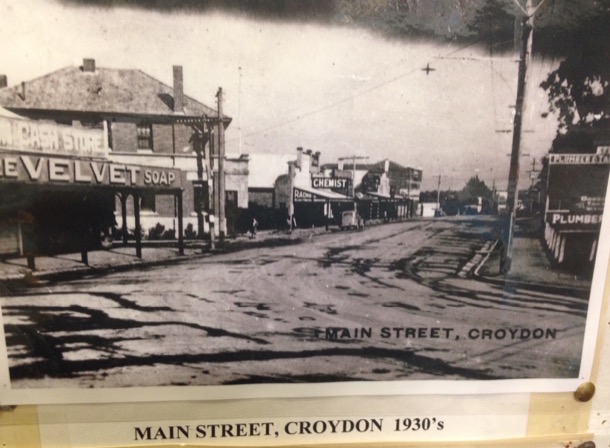
The town that the Coates family found, spread out from the railway station. Businesses and shops were strung out along the long, wide, slightly curving main street. The Dandenong Ranges made a lovely backdrop to the town that was surrounded by small farms, orchards and bushland. Home for the Coates was a small house, painted battleship grey, in Hewish Road, very near the corner of Main Street. This was the wrong side of the tracks. The expensive houses were built over the railway line in Wicklow Avenue, extending up the hill towards what is now Maroondah Highway.
They remember their house as having a beautiful backyard, graced by an enormous Mulberry tree and a large vegetable garden. There was a cow paddock on one side of the house and the Wine Hall on the other. Hewish Road at that time was unmade, covered in hard stone embedded in the clay. The Coates were right in the business end of town: Cook’s Grain Store was directly opposite and Croydon Timber Yard, not far away, also in Hewish Road. Not only did this fiercely teetotal family live next to the Wine Hall located on Main Street corner, but on the other corner was the Croydon Hotel. These two establishments loom large in their childhood memories, as they were the source of the moaning drunken men that they sometimes heard outside. Occasionally their father had to take the men home.
Croydon Hotel:
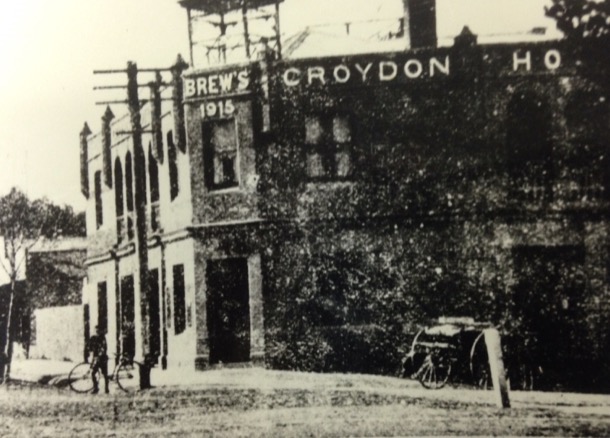
Croydon Wine Hall:
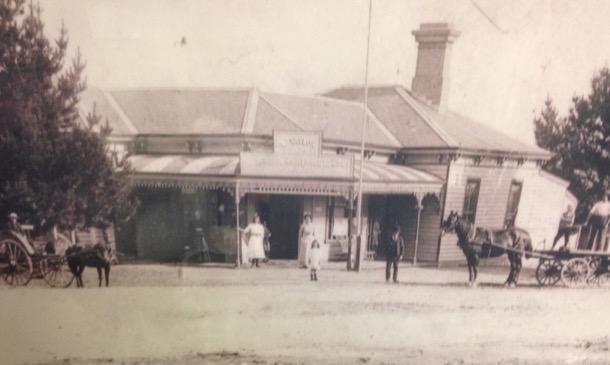
Alf worked weekdays, Friday nights and Saturday mornings at the timber yard. Once a month he also drove the truck to the wharves to collect timber.
Money was tight, especially as Alf and Alfreda wanted their girls to have a decent secondary education at MacRobertson Girls' High School in Albert Park. One-third of Alf’s wage went on rent and by the time bills were paid and weekly expenses were covered, there was not much left over. At secondary school, fees were charged, books and uniforms would need to be purchased and weekly train fares paid for. Daily life therefore included the care of livestock and the processing of milk and eggs: all quite time consuming.
As well as their home grown vegetables and fresh eggs, the Coates family produced their own milk and cream.
All was not hard work however, and the Coates’ kitchen, warmed by the one-fire stove, was the venue for cups of tea and chats, many of them about cricket. In the picture, Alf is second from the top left:
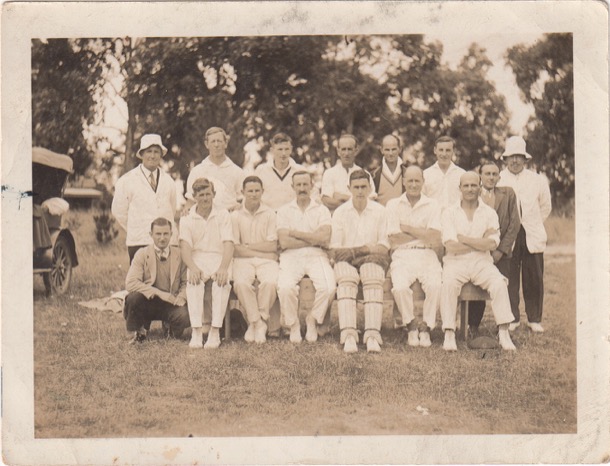
Marge and Alice had a very happy childhood in Croydon. They played often with the Cook sisters, Yvonne and Margaret, who lived opposite. The Cooks had once owned the Croydon Timber Company, Alf’s employer.
Their house was on the other side of Hewish Road, next to the hotel. Connected to the Cook’s house was the grain store, which was now the core of Mr Cook’s business. There were delivery horses in a nearby stable too, and cows in the paddocks behind. The grain store was packed with bags of chaff and grain. The girls spent many hours playing in there, climbing right up to the roof.
One happy memory is of “penny concerts”. Hours of preparation: planning, costume making, and rehearsing, culminated in a concert performed on the Cook’s wide side verandah. This seemed to be mostly in the summer holidays, when the Cook girls’ cousins came to stay. Marge and Alice sang part songs, often Elizabethan madrigals they had learnt at school: Alice singing soprano and Marge, alto. The adult audience (probably only their parents) paid a penny to attend.
Alice remembered playing a sort of scavenger hunt, following written clues to find a prize. “Next clue under the camellia bush”.
She also remembered marbles, played in the dirt on the side of the unmade Hewish Road. When Sue and I stood on the same spot in our Croydon visit, we could hardly cross Hewish Road, for traffic! In the 1930s, it was a quiet gravel road with no gutters and unmade footpaths.
The Coates and Cooks lived opposite each other, and used to signal out of windows at night across Hewish Road. They planned, but never carried out, midnight feasts.
The wild games and excitement of playing with the Cook contrasted with the much more demure and restrained Hebbard girls. Pam and Honor Hebbard were the daughters of Frank Hebbard, the Primary School Principal, and friend of Alf and Freda. Their huge library of books were available for Marge and Alice to borrow, and the garden was a delight to play in. The Hebbards lived up on the Hill, at the top of Kent Avenue, which wound up to what is now the Maroondah Highway, through foothills bushland. A favourite activity with the Hebbards was to wander this bushland looking for native orchids. The remnants of this forest are much prized today, though much of it is degraded, and many of the species of orchid are now only to be seem in a museum.
Visits to the beach, during Marge and Alice’s Croydon years, were limited to School and Sunday School picnics. But they did learn to swim. They would go by train to Lilydale, where there was a huge concrete tank, right on the side of the Olinda Creek. Fresh water would flow in and out with this quite large perennial creek. Alice remembered Mr Hebbard lining them all up along the side and getting them to enter the water with a shallow dive. Nowadays the pool has become a more modern outdoor pool, but it’s still in much the same place.
Friday night shopping was another form of fun. Marge recalled it as a chance for everyone to parade up and down the street. Alice remembered buying “sixpennorth” of lollies and sharing them out. It was a simple life for these country kids. It is notable that, three years apart in age, much of their leisure time was spent playing together.
Marge and Alice of course went to Primary School during these years at Croydon, Marge as far as Grade 8. We will spend more time on this important topic at a later date. Suffice to say, at the moment, that their parents’ friend, Frank Hebbard was the Principal, and he ran a very enlightened, rich educational program, in which the girls flourished. The Croydon Primary School has new premises these days, but the old buildings are still there, now occupied by a Community School.
Family entertainment included hikes from Croydon to Kalorama, and visits to friends, the Cheongs. They were a wealthy and prominent family in the area. At our visit to the museum in Croydon we found many mentions of them, in particular their importance to conservation of remnant foothills vegetation. Even now Cheong Wildflower Reserve, near Croydon, still fulfils that role.
Mr Cheong, from our mother's photo collection:
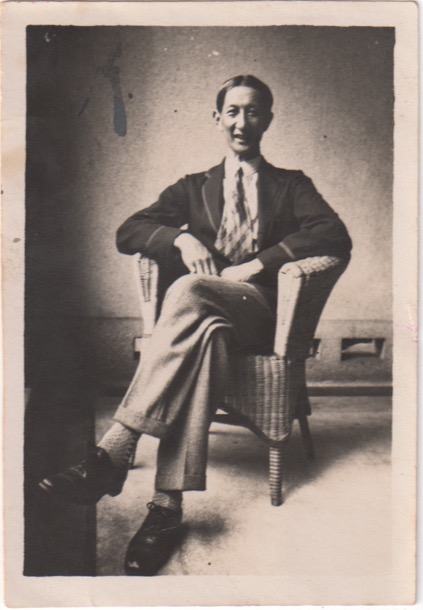
In their leisure time, many happy hours were spent in the Coates’ warm kitchen, “yarning’.
Even though much of the good food the Coates family ate was home grown, some things had to be purchased at the Main Street shops.
The Croydon years were remembered very fondly by both Marge and Alice. They were formative years for both of them. Alice actually names the four areas of interest from those years that became her life long passions.
In 1936 the Croydon years came to an end with the death of Martha Holm, Alfreda’s mother. Presumably the family had to move back to Boronia Street, Surrey Hills to help Alfreda's sister, Berta take care of Roger Holm, now quite an elderly man. Berta was working full time at her dressmaking business. Alf found a new job in the city and Alice embarked on her secondary schooling at MacRobertson Girls’ High School.
Decade by Decade
Here is the audio of this from the recordings:
With our more modern education, we have less of a firm grasp of History, and we know that our children, and their children have, and will have, an even sparser knowledge. So we have taken the overview concept, explained a little more fully, and added in our father’s family history and other aspects we have recently discovered.
Alice and Marge finished recounting their family stories at 1950. One of our tasks in this project has been to continue on from then, and so we have done just that. We explore the nineteen fifties, sixties and seventies, linking what was happening in the wider world into our own lives.
1850-1950
Between 1839 and 1872 our ancestors arrived in Australia.They came from both Northern and Southern Ireland, England, Germany and Denmark. All were from humble origins, having worked as agricultural labourers, domestic servants, a baker and an engineer. Some were already married and others met here.
As our ancestors built their new lives in Victoria, the First Australians had already felt the disastrous impact of European contact. There had been violent conflict, the Wurundjeri population had been decimated and the survivors relocated to reserves or camps a ‘suitable' distance away from the growing population of Melbourne and outlying settlements. In 1844, when the Bourkes took up their selection at Pakenham, they were the first white settlers in the area and the “blacks camp” by the river was noted in Catherine’s memoir. Several years later, Adam Rye, from the other side of the family, was robbed by a party of ’50 blacks’. The newspaper report notes that ‘the blacks at this time were very treacherous’.
With the discovery of gold, in New South Wales and Victoria, there was a huge increase in population and in wealth.
Victoria benefitted the most. Melbourne became Australia’s largest city, with a huge land boom. Grand old buildings like the Melbourne town hall and exhibition buildings are reminders of those glory days.
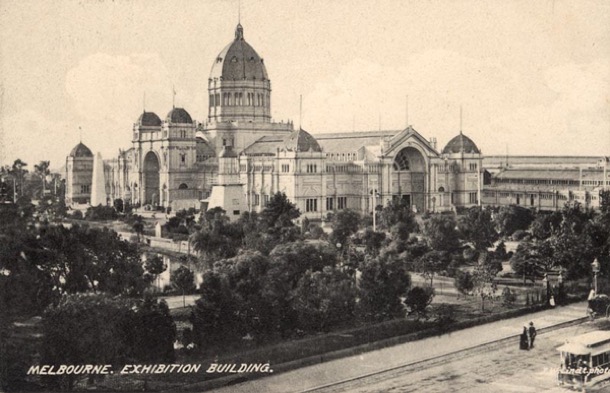
The increase in population, rapid development and the attraction of the goldfields led to a shortage of workers. This meant great job opportunities at every level. It also put workers in a good bargaining position.Trade Unions developed and working conditions were the best in the world. Australia was an egalitarian workers’ paradise.
Small businessmen, like publicans, bakers and lawyers, prospered with the growth in Melbourne. For farmers, it meant bigger markets, more mouths to feed. The growth in country towns, better roads and railway development made life in the country less difficult.
Engineers had a lot of work with the sudden development of infrastructure and property developers were run off their feet. Our grandfather’s grandfather, a young engineer from England, was building bridges in the expanding colony. While building the bridge across the Barwon River, his son, our grandfather’s father, was born, his birth unregistered.
Back in ‘Marvellous Melbourne’ our grandmother’s grandparents who had arrived from Belfast, were developing St Kilda: building large houses and public buildings for those who were prospering in the boom town.
On the land, our maternal ancestor Adam Rye, who had survived the attack by ’50 blacks’, settled in Geelong and worked as a farm labourer. He was later gripped by gold fever and went north to seek his fortune, only to be held up by bushrangers and lose his meagre pickings. His daughter married a German immigrant, Dau, and they settled on a mixed farm at Wandong. Here they raised seventeen children and supplied food to the growing population.
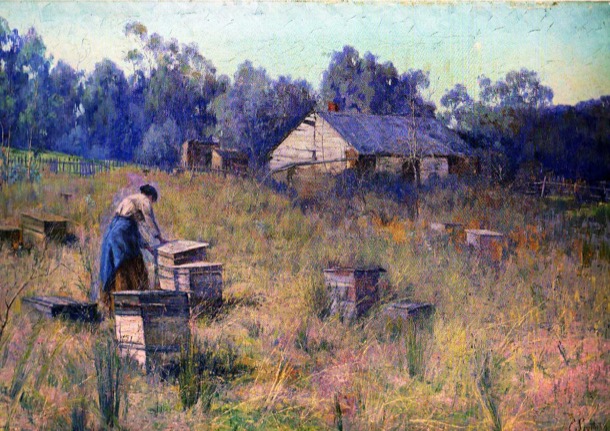
Meanwhile our paternal forbears, also on the land, were making their mark in Gippsland and North Central Victoria. In Pakenham the Irish Bourkes were building their family of thirteen children, and now owned Bourke’s Hotel. They were becoming significant landowners and community members, as they set about acquiring land, marrying their daughters well and establishing their sons on large and prosperous properties. They also served their community in local Government and built the horse racing industry in Pakenham.
1858 Land Sales, Michael Bourke's purchases:
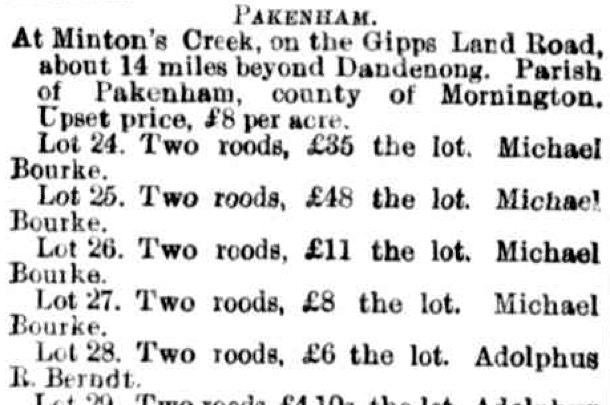
The MacCormacks, in North Central Victoria were also acquiring and working large grazing properties, firstly in Tallarook and then in Molesworth. They too were pillars of the local Catholic Church and community. Our grandmother was born there, at Balham Hill, pictured below.
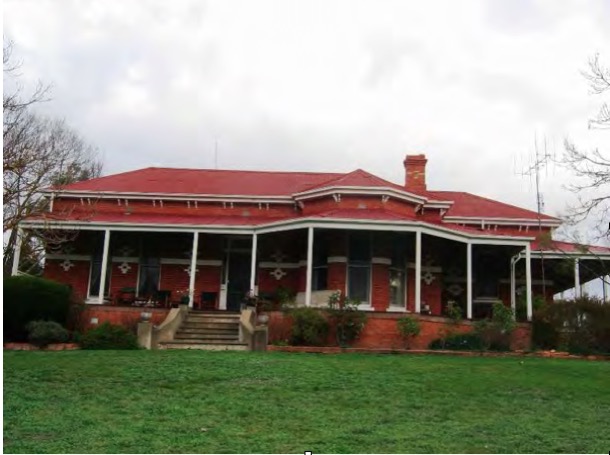
Melbourne became the financial centre of Australia and New Zealand. The Pakenham Bourkes’ fourth son, our great grandfather, was part of this world. He had moved to Parkville and built his law career in this thriving city. Australians were growing in confidence and the young nation was showing signs of an interest in its own identity. This was the era of Henry Lawson and Banjo Patterson, who wrote about the characters of ‘the bush’. At the same time, Tom Roberts and his paintings glorified the unique Australian landscape and the men and women who toiled there. This growing sense of identity and of nationhood is reflected in the moves for independence from Great Britain. During this era of optimism and hope our grandparents were small children, and their families were well established in both country Victoria and Melbourne.
Federation was achieved in 1901, and the country celebrated:
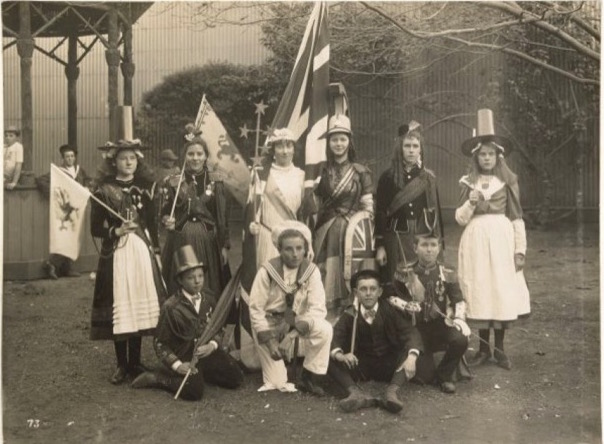
Australia was longer a colony but an independent nation. Melbourne was the largest city in Australia at the time and the second largest city in the Empire (after London). It was fitting that the new Parliament should sit in Melbourne while Canberra was being constructed.
The decade after Federation saw Australian women join the battle for women’s suffrage. White men over 18 in Victoria had had the right to vote since 1858, but women were not granted this right until 1908. Our maternal grandmother, Alfreda, was sixteen when women were granted the right to vote. We imagine she would have approved. She had been engaged in her own battle to pursue her dream of further education; and during this decade she finished her secondary education at Melbourne’s Continuation School, the opening of which marked the beginning of state secondary education in Victoria.
This period of prosperity, optimism, and political and social change ended in the devastation of the Word War 1. We know little of the family’s war service, but three of our maternal grandfather’s uncles served in France, and one lost his life. In the highly charged patriotic atmosphere of the time, and with mounting casualty lists, the war years must have been a difficult time, especially for our grandfather who was considered unfit for service due to ill health. He was deeply upset when given a white feather. Presumably our paternal grandfather being a country doctor, was in a protected occupation.
Our grandparents were all married at the end of this war. Our father’s parents were married in St Patricks Cathedral in a grand affair. Grace and Hugh then settled in Koroit in the Western District, where Hugh was the local doctor.
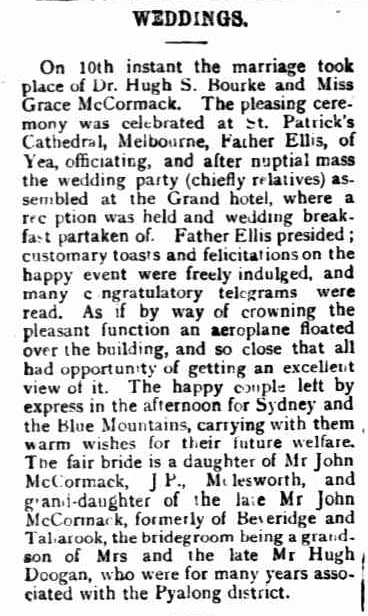
In contrast our mother’s parents were married in the Methodist Church in Surrey Hills in a small and simple ceremony where the bride did not even wear a wedding dress. At that time Alfreda was working as a teacher and Alf was working in a hardware shop in the city. They also moved to the country, soon after: to Eildon, where hardware supplies were needed for the construction of Eildon Weir.
Our family then lived through the Great Depression of the thirties, formative years for our parents who were by then at school. Our father was boarding at Xavier College and our mother was at Croydon Primary School. By the end of the decade the world was at war again.
During the war in a munitions factory, in Maribyrnong, two very different family histories were to merge into one. One was Irish Catholic, successful and quite wealthy, and the other was staunchly Protestant and relatively poor. One was involved in the Melbourne horse racing scene and the other was teetotal and interested in ideas and the new ‘isms’ that were emerging on the other side of the world. Our parents were married at the end of World War 2.
1950s
Our mother’s view of the 1950s, in her recording, is of a time of burgeoning economic growth and development. To us, it is the decade we first became aware of the world.
Our world was redolent with Australiana, but we were intensely aware of our British heritage, and it dominated our reading, our schooling, our whole culture. A portrait of The Queen hung in our school. Sue remembers keeping a scrap book at home of magazine articles about the Royal Family. She was particularly interested in the corgis. Apparently I had one too, and it contained very many pieces about Princess Margaret.
Enid Blyton Books:
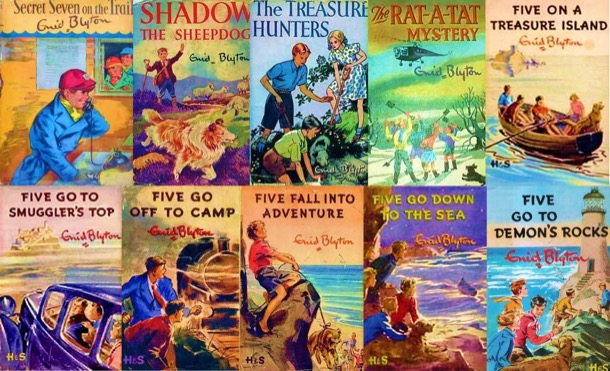
Globally, it was a dangerous world, with the cold war in full swing, and a very real threat of nuclear war. Our parents had quite well developed political opinions, particularly our mother, so we were exposed to adult conversations about the issues of the day. Family friends and neighbours, the Lees, were active in the union movement. They encouraged our parents’ involvement in the movement for “unilateral disarmament” and other left wing activities. I remember our mother’s admiration for an older couple who took a small boat out into the Pacific Ocean to protest the nuclear testing. Bikini Atoll in the Pacific, sixty years on, is still a no go zone from the USA nuclear tests carried out there up until 1958.
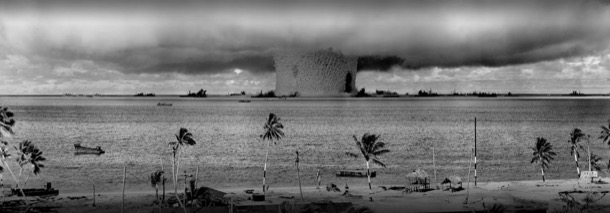
This was the time of McCarthyism in America, and Australian political attempts to ban the Australian Communist Party: a divisive time, where everyday people had strong opinions one way or the other. Sue remembers Prime Minister Menzies as “the devil incarnate”.
The Campaign for Nuclear Disarmament became overwhelmed in the 1960s by anti Vietnam War action, but it was an important political movement of the 1950s. The familiar “Ban the Bomb”, or “Peace” symbol was invented in 1958, as a symbolic representation of ND (Nuclear Disarmament)
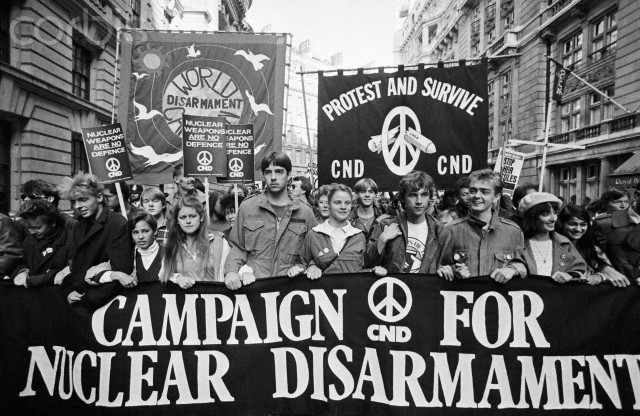
Our family was, by today’s standards, quite poor, but this did not impinge on our life, at this time. We were well fed, we had a stay at home mother who looked after us and the struggle to pay bills was not part of our conscious experience. As far as we children knew, we were neither poorer nor better off than our neighbours, with the exception of the family in the housing commission house nearby, whose son had polio and who didn’t always have enough to eat. The world, as we observed it in our daily life, was largely classless. Perhaps Australia at this time really was the egalitarian workers’ paradise it purported to be, to prospective migrants in Britain. (only whites of course)
Nevertheless, we knew about the religious and economic differences within our family: that our father’s relatives were wealthy and that we were not, because our parents’ union was a “mixed marriage” and very disapproved of. We were very aware of their Catholicism and our Protestantism, and that we were not as close to our grandmother as our cousins were.
Our father during the 1950s, went from working as an industrial chemist by day, and studying by night, to full time teaching. We got our first car, a television and a refrigerator. By the end of the decade there had been four children born. It was busy, but simple life, encumbered by very little “stuff”.
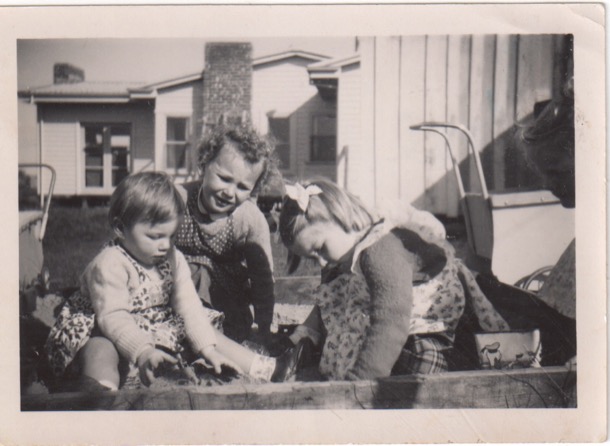
Our suburb of Box Hill South was the edge of suburbia, when our parents first bought their block. During the fifties the new suburbs filled in with more and more families, and the frontier stretched east towards the orchards of Blackburn.
Below is Doncaster, contrasting the 1945 view to that of today. It was little changed in the 1950s. We remember breaking an axle on our Talbot car in Doncaster, a farming and orchards area with narrow unmade roads.
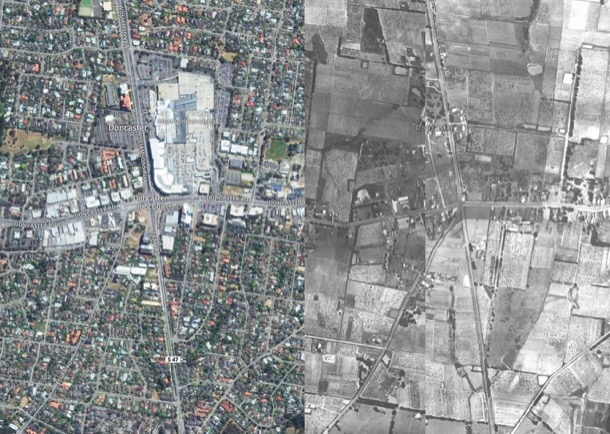
The sewerage reached us during the late fifties. Neighbours got together to dig each others’ trenches. The footpaths were paved, allowing us to roller-skate along them.
The streets were deemed to be safe enough for five year old girls to walk unsupervised, from Box Hill South to Surrey Hills to Sunday School and to Bennettswood to school.
We are baby boomers, and this was the most booming time. When we began school, Sue in 1954 and me in 1957, “temporary” schools were being thrown up, and unqualified teachers recruited to deal with the rush.
My first experience of school was a few weeks in “bubs”, and then the-bursting-at-the-seams class was reduced by a handful of us being put straight into Grade 1. Here is that grade photo with Miss Meadows and her 47 pupils.
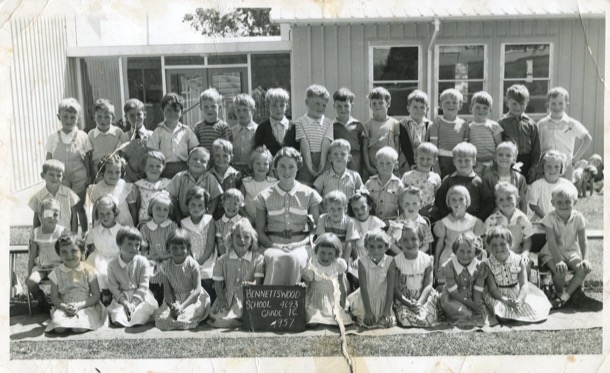
1960s
This decade covers our teenage years. It was a time of huge change in the western world. By the end of the decade, Neil Armstrong had walked on the moon, women were controlling their own fertility with the Pill and popular culture had discovered the huge Baby Boomer teens market. During the sixties, there was a general loosening and questioning of traditional social norms. Older people were probably more aware of these momentous changes. For us the loosening of the cultural apron strings, that is such a feature of these times, coincided with the loosening of our familial apron strings.
The conflict between our generation’s straining at the bit and society’s entrenched traditional values played out in our school life. As fashion hemlines rose, school uniform strictures fought them. We knelt to have the gap between our uniforms and the floor measured precisely, and hastily pulled down our hoiked up dresses whenever a teacher came in sight. The anti war slogans on our pencil cases, alongside the names of pop groups we fancied, had to be kept hidden, or there would be detention. A new rule dividing the grassed hill area into a boys’ side and a girls’ side transformed the hill into a vast empty space with a cramped central area where everybody sat alongside the invisible line. In our school, as far as we can remember, there were no brown faces, hardly any Asian faces and no Aborigines. Foreigners were the Italian and Greek “new Australians”, and even they were rare in our (then) outer Eastern suburb.
Culturally, as more and more families spent more and more time around the television set, American culture rather than English, began to dominate our life.
We can’t remember exactly when we got a television set, just that it was bought specifically for watching cricket. As a family we watched the Australian serial Bellbird, which preceded the seven o'clock news. There were a succession of American sit coms we all watched, like My Favourite Martian, Bewitched, Father Knows Best, the Donna Reed show, Bachelor Father, My Three Sons and Mr Ed. After school I remember Clutch Cargo, Sea Hunt, George Reeves in Superman, and Hogan’s Heroes, F troop and Bonanza. And very rarely we were granted permission to watch 77 Sunset Strip. These are nearly all American titles. There were Australian and English shows too, but it is the American ones we remember.
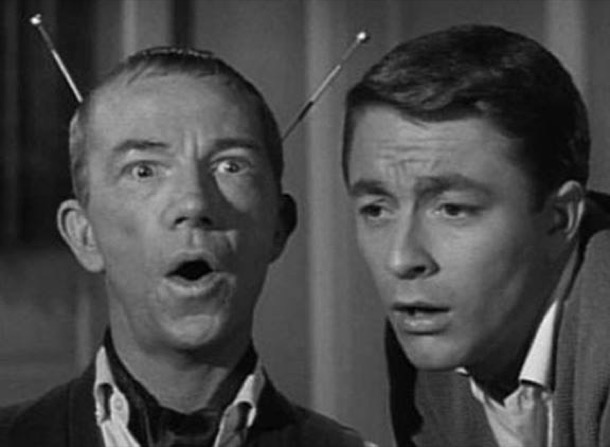
With this American influence in our lives, and increasing prosperity, “teenagers”, a term first heard in the 1950s, emerged even more as a marketing target. For the first time, teenagers had their own music, fashion, language. I was more plugged into Teen culture than Sue. I began to go to local Saturday night church dances from about aged 14. There was always a live band who played rock and roll covers. A group of us from church would go.
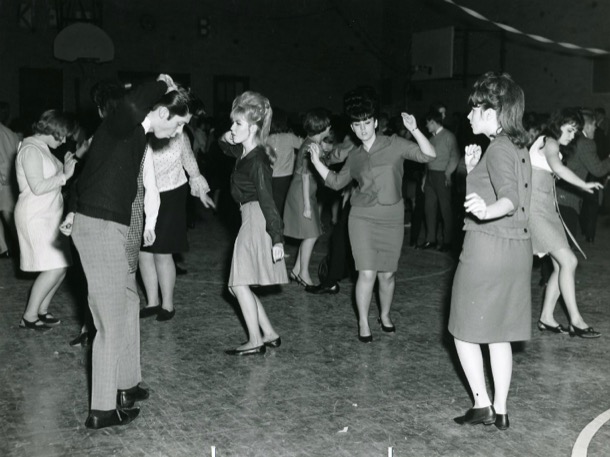
Dress was quite formal, ties for boys and stockings and heels for girls. I remember the winter that plain coloured wool dresses with white crocheted collars and cuffs were all the rage: probably 1965. Auntie Bert, dressmaker to the wealthy ladies of Melbourne, made me a tailored aqua one with little kick pleats around the bottom.
Below is fourteen year old Margaret in the aqua wooden dress with while crocheted collar and cuffs.
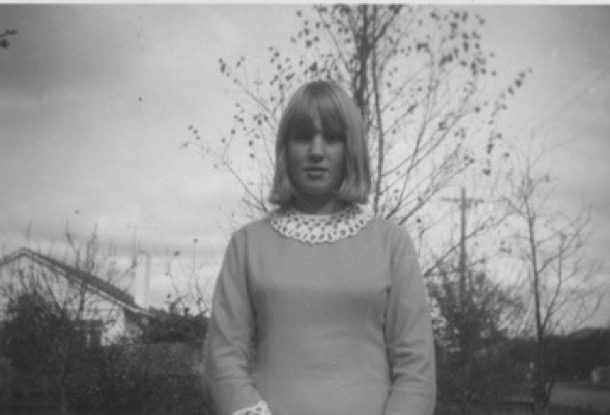
During the 1960s, Australians were entrenched in the divisive Vietnam war. Our family was by default anti war, and the “all the way with LBJ” policy of our government was fiercely criticised. In 1967, my boyfriend and another close family friend was conscripted for military service. Against huge opposition, the government had voted to call up into military service some twenty year old men. Many of them ended up fighting in the jungles of Vietnam. Our mother testified in court for the other friend, who was a registered conscientious objector. But many other friends and acquaintances went off to Vietnam with their hair shaved and very basic training. Some of those veterans live with the trauma of those experiences even today.
A "Save Our Sons" movement protested against conscription:
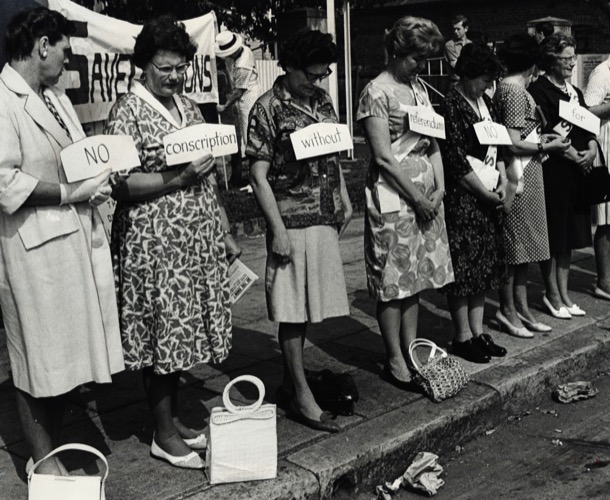
Gradually, public opinion in Australia, as in America, swung firmly against the war; and ordinary Australians demonstrated in the street.
By 1970, Sue and I had left school and were engaged in our tertiary studies, sharing a house in North Balwyn. University was still expensive, and we both managed it by gaining a bonded scholarship called a Studentship, which paid our fees, as well as a small living allowance. Even in a relatively enlightened family like ours, it was made clear that any family budget that was to be spent on university studies, was to be saved for our younger brothers, because they were boys.
1970s
The 1970s was a decade of change for us personally, and a tumultuous time worldwide. In some ways, the decade was a continuation of the 1960s. Women, gays and lesbians and other marginalised people continued their fight for equality, and many Australians joined the world wide protest against the ongoing war in Vietnam. Outrage at the continuing conflict was fuelled by the graphic coverage of the brutality of war, available nightly on our TV screens.
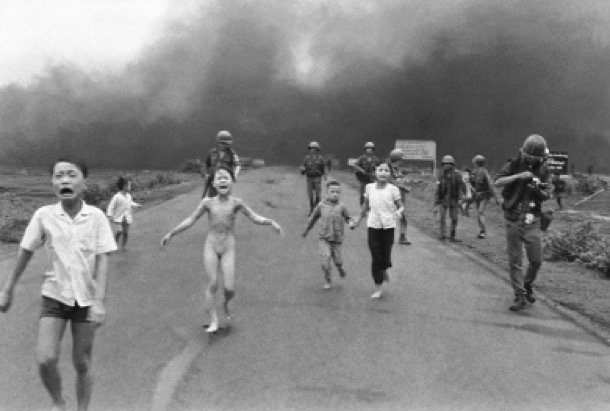
Protest was bitter and violent.
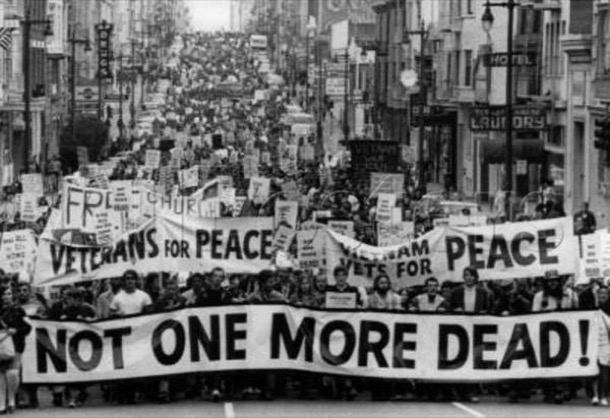
By 1975 Saigon had fallen: a humiliating defeat for the USA.
There was more violence as Pol Pot and the Khmer Rouge murdered 1.7 million Cambodians, and on the other side of the world, the IRA fought for British withdrawal from Northern Ireland.
Rapid advances in technology were in play, changing our world and planting the seeds for the creation of digital world, we are grappling with today. Apple launched the Apple 1, a desk top computer, pocket calculators were commercially available for the first time, and music became mobile with the release of the Sony Walkman.

In the popular music scene, Elvis Presley died, the Beatles split up, the Sex Pistols band recorded an album and disco music took the world by storm.
In Australia, at the beginning of the decade, Gough Whitlam led the Labour Party to victory in the 1972 election. This ended twenty-three years of unbroken Liberal-Country Party Coalition government.
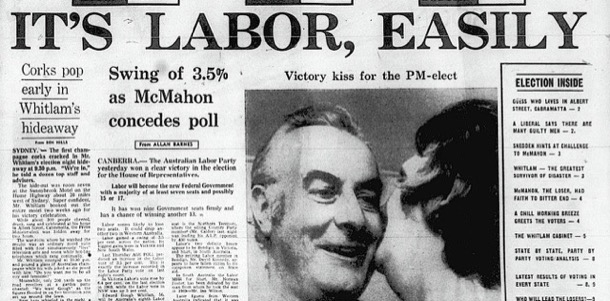
Change was inevitable and rapid: the troops were brought home from Vietnam; educational reforms were introduced, such as free University education; and Whitlam visited the feared red menace, Communist China. Inept financial management, scandal and the rate of change contributed to another landmark event now known as, The Dismissal. Whitlam was sacked by Kerr, then Governor General.
Gough Whitlam stood on the steps of Parliament House and declared “Well may we say ‘God save the Queen’, because nothing will save the Governor- General”:
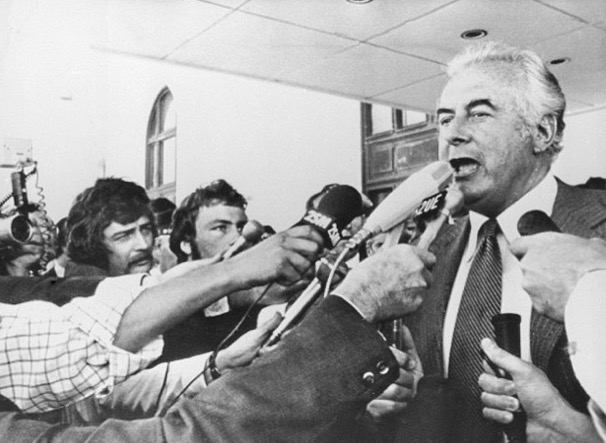
The Liberals returned to power under Malcolm Fraser. For Labour supporters like us, it was a bitter pill.
Waiting in the wings was Bob Hawke, who was both President of the ACTU and President of the Labour Party. The 1970s ended with Hawke deciding to enter politics. He was elected as the member for Wills in the 1980 election and Labour was once again in power. The 1980s in Australia was Hawke’s and Paul Keating’s decade. The reforms they ushered in changed the face of Australia: we thought for the better.
At the beginning of this tumultuous decade Margaret and I were fancy free. We moved out of home, sharing a house and living on our teaching studentships, as university education was not yet free. Margaret supplemented her income, paid $1 an hour, working at the first fast food outlet in Bourke Street. Working the late shift posed no danger as the Derby closed about 11 pm [very late] and Margaret was able to walk out to her Morris Minor parked right outside the restaurant. “It was always easy to park in Bourke Street, there were lots of parking spots,” remembers Margaret. It was such a different city then. We also embarked on our teaching careers. I began my teaching career in Sale and Margaret at Moe.
We had wonderful camping holidays, often in the Snowy Mountains; we saw interesting alternative movies at the Walhalla picture theatre in Richmond; we went to Sydney on the train to see Hair and saw nudity on stage; so risque! We listened to the Beatles, The Seekers, Cat Stevens and Peter Paul and Mary amongst others, on vinyl of course.
Margaret had begun teaching at Moe in 1973 and Jono and I, after a year overseas, both taught at Drouin High School, quite nearby. By the end of the decade, I had given up teaching and was at home at Gowar Avenue with a three year old Anna. Margaret was teaching at Croydon and was living in Gully Crescent with Ken.
Conclusion.
Marge and Alice finished their oral family history with their weddings and the end of the Second World War. It was neat: 1850-1950. It left off when they were both about thirty, settled into the business of raising children.
We are finishing our own overview at the corresponding stage. For us, this is 1980.
In the very last minute of the recording Alice, by herself for this part of the process, reflects on the speed of technological change that she and Marge had witnessed in their lifetime.
“But there’s a sort of corresponding suddenness in those new technologies and we tremble, as we think you do too, at what the outcome of all this is going to be for your children.
So looking back over that hundred years, we see this period of rapid, strong and significant development: a development that began gently enough, but now, in 1990, is rushed and killing and devastating.
And we look forward into the future for you and for our grandchildren as a time where perhaps you will learn what de-development is all about, and maybe the graph is going to go gently and firmly and calmly for you, into a period that is not as frantic as the one we’ve lived in.”
Strikingly and shockingly, the suddenness and the devastation she speaks of in 1990 has not diminished, but increased. And now, in 2018, as we watch our own grandchildren navigating their way into the world, we too tremble at what the outcome of “all this” will be.
A Great Sorrow
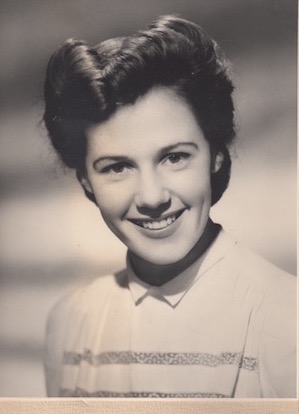
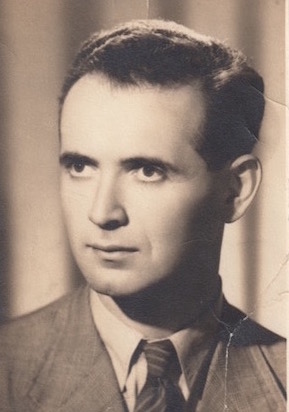
Our mother's sister, Marge, who had been close to marrying an American Serviceman during the war, had had a whirlwind romance with George Rostos, a Hungarian Jew, who had emigrated to Australia during the war. His parents, who were later to join him and Marge in Australia, had been in a Nazi concentration camp. George and Marge were married in 1945, the year the war ended.
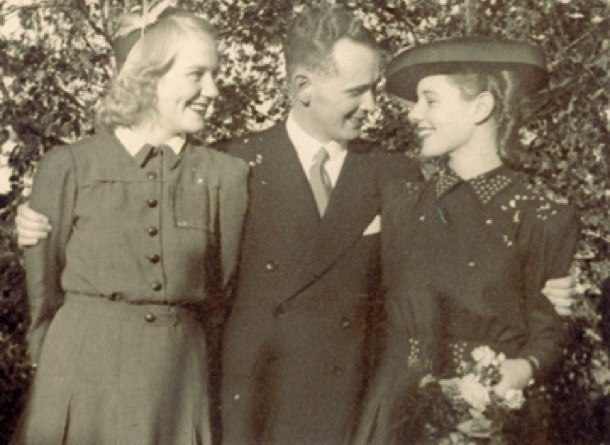
From left: Alice, George and Marge
Jim and Alice, our parents, were married later the same year. A busy year, as in October of that same year, George was offered a job in Sydney at the CSIRO. It was an exciting and welcome offer but it led to “a great family sorrow” as George and Marge moved to Sydney. They travelled to their new life on The Spirit of Progress, then a steam train.
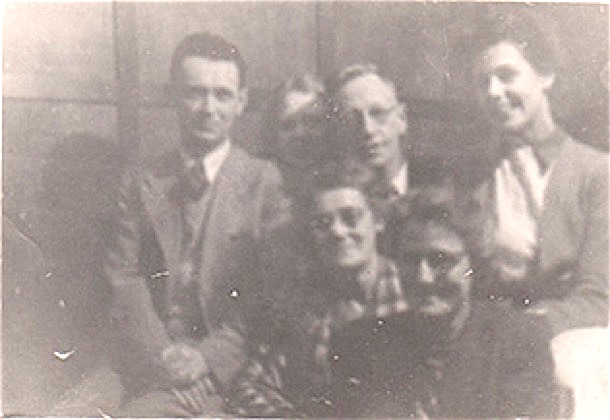
The family gathering the night before. From left: George, Alice, Freda, Alf, Auntie Bert and Marge.
To us in the world of instant communication and Skype we may think, “What’s all the fuss about, it’s only Sydney?” But, in1945, five months after World War 2 ended, it was quite a different matter. During the war people had not travelled much, and even long distance train fares were expensive and airfares, prohibitive. Once the train pulled out of the station one of the few means of communication was by letter:
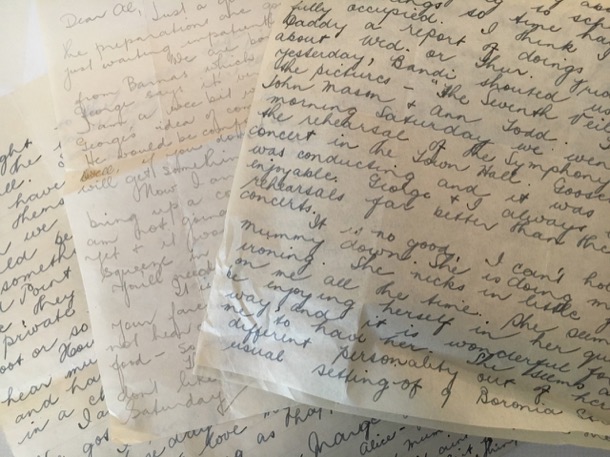
The only other means of communication was by telegram. Telegrams were expensive, as you paid per word, and therefore they were usually only used in emergency. You would take the message to the post office where it was translated into Morse Code, and then transmitted along telegraph wires, decoded at the other end and delivered to your home by the telegram boy on his bicycle.
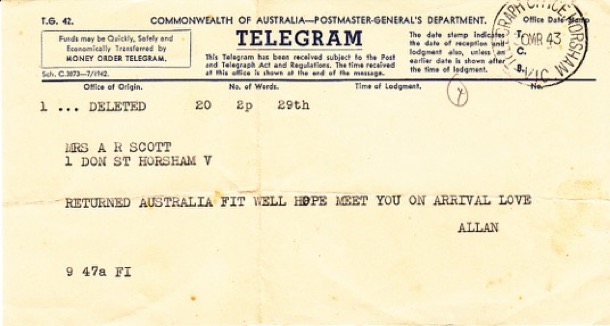
LIFE IN SYDNEY
And so began their new life in Sydney. The first three places from 1945 to 1949 were all in fashionable, post-war, cosmopolitan Sydney.
Marge and George had only known each about a year when they moved to Sydney. Marge speaks of their friendship group in Sydney, including Bandi, with whom they lived, as Hungarian Jewish refugees. What an amazing new world she lived in! Rose Bay and Potts Point were, and still are, in the heart of fashionable Sydney.
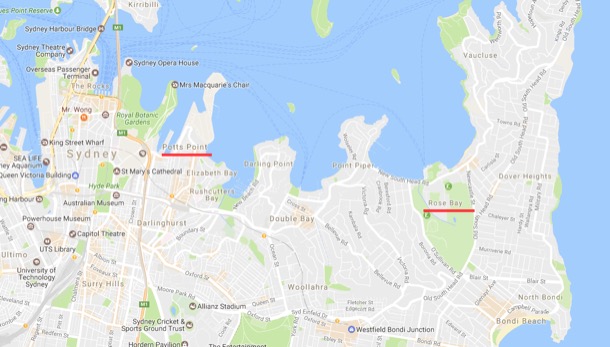
Marge speaks of watching the flying boats landing at Rose Bay. It had been a busy “airport” during the war, and, in 1945, was still used for overseas travel.
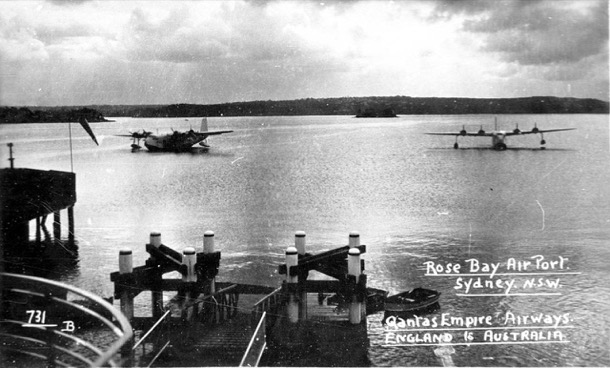
POTTS POINT
Their exciting new life continued in another inner city apartment.
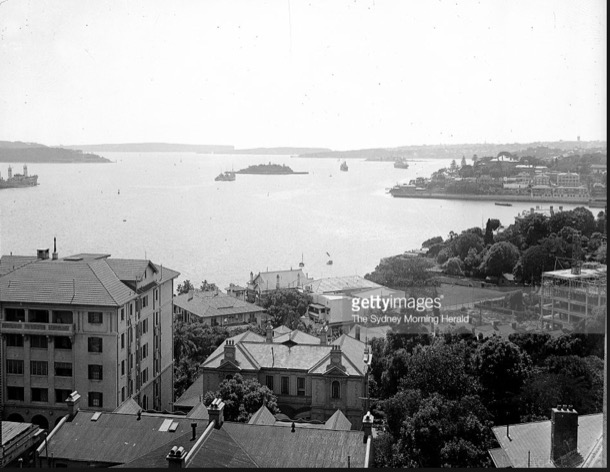
Potts Point is right on the harbour.
BELLEVUE HILL
Bellevue Hill, where Marge and George lived for three years from 1947, is in much the same area of Sydney.
They shared this flat with Phyllis, who seems to have worked in a job where she had access to otherwise unobtainable items. Marge speaks of her often in her letters.
These two extracts are from letters Marge wrote to Alice from Bellevue Hill, in 1947:
We, George, Phyllis and I, went to the beach (Tamarama) yesterday. Phyllis got let down by one of her blokes whom she had quite a crush on and she came with us. I must admit she took it with great dignity and amusement, though I know she was a bit crushed. So we sunned from 11 o'clock till 3. George and Phyll went nicely pink, but I did not change from my pale putty.
The job is still quite within my scope. i mean the two jobs. Phyllis helps a lot and, even if she is not home for dinner, never neglects to make us a delicious sweet from her American Cookery Book and peel some veggies for me.
She helps in many small ways which are not noticeable too, and I often go to do a small job to find it is already done. She brings lots of things from the planes - fruit and soap and face tissues; and brings me Persil (laundry powder) and Lux (toilet soap) and Velvet Soap (used for washing dishes, floors, surfaces, hand washing clothes etc), which have been unobtainable here for months.
This one was written acknowledging a birthday present:
I am so terribly thrilled with the cloth. When i first opened it I thought you must have got cloth at some art shop with stamped design and spoked hem and advised colours, but on reading your letter I find it is all a family affair and I am truly amazed and pleased with your taste and industry. Did you really do that spoked edge all on your own? I just love the colours, especially as my favourite colour is yellow. Thank you darling so very much. I shall cherish it and wash it so carefully and it will only be used on very special occasions. Tait also gave me a cloth - a beige one, very tasteful and good material. She also gave me a coffee pot to go with my set. Stephen left me a beautiful round cloth in Hungarian lace too, so i am not so badly off now. Phyll bought me a butter knife, a rolling pin and a beautiful round crystal bowl with two little handles and that engraved work around the sides- grape design and I love using it. I am now serving up my meals continental fashion these days, piling everything on dishes in pretty patterns and let the folks serve themselves. - It’s fun…..
…….if George were Australian I would certainly encourage him to take a job in Melbourne, but good jobs for foreigners don’t grow on gooseberry bushes. Here is an example: Last week Knox Schlapp advertised for a clerk. Several people called and one among them with a German name. I announced him to Mr Shaw who said to me, “That’s a foreign name. Is he a foreigner? I don’t want to see him.” I had to go and tell the chap to go away, and he had by far the most intelligent face of all that we interviewed. (Mr Shaw doesn’t know that George is a foreigner) They are turned down before even given the chance. Then again, George is not treated as a foreigner out there (CSIRO). In the atmosphere of prize scientific research, which exists there, such things do not matter and he is gaining the confidence and poise which he certainly would not out in the industry and commercial field.
SEVEN HILLS
Life was to change dramatically for Marge and George when they moved out of fashionable, lively Sydney into a house in a newly developed housing estate at Seven Hills, 37 kilometres west of the city.
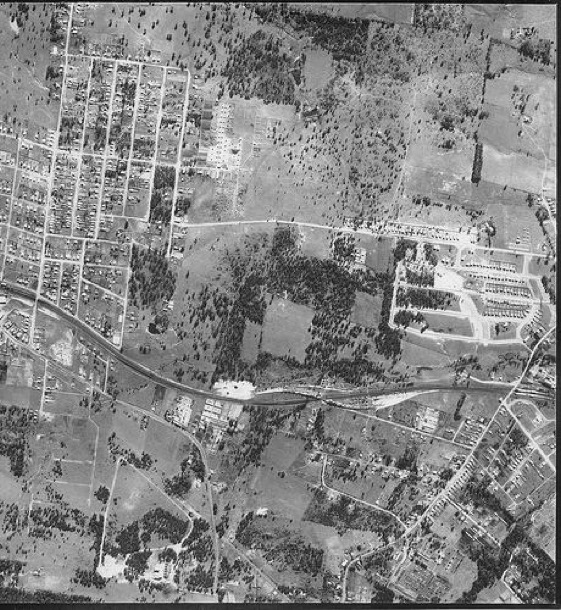
Seven Hills Estate in 1945.
It was not until the mid 1950s that George finally got a job in Melbourne CSRIO, and they all moved back to live close to their family.
The Demon Drink
It was clearly uncommon for anyone in our narrow anglo world to drink at home. Here, for instance, is an extract from a Primary school resource book on Temperance from the 1950s.
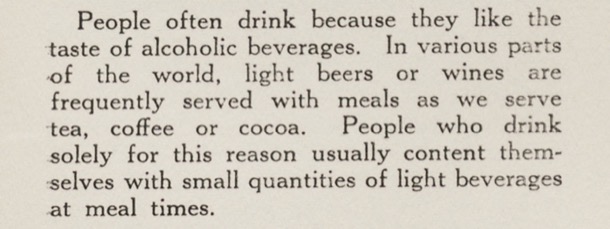
The international Temperance movement was one of the most powerful social movements of the 19th and early 20th centuries. Its advocates regarded alcohol as a social evil and sought to have it banned entirely, or at least its consumption drastically reduced.
Initially it was just a move against drinking spirits and “hard liquor". But during Victorian times it became more a push for total abstinence and became more specifically a women’s movement, connected with Protestant Christianity. Groups of women activists were to be found right across the western world.
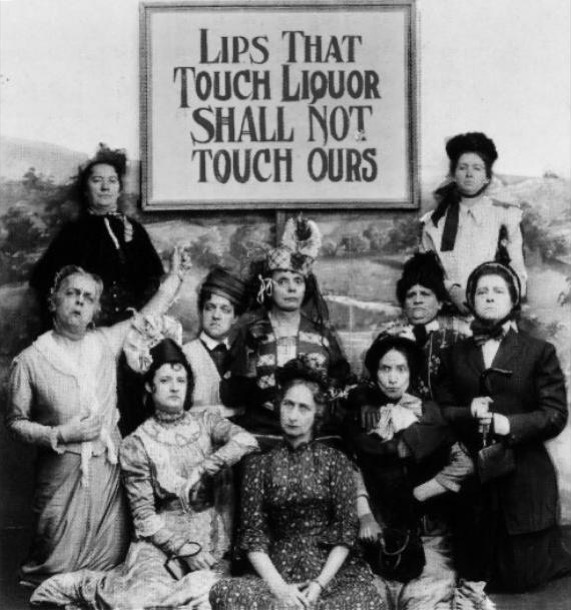
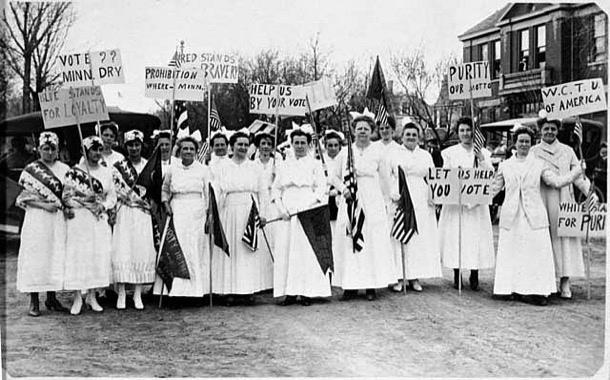
The Temperance movement had its most obvious success in America, where the sale of alcohol became illegal across the whole country overnight in 1920.
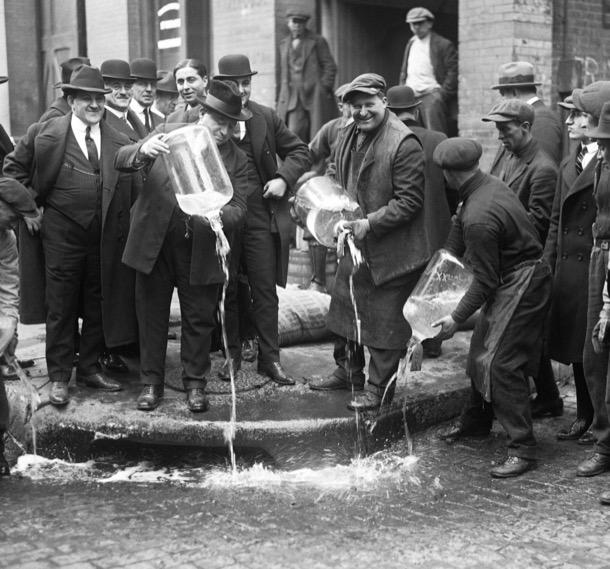
This period of American history has become known as ‘Prohibition”, the Roaring Twenties. It conjures up images of gangsters, speak easies and moonshine. The law did not have the support of much of the population. But it wasn’t until 1933 that it was finally repealed.
In Australia the temperance movement did not succeed in having the ‘demon drink’ banned but it did lobby vigorously for restriction of hotel opening hours. By 1923, hotel opening hours were restricted in all states. The closing of hotels at 6.00 PM led to a phenomenon known as the ‘Six O’clock Swill’.
It is hard to believe looking back that the daily rush to the bar was part of everyday life. Rather than limit drunkenness it actually encouraged it, as men who ‘knocked off’ work at 5 o’clock had only on hour in which to drink. Hotels were set up to serve as many beers as were demanded in this hour. Pubs were overcrowded, as men five or six deep lined the bar waiting to be served and patrons spilled out into the streets.
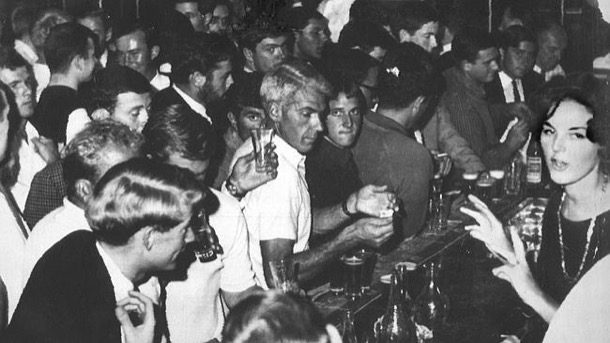
Pubs did smell strongly of beer as so much was served in such a short time. Sue can remember walking past Young and Jacksons on her way home and pushing her way through the throng of men, spilling out onto the pavement on the corner of Flinders Street and Swanston Street. Men, yes only men! Women were not permitted in the Bar until the early 1960s and for many years after that it was frowned upon. We can remember conversation stopping momentarily when we first walked into a bar particularly in the country.
The Demon Drink indeed! We come from a long line of teetotallers: our great grandfather Reverent Alfred Coates, our great aunt Sister Bessie, our maternal grandparents, Alfred and Alfreda, their siblings and our parents. Our mother’s family, the Coates, being staunchly Methodist, we imagine would have been very sympathetic to the temperance agenda. Here is Alfred, in his Methodist pastor uniform with Emma and their daughter:
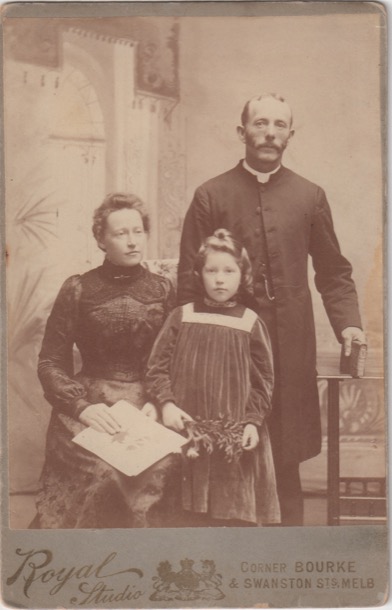
We were very aware as children that none of our family touched alcohol and that particularly frowned on by our rather upright Grandfather.
We too, at the tender age of eleven of twelve, have had our brush with The Independent Order of Rechabites, who provide educational material for Victorian Schools.
Alice and Marge as old ladies recounted their childhood memories of drunkenness, in the country town of Croydon during the 1930s, with obvious disapproval and distaste. Here they discuss the public drunkenness they witnessed at the hotel and wine hall near their house:
I remember our aunt having a glass of beer at the dinner table, when we were staying there as children. I commented on it and I remember being rebuked. Later our mother told me that it was medicinal, that she had found that drinking beer with food helped her digestion. That mum had felt the need to explain it that way, and that our aunt had reacted so strongly to a child’s interest is understandable in the light of heir own childhood experiences and family attitudes.
And then, during our late teens, as the 1960s became the 1970s, this part of our past just melted away. It became normal and natural too open a bottle of wine to share. There was binge drinking around us, especially at Uni parties, and the drink driving hazard was evident, but the moral dimension, the “holier than thou” attitudes, the raised eyebrow were all gone. Society had grown up about the same time that we did.
.
War Service
Our family stories research has led to the discovery of four great great uncles: four brothers who were soldiers. They were four of the seventeen children of Martha and Joachim of Heather Farm in Wandong, about whom we wrote in "The Poor Little Thing" on June 8th, 2016 and "Heather Farm" on August 3rd, 2016. Our maternal grandfather Alf, was their nephew.
Learning their stories, imagining their experiences, fitting their details into the wider sweeps of military history has been enthralling and rewarding.
We present the four Dau (Dow) brothers, Frederick, Arthur, Charles and Walter.
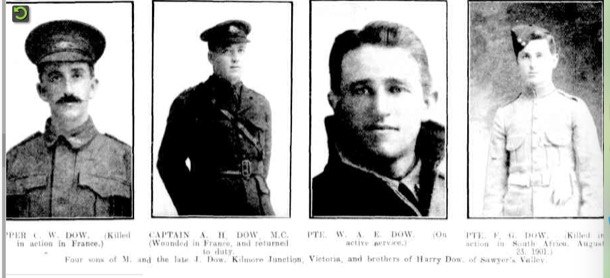
Frederick and Arthur actually enlisted as Dow, an anglicised version of Dau. It is a constant confusion.
PRIVATE F. G. DOW
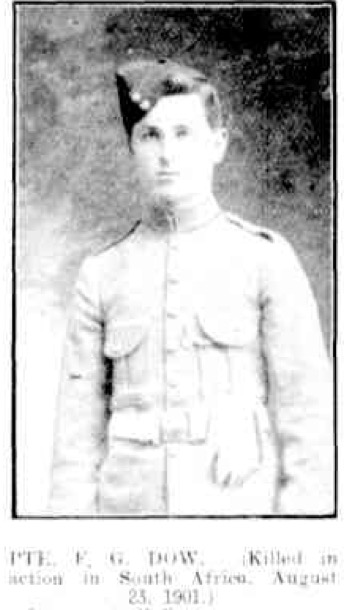
Australia was twenty-eight days old when nineteen year old Frederick sailed on The Orient out of Melbourne, bound for South Africa and the Boer War. His company was the Fifth Victorian Mounted Rifles.
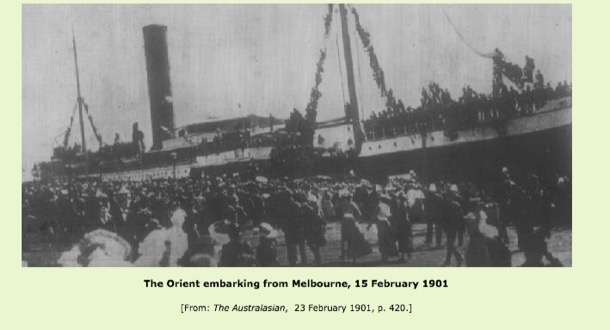
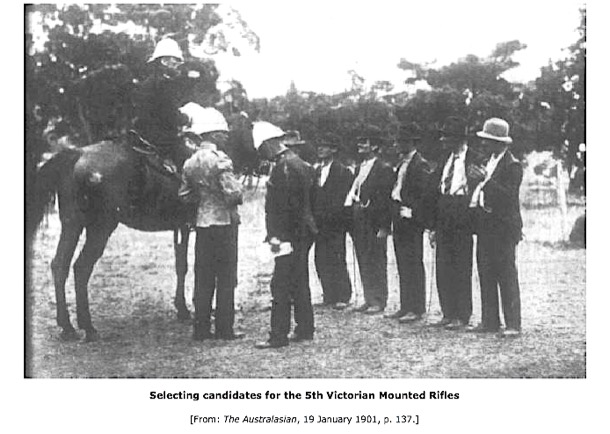
Britain had colonised the southern part of South Africa eighty years earlier and had had an uneasy relationship with the other colonisers of this area, the Dutch Boers, who had been there for a hundred and fifty years longer. Tensions had escalated to war in 1899, and the British Empire was required to send troops to participate.
By 1901, the war had become a drawn out guerrilla affair mostly in the desert-like Transvaal area with small groups of Boer soldiers attacking and then disappearing back into the harsh dry landscape.
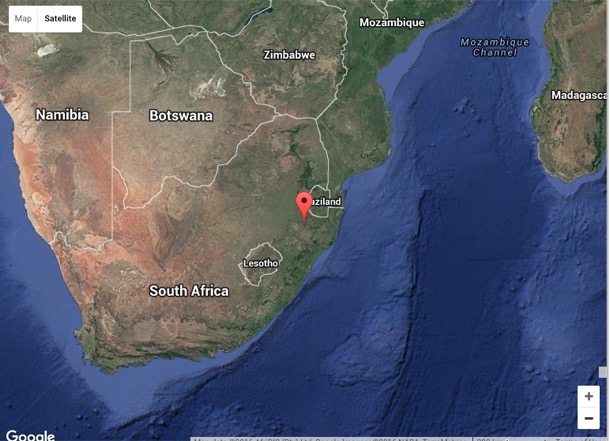
Many of the “colonial” troops, like Frederick were bushmen, tough, self reliant and skilled at shooting from horseback: exactly the set of skills needed for this type of warfare. But it was very hard on men and horses alike. Most of the fighting took the form of small skirmishes, but sometimes the men had to attack remote farmhouses, confiscate the livestock, destroy the farms and escort the women and children to the notorious concentration camps where thousands died. R G Keys of South Moorabbin wrote of making captures of large numbers of prisoners and cattle and having brought in large numbers of Boer families. “We have also burnt thousands of acres of grass and a number of farms and have destroyed everything of any use to the Boers.”
They spent long periods in the saddle with few opportunities to bathe or change their clothes; lice were a constant problem. Temperatures on the veld ranged from relentless heat during the day to freezing cold at night.
Private F W Collins wrote, “What I can see of the war is that the Boers can keep it on as long as they like, the only way is to starve them out. They get right in the mountains, and there are bullets whizzing about you and you cannot see any enemy. We are going from daylight till dark, up at 4 o’clock in the morning, and it is sometimes midnight before we get in again, so you can imagine we feel quite knocked out. When I get back to old Victoria I’ll do nothing but sleep.”
We don’t have much detail about Frederick’s death, but Lord Kitchener, Field Marshall in charge of the war, reported in one of his dispatches: "on the 23rd August Lieutenant Colonel Pulteney had a sharp engagement with the enemy on the west side of the Schurveberg, in which the Victorian MR (Mounted Rifles) had 2 men killed and 5 wounded.” One of those two men killed was Frederick Dow.
Two years later, his mother, Martha, and brother Harry inserted this memorial in the local paper:
In loving memory of dear Fred, who was killed in battle near Vryheld, South Africa, August 23, 1901; aged 19 years and 6 months.
Tis two sad years ago today,
The trial was hard, the shock severe,
To part with one we loved so dear.
He is gone, but not forgotten,
Never shall his memory fade;
Sweetest thought shall ever linger
Round about our soldier’s grave.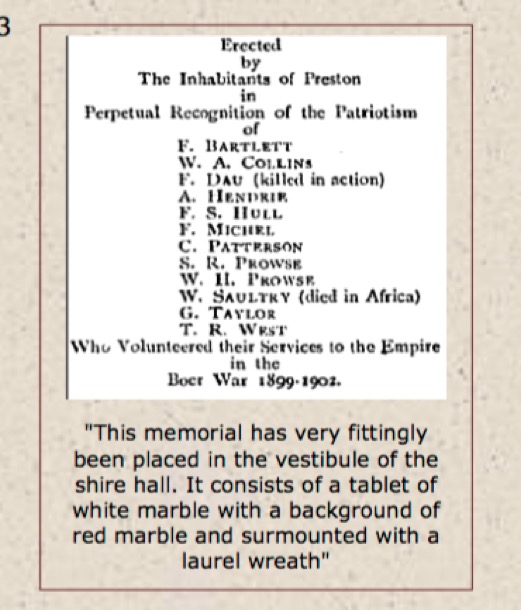
MAJOR A. H. DOW
Arthur was on one of the first ships to leave Melbourne for the war. He sailed from Station Pier Melbourne on the Orvieto on October 21st 1914. There were huge crowds to wave off this first wave of volunteers.
Soldiers from the Orvieto disembarking at Egypt: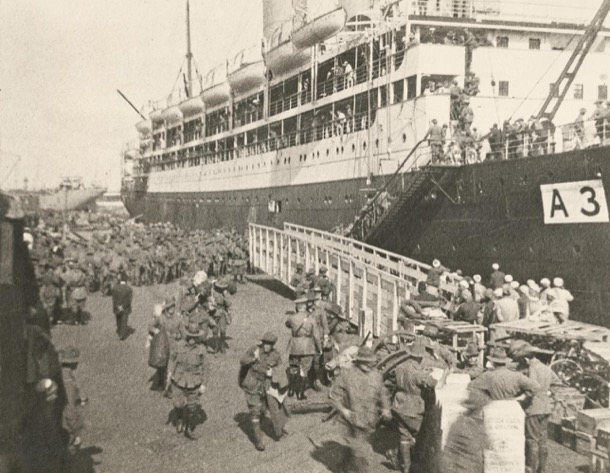
Arthur was a career soldier. He had joined up as a military engineer, aged seventeen in 1908 and had already been promoted to Warrant Officer.
Like all of those first soldiers, after a short time in Egypt, Arthur was dispatched as part of the Mediterranean Expeditionary Force to what would become known as Anzac Cove, Gallipoli. He was there for the very first Anzac Day landing, but went ashore “several days” later. He must have watched from his ship as the first few waves of shore boats struggled amid Turkish bullets and shells that rained down from the cliffs. By the time it was his turn, things were still very chaotic and dangerous. It took ten days for the troops to be safely dug in.
On June 16th, he was Injured and was treated at the hospital on the Greek island of Lemnos.
He went back to Gallipoli ten days later.
At the beginning of August, Arthur was detached for duty to Assistant Adjutant General 3rd Echelon in Alexandria (which dealt wth military discipline, though he was in the “records section&rdquo![]() .
.
By March 1916 he was with the Fourth division engineers at the huge Anzac training area near Cairo, called Tel-el-Kebir, a six mile long “tent city”, where he was promoted to 2nd Lieutenant.
He must have participated in the notorious three day march across the desert in searing heat to Serapeum, on the Suez Canal.
Here there was more training, in preparation for the move to France, and he was promoted again to Lieutenant. On June 2nd, he travelled on the ship “Kinsfaun Castle” to Marseilles, in the south of France.
The next mention in Arthur’s record is six months later, in January 1917, where he is “mentioned in despatches” (a sort of honour) and then again on June 26th, where he is promoted to Captain.
We know what he was involved in during those couple of years in France and Belgium because we know what unit he was in.
He fought at Ypres and Messines Ridge and Passchendael: all infamous places in the history of the first world war.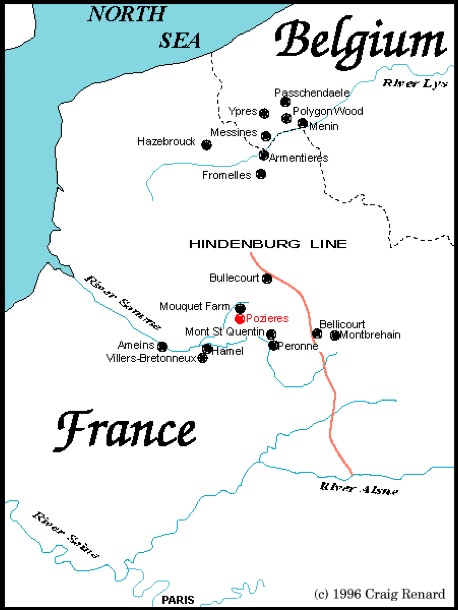
It was for his work from 24th September through to 24th October that he was awarded the Military Cross.
Arthur was a military engineer. Engineers, also known as sappers, were essential to the running of the war. Without them, other branches of the Allied Forces would have found it difficult to cross the muddy and shell-ravaged ground of the Western Front. Their responsibilities included constructing the lines of defence, temporary bridges, tunnels and trenches, observation posts, roads, railways, communication lines, buildings of all kinds, showers and bathing facilities, and other material and mechanical solutions to the problems associated with fighting.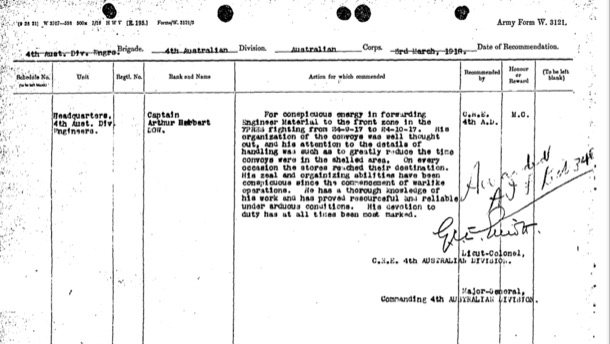
At the time Arthur won the Military Cross, the 4th Division was involved in the battle of Polygon Wood and then the third battle of Ypres, Passchendaele. It is from the Ypres-Passchendaele area that we get the iconic images we have of trench warfare in a landscape of deep mud and water filled shell holes with broken off toothpick trees, stretching away into a hazy distance; where falling off the duck board paths meant drowning in mud. By the time Passchendael was captured in November 1917, the Australians had fought for eight weeks and suffered over 38 thousand casualties.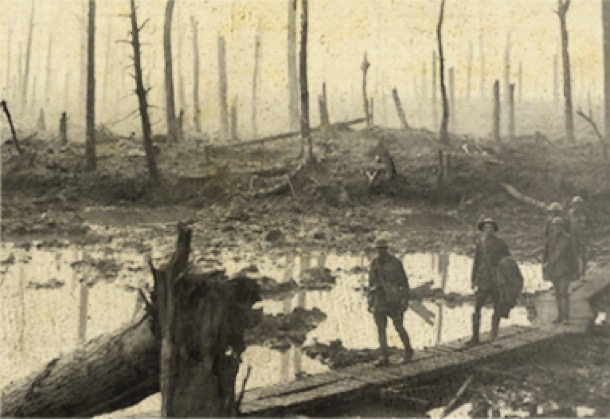
At the beginning of December Arthur had a fortnight’s leave in Nice, Italy and on his return he was sent to England to Brightlingsea to train engineers. It must have been a welcome break, but he was back in France by May, 1918.
He was wounded in action on August 8th. At that time his company, the 14th Field Company Engineers was laying wire barriers across the area to be advanced upon in front of the village of Villers Brettoneux. They were harassed by constant German shellfire, and snipers.
The resulting battle was called the Battle for Amiens, and was a resounding success, although between August 7th and 14th, the Australians lost six and a half thousand men.
Arthur left for Australia on September 27th, and within six weeks the war was over.
He remained in the services for a few years. In 1920 he had a few months’ successful treatment for “depression and irritability”. On his application form, where he had to provide supporting evidence for his entitlement to this help, he wrote a single word: “Anzac”.
By 1940, one year into the second world war, Arthur, who had been working in a Government desk job in the civil service, rejoined the army as a Major. He was 49, married with two children, and living in St Kilda.
His war this time, was fought at a desk, sometimes in the Middle East and sometimes back in Australia. His war record mentions positions like “Hiring and Claims”, “Accomodation and Quartering”. He left finally in October 1945, aged 54. During this time he had treatment for an affected patch of skin in his mouth. The doctor mentions that this is the spot where Arthur’s pipe customarily sits.
The last mention of Arthur in the war record is application for repatriation consideration for a minor health issue. He was a healthy 72 and living in Boronia.
SAPPER C.W. DAU (DOW)
Like his brother Arthur, Charles enlisted as a sapper, or military engineer. He joined up in February 1916 in Hamilton, where he had been working as a railway “ganger”. He was thirty, slim, fair haired and blue eyed and was married to Edith, who was still back in Wandong with their three children.
He left for Europe in April and by October had joined the Second Division in Belgium, before marching to the Somme area in France. His division was involved in attacks on a collection of German trenches known as The Maze,
The main Somme fighting came to an end on 18 November in the rain, mud, and slush of the oncoming winter.
Over the next months, winter trench duty with its shelling and raids became almost unendurable and only improved a bit when the mud froze hard. The wet and the cold made life wretched. Respiratory diseases, “trench foot” – caused by prolonged standing in water – rheumatism and frost-bite were common. Many survivors would later say that this was the worst period of the war and that their spirits were never lower. Large-scale fighting did not resume until early 1917 when spring approached and a German offensive re-took areas previously heavily fought for.
Charles remained with the sixth field company, second division throughout. By the middle of 1917, they were in action in the mud at Passchendaelle. Charles’ brother Arthur was there too, with a different division. Eight weeks of heavy fighting took a huge toll on Australian troops.
At the end of 1917, he had a three week leave in England, returning to his unit in December, just in time for the German Spring Offensive, aimed at retaking Ypres in Flanders. The second division were involved in Messiness until March and then the battle of Lys in April. In June they participated in the very successful Battle of Hamel.
The Allies finally began to push the Germans back. Charles was involved in the Battle of Amiens and other attacks from the village of Villers-Bretonneux.
Then, on July 23rd, after weeks of very heavy fighting, Charles was affected by a mustard gas shell.
A letter to his wife, Edith, written in August the following year explains the story from here: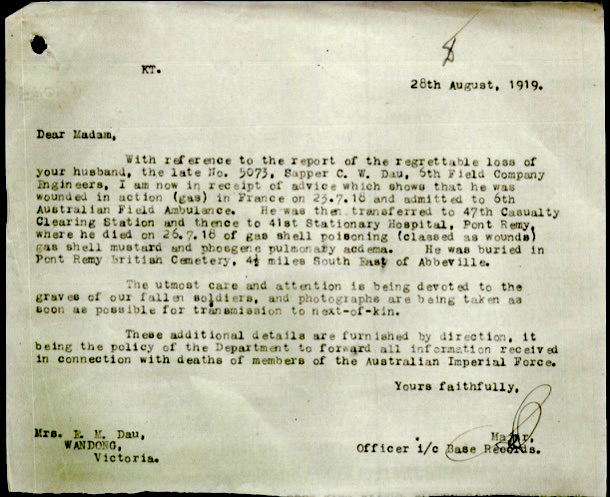
Edith received a parcel containing Charles' last few possessions: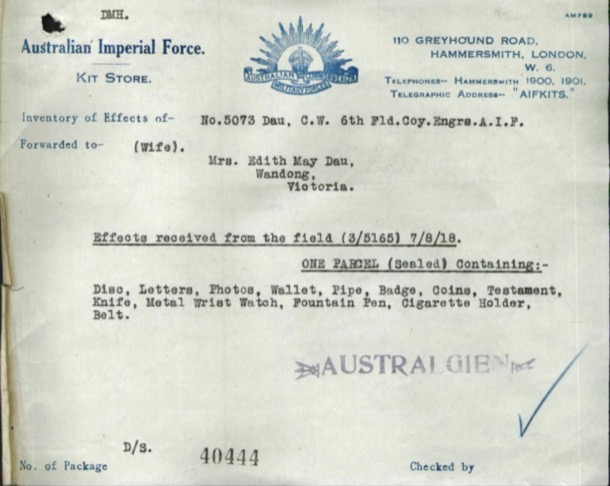
From Charles' military record: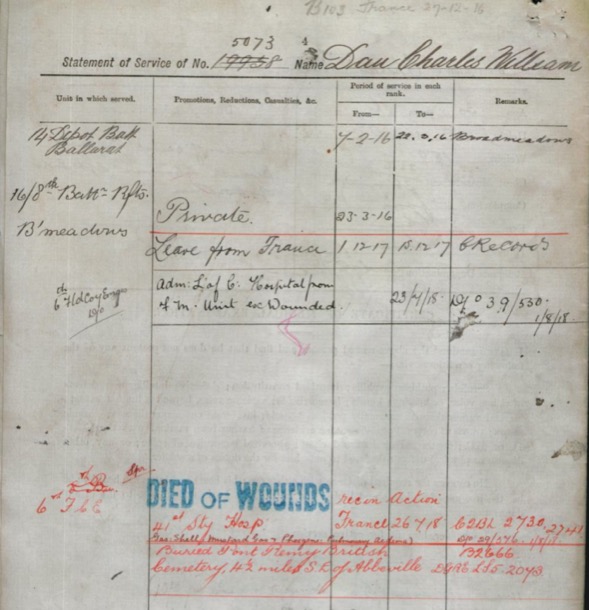
Mustard Gas
Chemical weapons were first used in World War I. They were primarily used to demoralize, injure, and kill soldiers in trenches, against whom the indiscriminate and generally very slow-moving or static nature of gas clouds would be most effective. 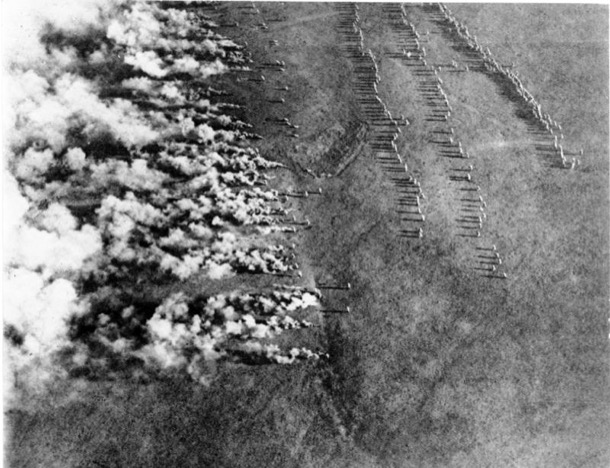
Some gases used actually killed soldiers, but mustard gas was more a disabling chemical. On initial exposure, victims didn’t notice much except for an oily or “mustard” smell, and so the first men exposed to this “mustard gas” did not even don their gasmasks. Only after a few hours did exposed skin began to blister, as the vocal cords became raw and the lungs filled with liquid. 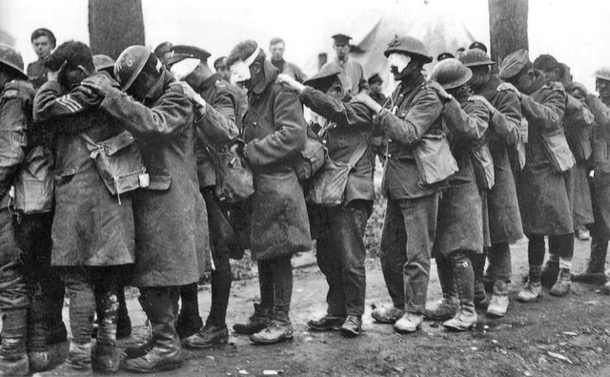
Even if they did have their masks on, they developed terrible blisters all over the body as the gas soaked into their woollen uniforms. Contaminated uniforms had to be stripped off as fast as possible and washed - not exactly easy for men under attack on the front line.
Affected soldiers died or were rendered medically unfit for months, and often succumbed years or decades later to lung disease.
As the war went on both sides used various protective masks, and gas became less effective as an actual weapon, though its psychological power was enormous and both sides continued to use it . By 1918, one-third of all shells being used in World War I were filled with poison gas.
One nurse, wrote in her autobiography, "I wish those people who talk about going on with this war whatever it costs could see the soldiers suffering from mustard gas poisoning. Great mustard-coloured blisters, blind eyes, all sticky and stuck together, always fighting for breath, with voices a mere whisper, saying that their throats are closing and they know they will choke."
PRIVATE W.A.E. DAU (DOW)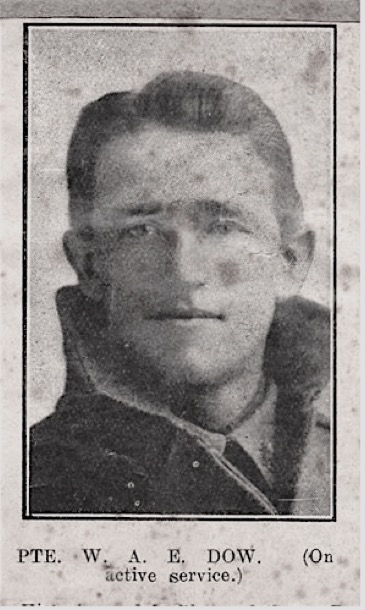
Walter Albert Edward Dau the third youngest and according to Marge and Alice ‘the black sheep of the family’ enlisted in the AIF in November !916. Wally’s medical record describes him as having fair hair and blue eyes. He was twenty-seven, unmarried and a motor driver by occupation. He sailed for England in March 1917 with reinforcements for the 21st Infantry Battalion and he returned to Australia in October 1922, where he was discharged from the Army in December of that year. On the tapes Marge and Alice recall that he was apparently a bit bookish and lived ‘as a bit of a hermit in Noogee.’ He died in 1974 maybe in Queensland.
Wally arrived in England and was initially based at Rollerstone a huge Army camp on the Salisbury plain. New arrivals were sent here and the placed in other training camps nearby. Between stints in hospital, Wally was assigned to the 6th Signals Battalion and then after a final few months at Grantham Military Hospital was trained as a machine gunner. Wally spent almost sixteen months moving between training facilities and several military hospitals. 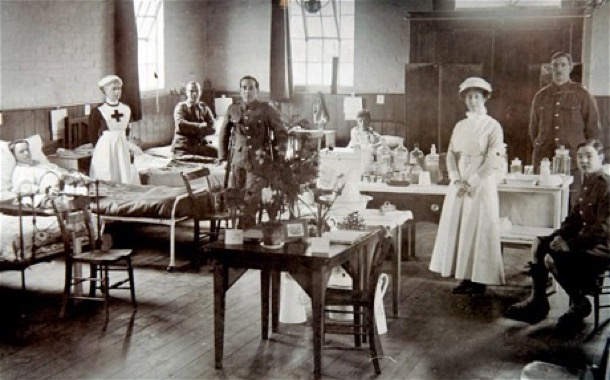
The handwritten records mention Synovitis a painful, chronic inflammation of the joints, a ganglion on his arm and ‘Hysteria NYD’ [Not Yet Diagnosed]. While Wally was undergoing one of his hospital stays, his brother Charles was gassed and died in France. Finally in October 1918 Wally was transferred to the Machine Gun Corps, 21st Battalion and he was on track to go to France. Fate intervened and Wally sailed to France on the 28th of November, seventeen days after the war ended.
It is difficult to know why Wally was so long in England, but one month after Armistice, Wally was in France with the AIF Graves Unit. The Commonwealth Graves Commission had already been established in response to the public's reaction to the enormous losses in the war. Their work in France was to ensure that the final resting places of the dead would not be lost forever.
From the very first battles in the early weeks of the fighting on The Western Front, the number of military dead was already in the tens of thousands. Graves and burial grounds situated in the area of a battlefront were often damaged by subsequent fighting across the same location, resulting in the loss of the original marked graves. 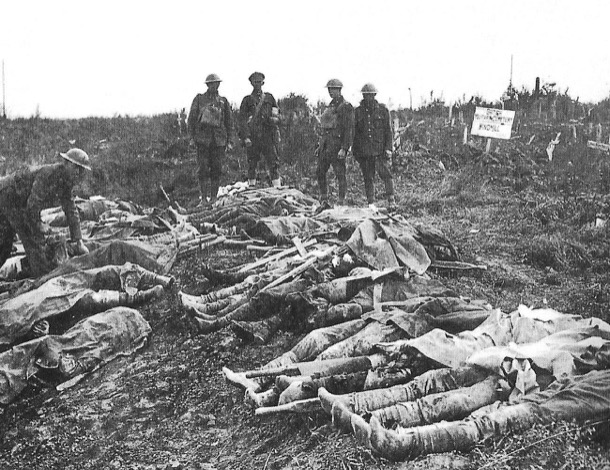
Some bodies simply could not be retrieved from underground.
Added to this, the technical developments in the weaponry used by all sides frequently caused such dreadful injuries that it was not possible to identify or even find a complete body for burial.These factors were generally responsible for the high number of “missing” casualties on all sides and for the many thousands of graves for which the identity is described as “Unknown”. The AIF War Graves Unit was responsible for the cataloguing of the dead and the construction of the monuments and cemeteries. 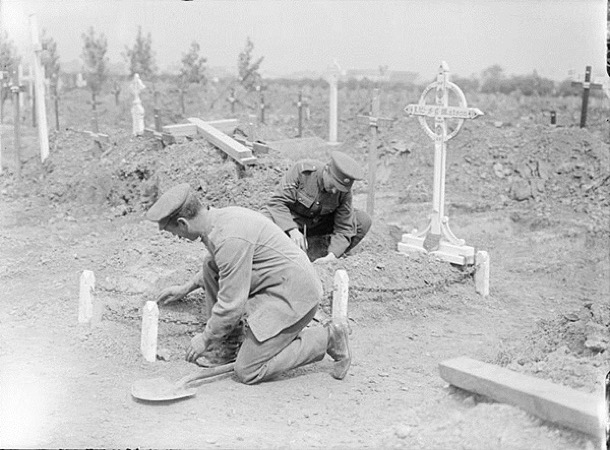
One wonders what Wally's reaction was to this overwhelming task.
Wally, however found distractions. He had a daughter!
Amongst his military records is a translation of a letter written in 1933. The letter is from Madame Thomasson of Avignon France.
‘Please inform me where to write to Walter Dau, Australian subject’ involved in “War Grave Construction work in Belgium, who sailed from England to Australia in 1922. I should be very much obliged if you would supply me with information as to the whereabouts of this person who is the father of my daughter, ……. in order to define her position and nationality.’
The letter may never have reached Wally as it was passed between the Defence Department and Australia House, London with no record of delivery or response.
Another distraction for young Wally was 42 days of incarceration after he was Court-martialled for: ‘Conduct to the prejudice of good order and military discipline in that he ……was carrying food, the property of civilians a motor lorry, without authority’
Wally pleaded Not Guilty but the charge was upheld. 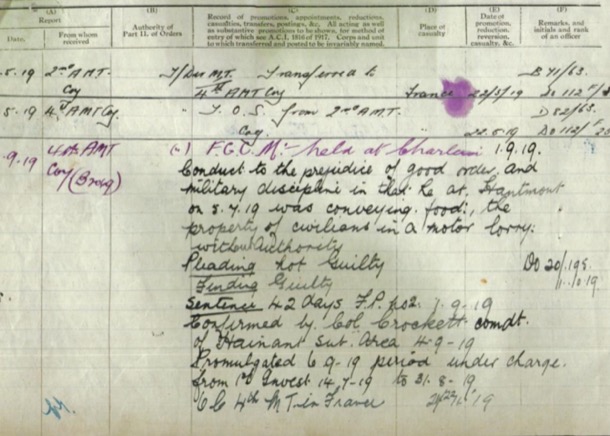
An interesting young man, many unanswered questions and a very different story to that of his two brothers who were in France during the fighting.
Heather Farm, Kilmore Junction ,1879
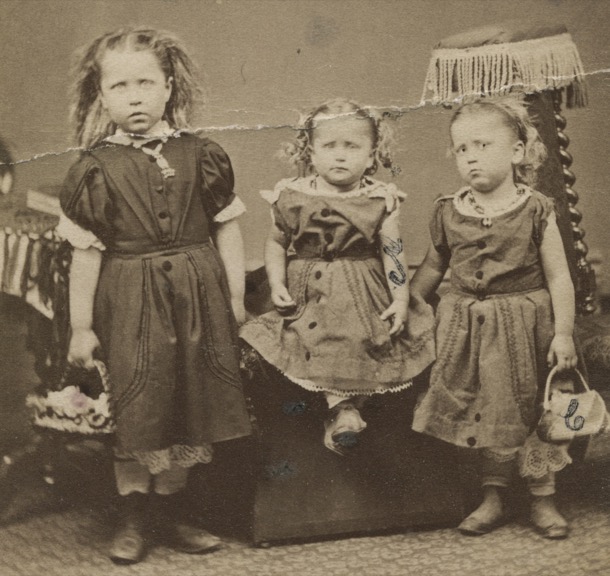
Sarah Dau aged 8, and two of her sisters, photographed in 1874.
Fifty Years Ago at Kilmore Junction HEATHER FARM
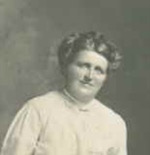
In a lonely spot on the hillside, where the old cypress still lives and bends in the breeze, stands what is left of our once loved home, so loved in those old days gone by when a dear father and mother still lived to help us unravel life's tangled skein.
There the musk tree, mother planted, and cared for and loved—just beside the straggling remains of the lovely lilac trees; there the remains of the old gum tree where father sharpened his axe in its groove, and we children watched and wondered what difference it made; the path where the strawberries grew large and juicy on each side; the vines and the currants and gooseberry bushes—what tales they could tell could they speak. Father's pear tree, once laden with its golden store, now old and scrubby, still fading away.
The dairy house still stands, but the hum of the separator is silent. The stable, where Polly and Lofty enjoyed their hard-earned rest and feed, the cow yards: oh, what memories of Blossom, Violet and Peggy do those few remaining stone paths recall.
There is the old slip-panel, where father stood to welcome the children with smiling face when home on holiday: dear, gentle Dad, from whose lips we heard no unkind word; the wild cherry tree, where the boys carved their names, still there, the same beloved handwriting, although one sleeps in France and the other in Africa—duty nobly done.
The corner where the raspberries grew, juicy and red, at Xmas time; our favourite apple tree. How we loved to run down and see how many our thoughtful mother had saved for us, her wanderers. Memories!
Sometimes we wander back again to where the old home stood, and as we stand and think of other happy days gone for ever and gaze on all this, we seem to hear their loved voices again speaking to us, their children, although some of us are on the shady side of 60.
What would we give to live some of those old times gone by, and a kind word from father and a smile from mother? Seventeen of us—their children—were reared up to manhood and womanhood on the site of that once beloved home. The silent bush: no picture shows, no evening entertainments, just our books and our church on Sunday.
Oh, to live it all again. To once more call dear old Blossom, Peggy, and Strawberry home for milking. To feed again those poddy calves. To turn the old separator. To hear the voice again of our dear old teacher—who taught 13 of our family before he went to rest. To walk to the old church on Sundays and then home, where mother had laid the snow cloth with all things good for tea (and home made), and then go to the back paddock for wattle gum, where the pink and white heath grew, and wattle blossom bloomed.
Dear old home, we shall never see again. Only in our memory there will live that lovely past, which for us all, too soon, has fled and left only memories of other days. Some of us would love to live again at dear old Heather Farm.
Sarah Coles (née Dau)
McEwan Road, Heidelberg. 7/2/1929
The Poor Little Thing
Marge and Alice, with great drama, tell the story of our great, great grandmother whose name they do not know, and her subsequent marriage to Grandfather Dow, with whom she had eighteen children.
They had little factual information and their story is obviously based on stories told to them by their father. “That’s how the tale goes and the imagination boggles,” says Alice at one stage and indeed it did!
THE FAMILY TALE would have us believe that the our great, great grandmother, name unknown, met her prospective husband, first name unknown, at the Victoria Market. She was apparently a child of fifteen dragged off by a middle aged man to a poor farm miles out in the country of early colonial Victoria. The long and arduous journey into the night finished at Wandong where the poor little thing, ‘rolled up her sleeves and started milking cows straight away.’ She bore eighteen children and did much of the work, as her husband, a German immigrant from Bavaria, who was rumoured to have noble blood, sat behind the milking shed reading poetry. The poor little thing lived to 83 and grew very broad in the beam. Her husband as the tale goes died at 102 sitting up in bed singing a hymn.
The mind does indeed boggle. Was she a poor little thing? How much is ‘tale’?
You be the judge.
We also have a story extrapolated from FACTS provided by the Victorian Records Office, Ancestry Dot Com, Google, newspapers, shipping records and documents from England.
The ‘poor little thing’ was Martha Rye born in 1850 in Geelong in the Colony of New South Wales. The year after her birth in 1851 the Colony of Victoria was founded and separation from New South Wales was formalised.
Martha Rye was the first child born in Australia to Adam (1822 - 1924) and Elizabeth (1824 - 1901) Rye, recently arrived immigrants to the young colony.
Adam and Elizabeth emigrated to Australia from South Lopham in Norfolk, England in 1848. They had with them one child, Marianne who was a year old. Adam was twenty-six and Elizabeth twenty-four.
Here is the South Lopham church in which they were married:
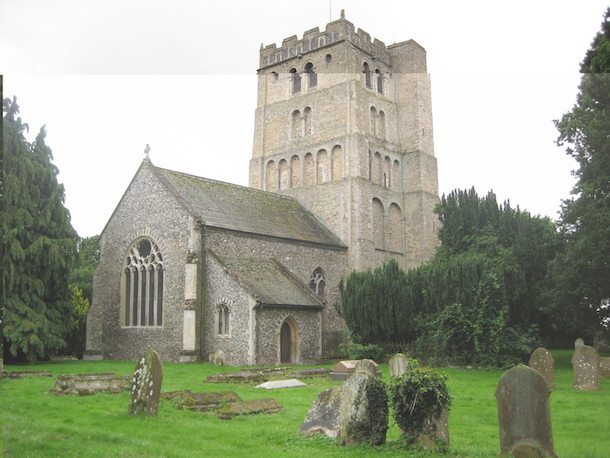
We know from the shipping records that they sailed on the sailing ship The Berkshire, arriving in Geelong on October the third, 1848. Their occupations were listed as labourer and housekeeper. He could read and write, she could read but not write.
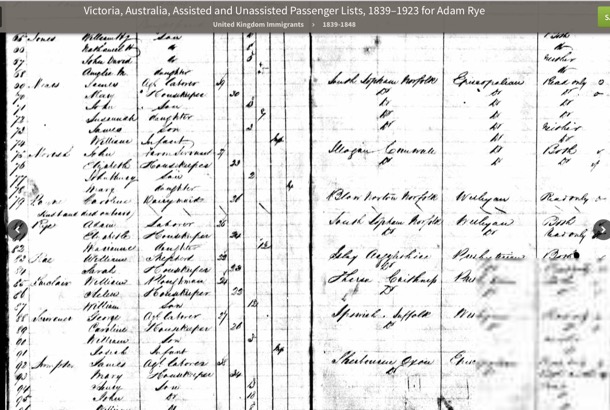
We know that he had indeed worked as a labourer on his father’s farm, but he had also had a stint as a footman in the household of Lord Randall, which is where he tasted a bit of Queen Victoria’s wedding cake, shared with the staff by Lord Randall, who had been a wedding guest.
When he and Elizabeth left for Australia, they sat down to a farewell dinner with thirty-two of Adam’s brother and sisters (from three different mothers).
Adam lived 102 years, and when he was in his nineties, his colourful life story was written up by an enthusiastic journalist for a local paper. Note his editorialising in the following extract about “treacherous blacks”.
The family settled near Geelong, where they rented a piece of land to farm.
“While here Rye went off one day to the store for provisions, and after getting his supplies started for home, but darkness overtook him and he lost the track. He wandered about for some hours, and at last came upon a party of about 50 blacks. He thought it was no use trying to run away so he had to stand his ground. The blacks took his supply of bread, cheese, tobacco and a bottle of rum away from him and divided them amongst themselves, never leaving him a bite. Towards morning he made them understand where he lived and they directed him to his home, but having found out where he lived they paid him a couple of visits at night time and carried off his potatoes - not any that came to hand but the biggest and best and potatoes were worth £30 a ton in those days. The blacks at this time were very treacherous. They would watch the mothers going away for water and would steal into the huts and carry away anything they fancied even occasionally stealing a baby, which was never seen again, the blacks having roasted it for the camp's dinner. After a time he left for Melbourne. While here he met the same tribe of blacks, who recognised him, although the years had passed in the interim.”
Martha, our great great grandmother, born in 1850, was the first of eleven of Adam and Elizabeth’s children to be born in Australia.
The family moved to Broadmeadows, where Adam worked as a farm hand, cutting thistles and maintaining fences, as well as farming a piece of land himself. The newspaper article mentions wheat, potatoes and onions.
Here is an extract about the Broadmeadows farm.
He had about 2 acres of and with a splendid crop of onions on it. He and his family had been working hard getting these ready for market and left them in heaps about the ground ready to bag next day. To their utter astonishment, on going to finish their work they found that somebody had done the work for them, and had carted the lot away. There were from 10 to15 tons altogether, and this at £8 a ton was no small item to lose. However, he made up a bit on his crop of potatoes, which, although a light one, brought in £30 a ton. Butter was then 3 shillings a pound, bread 1 shilling a loaf, and a bag of flour as high as £5 a bag. This was owing in a good measure to the high rate of cartage.
This was the height of the gold rush, and Adam was not exempt from gold fever. In this story the “Black Forest” is mentioned. We found that it was an area near Mt Macedon, and part of a common route to the gold fields.
He had only one experience at mining and that when the Bendigo rush broke out. He with about a party of 20 shouldered their swags and tramped to Bendigo. In crossing through the Black Forest, as it was then called, they met with Black Douglas—a famous bushranger of he time. The party had just camped for the night when Douglas and men—numbering six—came on them. The party were all armed with guns and warned the rangers not to come any closer or they would fire. The robbers only had revolvers so thought it best to do as they were told. They, however, tried a couple of times during the night, but the miners were always ready for them and at last Douglas came to the conclusion it was no use trying again. The bushrangers would have had a fair haul if they had succeeded as each man was carrying a tidy sum of money at the time. Rye didn't do any good there although as he says it was a poor man's diggings all right, as gold was found on many occasions only a few feet from the surface. Everyone who could possibly follow the rushes went, and labourers of all kinds were very hard to get. In some instances if you went to an hotel for a meal you would be told that you'd have to cook it yourself if you wanted it, the cook having caught the gold fever and gone off. Farmers were in sore straits for men at harvest time and wages went up in a very short time from 10s to £4 a week. Finding the diggings no good to him Rye made his way to Colac, where farm labourers were badly wanted, and earned as much as £1 a day trussing hay.
We have ascertained that this move to Colac happened abut 1873, long after Martha had married Joachim Dau. Adam worked for a time as a farm hand and also a road builder.
At the time of this article, Adam was in his nineties. Elizabeth had died many years earlier. At that time he was living in Benalla with another of his daughters.
The old man dearly loves a game of euchre, and takes a very keen and intelligent interest in the game. In the summer months it was not uncommon sight to see him sitting out under the trees reading his Bible and prayer-book.
He died on his 102 birthday. Interestingly Alice and Marge tell the story of his death, but they remembered it as being about Joachim, Adam’s son in law and our great great grandfather. Joachim died in his eighties.
Alice says “and he died on his one hundred and second birthday, sitting up in bed and singing a hymn.” That definitely fits the facts and the personality of Adam Rye.
He is buried in the Benalla cemetery.
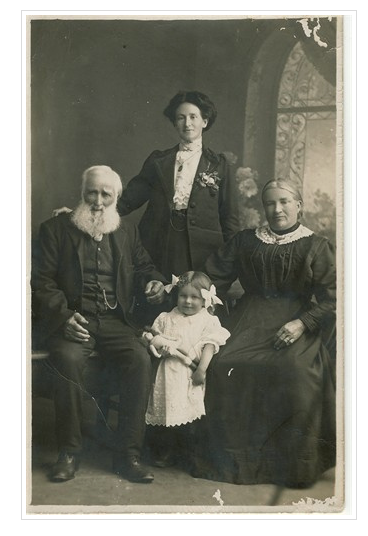
Adam and Elizabeth (both seated) with family members:
These early pioneers were the parents of the “unknown” girl in the market, “dragged away” to the farm in Wandong by the older German man. Marge and Alice knew nothing of their colourful lives.
Nor did they know anything about their great grandfather. “there was “some evidence of a high class family, ….. the Von Dows of Bavaria.”
In fact Johann Joachim Ties Dau was born in 1832 in Bukowko, (Neu Buckow in German) in present day Poland. His parents were Gottlieb and Anna. Their town, which they would have called Bukówko, was part of Pomerania, in present day Poland. Situated in what is known as the “Polish Corridor”, over the centuries Bukowko has also been part of Sweden, The Holy Roman Empire, Denmark, Prussia,, France (Napoleon) and East Germany.
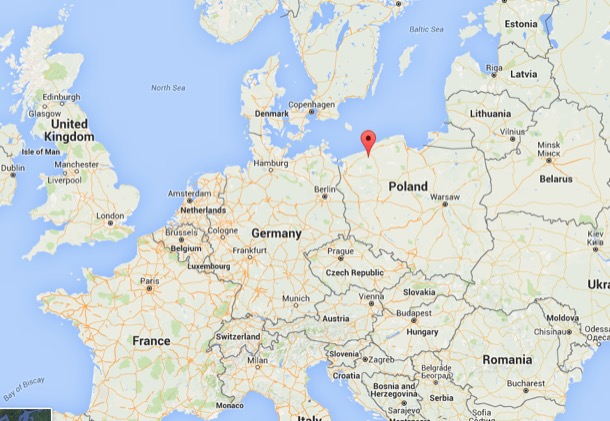
Johann arrived in Australia during the 1850s with his wife, Maria (born Maria Winter), who was from the same town and six years younger. The couple acquired a farm at Wandong, near Kilmore.
In 1861 a child, Eliza, Louisa Dau was born. Maria died in childbirth. The baby lasted only a year before it too died.
So in 1865, the thirty-three year old Johann had suffered his wife’s death four years earlier, and his baby daughter, three years ealier.
……….
Now you have the facts and the family tale. We have the knowledge that our roots go back to the very early days of the Colony of Victoria and that the lives of these early settlers were touched by many of the events we read about in history books, including the Gold Rush, bushrangers and encounters with ‘the blacks’.
The immigrants, Martha's parents and husband came from England and Poland as young people looking for a new life.
Martha herself, an older child in a family of twelve children would have helped her mother both with daily tasks and the younger children. She was also according to the tale helping her father sell the produce from their small plot: not an easy life for a fifteen year old girl but probably not uncommon.
Was the older man (actually in his prime at only 33) at the market a good proposition? Was it the Victoria Market or one of the many local markets in the colony? After all Broadmeadows was the country then. Johann had lost his wife and child soon after they arrived in the colony and he owned a farm at Wandong, probably bigger than her father’s small rented plot in Broadmeadows. Did she take a chance, strike out on her own and opt for a better life?
We will never know but she and Johann produced 18 children many of whom also went on to lead colourful lives.
Poor little thing ????
Alf and Alfreda: the Early Years
Alfreda, our maternal grandmother was living in St Kilda and attending the Melbourne Continuation School in the early 1900s. While she was finishing her secondary education. Alfreda met her future husband Alf, who was recovering from rheumatic fever and had left his country teaching position and moved to Melbourne to work at Blocky Stone, a hardware supply company. Alf boarded In St Kilda with his aunt Mishy Cowden. Arthur, Alf’s older brother had also boarded there and Arthur had an attractive young girlfriend, Alfreda Holm; not for long! Alfreda must have been quite attracted to this tall red headed young gentleman from the country. She abandoned Arthur, and Alf and Alfreda became ‘sweet hearts’ when she was 16 and he 17.
Alfreda completed the secondary schooling she had so desired. Even though she could have sat for the University entrance exam, her family could not support a full time student. Teaching was her only option. At the age of 18, she embarked on her teaching career at Elsternwick Primary School.
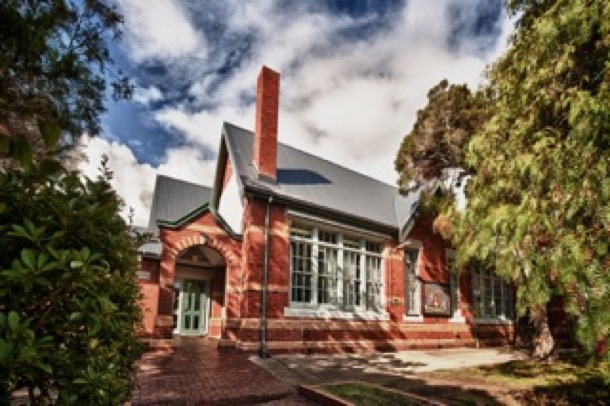
Elsternwick Primary School
Alfreda’s and Alf’s courtship was, as was the custom, a very proper affair and one would imagine that this was so, as Alf was the son of a pastor. Outings included picnics on the St Kilda Foreshore:
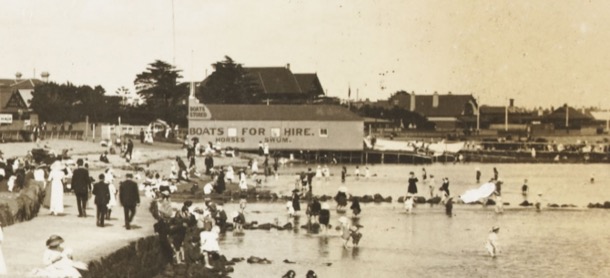
and ‘doing the block ‘ at the Block Arcade in Collins Street:
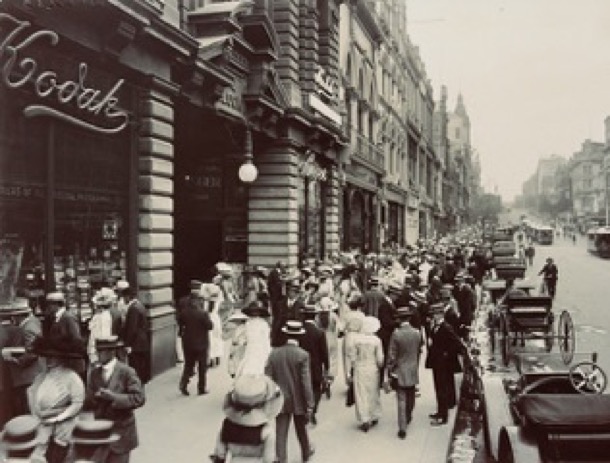
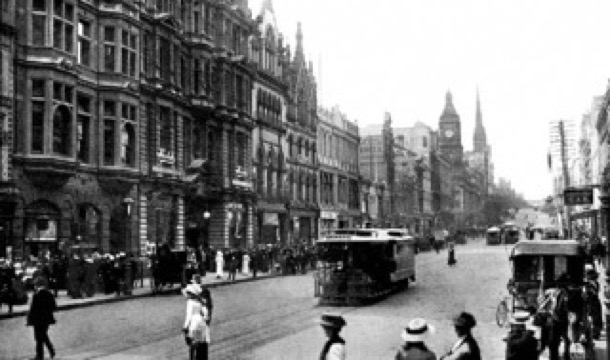
Collins Street
Alfreda pictured in 1910.
As Alf played cricket most Saturdays during the cricket season, Alfreda would have accompanied him; in fact she became so involved that she was appointed scorer.
Outings further afield involved visits to Alf’s family at Diamond Creek where Alf’s father was the Pastor at the Methodist Church. In the early 1900’s this was really the country and Alfreda enjoyed these visits and her introduction to country life.
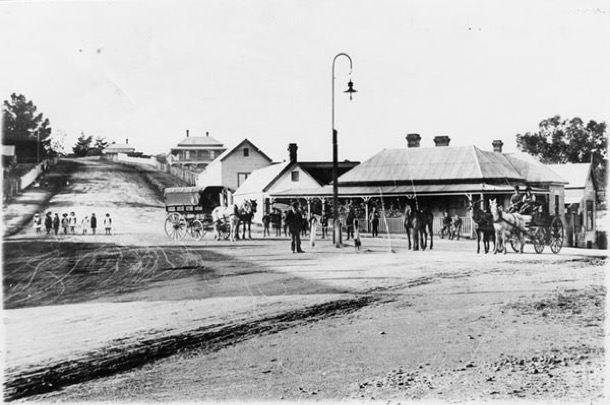
Diamond Creek around 1910
War in Europe broke out in 1914. Droves of young Australian men were enlisting in the army, hoping that it would last long enough for them to get there and have the great adventure it promised to be. A wave of fervent nationalism swept the country. Alf had recovered from the rheumatic fever that had ended his teaching career, but the residual heart damage meant that he was rejected for military service. A young man not in uniform, he was given a “white feather” as a mark of cowardice.
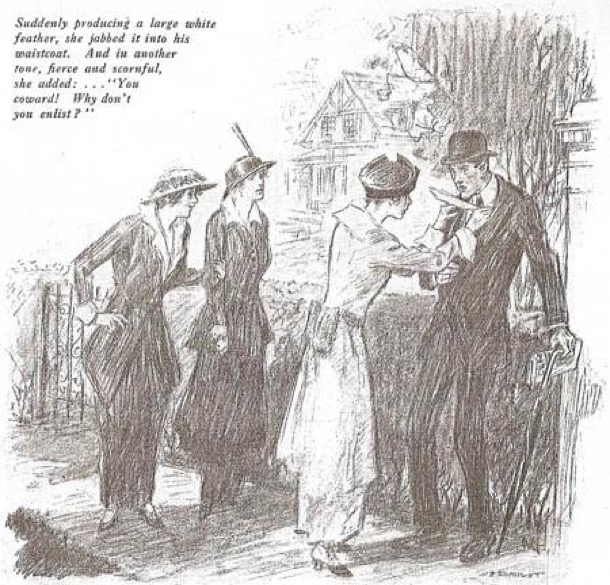
He suffered what was called a “nervous breakdown" which, at the time, was attributed to embarrassment and shame.
During his recovery, he lived in the small town of Eildon Weir, 140 kilometres away, where he managed the general store, selling supplies to the men building the weir.
Alfreda remained loyal to Alf first through his illness, which today we would call clinical depression, and then through his extended absence at Eildon Weir.
Later in 1914 Alfreda’s family moved to Surrey Hills, and Alf moved with them. Alfreda got a job teaching at Balwyn Primary School and Alf went back to his city job. They lived at Elwood Street Surrey Hills. Alf told the story of walking with a lantern down Florence Road in the early morning to catch the train at Surrey Hills station.
Alf and Alfreda were married on December 27th, 1916, at the Surrey Hills Methodist Church, which is still there today:
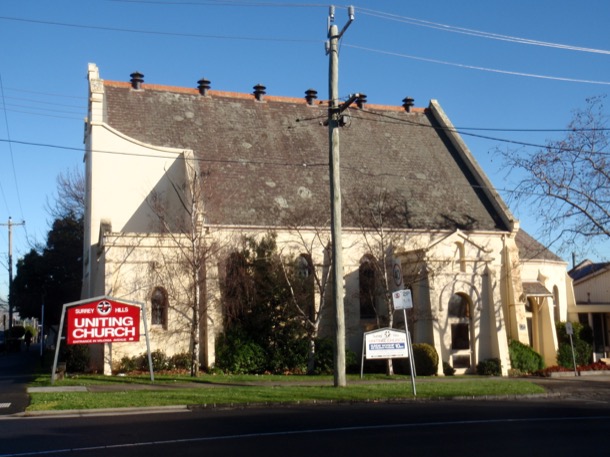
Alfreda did not dress as a bride. Marge tells us in the tapes that this was because it was war time, but a quick search shows plenty of women in full bridal regalia from that time. Perhaps they were super sensitive to how it would look, given that Alf was not “in uniform”. In any case, she wore a cream silk suit. She may well have had it made in the new fashion of flared skirts:
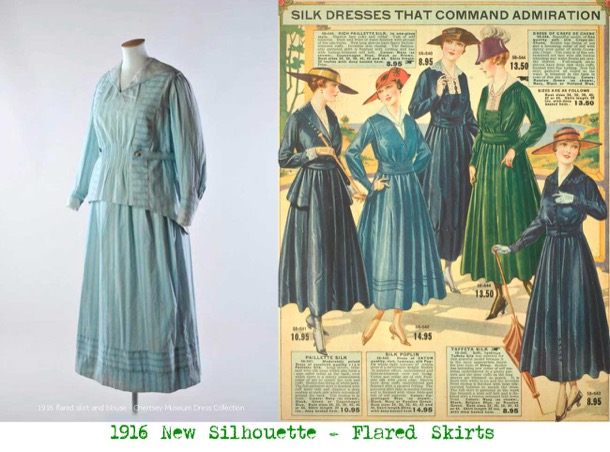
And underneath she would have worn a body moulding corset. Bras, which supported rather than moulded, were in their infancy at this time. They were patented in 1914.
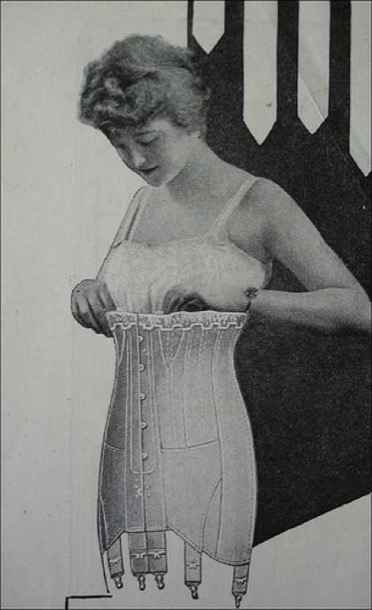
The couple honeymooned at Ocean Grove. There was a steam train all the way to Queenscliff at the most southerly part of the Bellarine Peninsular. And then there would have been a bus to Ocean Grove and finally a ferry across the river.
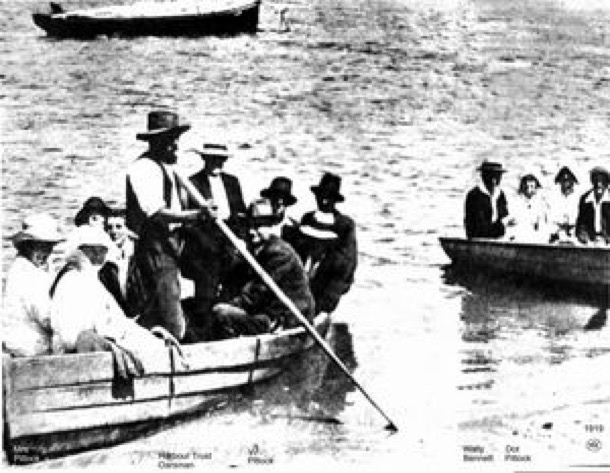
Until 1927, the only way to cross the river to Ocean Grove was by ferry and local ferryman Mr Abenathy would row you across for six pence.
Alf and Alfreda set up home back at Eildon Weir, where Alf resumed his job managing the store.

Out the front of the Eildon Weir store. Alf in a suit at the extreme left.
Alfreda had become pregnant very quickly, and the first few months of their married life had been hectic. But the still birth of the baby at seven months was attributed to a fall. It was flood time at Eildon Weir, and no doctor could get to her. A local midwife helped her through the difficulties of labour with a dead baby. She lost a lot of blood and struggled for twenty-four hours in the final stages of labour. Afterwards, she was not allowed to walk for six weeks.
Alf buried the dead child in the back yard of their little house. It was a boy, who was to have been named Peter. Interestingly it wasn’t until 1930 that “viable” still born babies had to be even reported to the authorities, and even later before they were registered. Nowadays a doctors certificate accompanies a detailed registration document, which must be lodged within forty-eight hours.
Within a couple of years the weir building project was finished, the workers dispersed and the now deserted town was swallowed up by the new Lake Eildon.

Eildon today.
Alf and Alfreda moved back to Deepdene, an eastern suburb, and Alf returned to his city job at Blocky Stone.
Alfreda Maria Holm, our maternal grandmother: the first seventeen years
We have been able, after carefully listening to the tapes, to piece together a portrait of a very interesting woman, deprived of the further education she craved because of gender and circumstance.
Alfreda’s maternal grandparents, David and Martha Bell, emigrated to Melbourne from Belfast. Her mother, also Martha, known as Matty, was their second last child. Alfreda’s father, Roger emigrated about the same time from Denmark. He was a baker and Matty ran his baker’s shop in St Kilda where they lived during Alfreda’s childhood.
Our previous, post published on 18/11/15, entitled “Great, Great Grandparents" is full of detail about Alfreda’s grandparents.
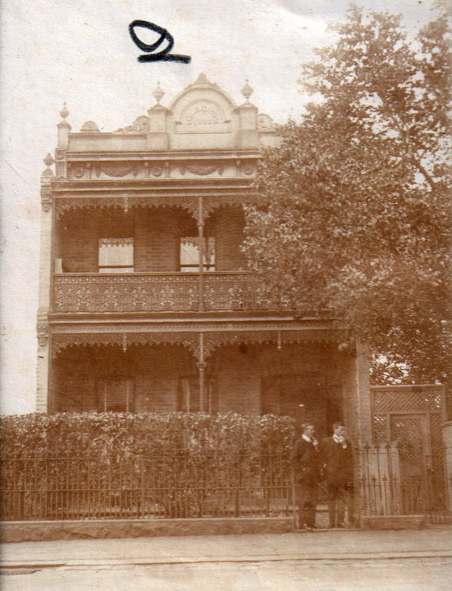
The few photos we have of Alfreda as a young woman, come from an unlabelled, unannotated photo album we found among our mother, Alice’s photo collection. I remember her showing it to us, but unfortunately, the only part of that conversation I remember is the fact that the childishly scrawled number on each photos were written by Alice, indicating the number of people in each photo. This might have been the first time I had contemplated the fact that my mother had once been a child.
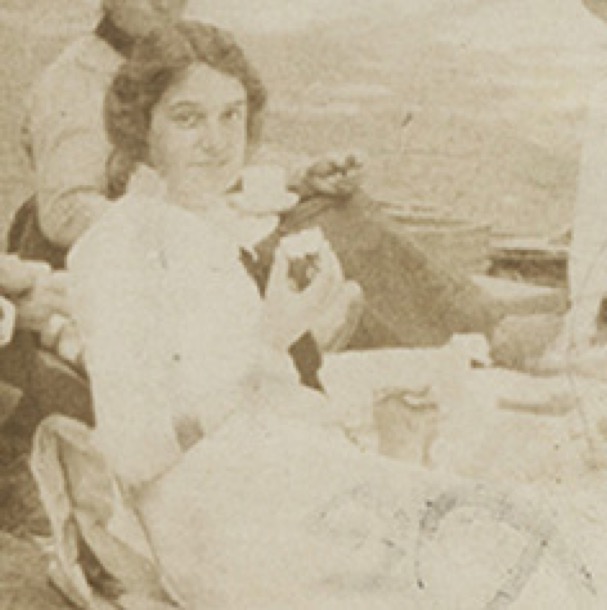
Alfreda Maria, dark and vivacious yearned for an education. This bewildered her family, as further education for its own sake, beyond that required for employment, was not known on either side of the family.
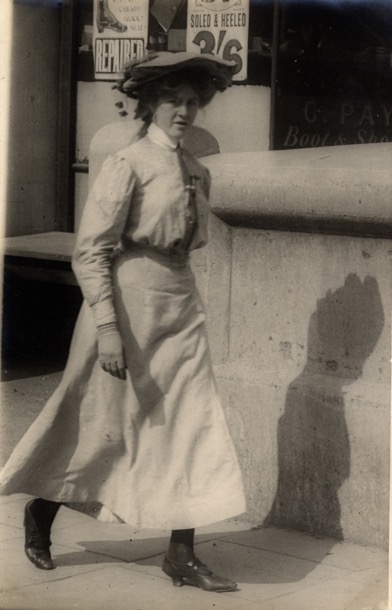
Alfreda would have worn an outfit similar to this to school
As Alfreda’s parents could not afford private school education the only secondary school available in Victoria for her to continue her education after Grade 8 was the Melbourne Continuation School. Luckily, the Continuation School was established in 1905, just in time for Alfreda.
It is to her credit that this determined, fifteen year old girl living in Edwardian Melbourne was able to pursue her dream of further education and find an opening for herself. Handicapped by her gender and lack of interest from her family, she was successful, and loved competing with the boys for top marks in Mathematics classes. She would also have had to do cookery classes: considered an essential element in a girl’s education.

At Melbourne Continuation School
The opening of the co-educational and secular Melbourne Continuation School marked the beginning of state secondary education in Victoria.
The site chosen for the school was at the top of Spring Street, now occupied by the Royal College of Surgeons.
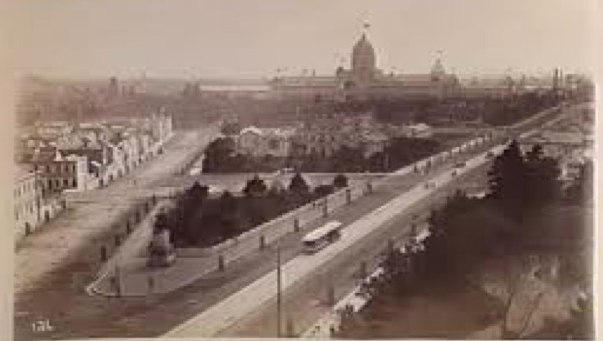
The building in the centre of this photo is the Continuation School. On the skyline is the Royal Exhibition Building.
In 1905 the Continuation School offered a two year teacher preparation course to pupils aged 14 years and above. It also provided tuition, enabling students to sit for university entrance exams. Unfortunately this was not an option for Alfreda and so, after two years further education, she began her teaching career.
In 1914, long after Alfreda had left, the old Continuation School became so overcrowded that a solution needed to be found. Consequently Melbourne Boys High was established for the boys and for the girls: MacRobertson’s Girls High School. Both of Alfreda’s daughters, Alice and Marge, were to attend this school for their secondary education.
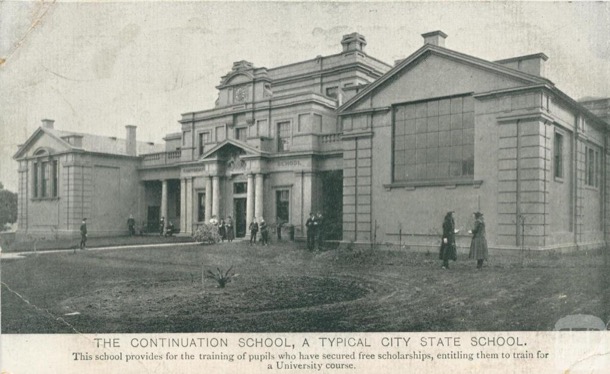
How to Rescue the World
ALF AND ALFREDA
Marge and Alice in their family history tapes, discuss Alfreda’s political and philosophical bent. The setting is Croydon in the 1930s. Croydon is a country town and it is the height of The Great Depression. Alf is working long hours at the Croydon Timber Yard and the family sell milk and cream from their cow. Many of their neighbours are unemployed, and homeless men come to their door to ask for work or food. In Germany, Hitler’s Nazi party is beginning to show its true colours and Russia has been a republic for less than twenty years. Alfreda is consumed by the great ideas of Politics and Economics. She shares this with Frank Hibbert, the Croydon Primary School headmaster.
Alfreda’s friend, Frank Hibbert was a progressive educator who shared her political views. His influence on the young Marge and Alice was profound.
There are also signs of early environmentalism in Alfreda’s letters. On January 16th 1935, she and Alf are camping at Yellingbo, by the creek in what is now the protected area for the Helmeted Honeyeater. She writes to Alice:
Yesterday was a beautiful day and in the evening just after sunset - oh! I wish i could tell you or show you how beautiful the bush was - for half an hour. What God has given us is so beautiful, but don’t humans muck things up - an ugly fence, a cigarette butt, an old piece of lolly paper thrown down. an old pair of shoes - everything we touch seems ugly after that beauty that I saw last night- even our bodies haven’t the beauty and grace of the wild things….. I’ll see we don’t disfigure God’s beautiful bush when we leave this lovely spot.
And later, in 1946, Alf gives us a taste of his own strong sense of social justice. He is visiting Marge in Sydney and has just received the news that Alice and Jim have managed to buy the block of land in Box Hill South that became our family home. He writes:
Your news about your block of land caused quite a lot of excitement in the family circle. Our own few square feet of land is of great importance in our lives. At last we are the possessors of what really amounts to an inheritance - a small portion of God’s earth which we can call our own. It was ordained that each man should have his share of good earth; but man overruled God’s laws and made his own, thereby making it easy enough for a rich man to obtain all the land he wants to, but placing every obstruction in the path of the poor man to obtain that which is morally his own. It is only when people, like you two, scrape to save the wherewithal, that you get your share, or rather, a very small portion of it. But I must keep off my pet theme.
ALICE AND JIM
This was the value system that Alice, our mother, has passed on to us. We were never in any doubt about which side of any particular issue was the correct one.
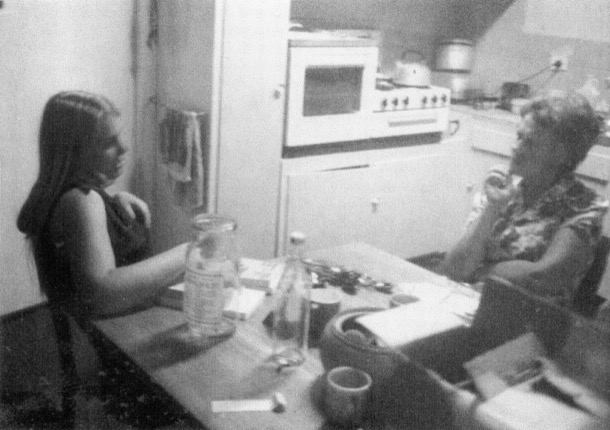
Margaret and Alice at the Moore Street kitchen table
Both Alice and Jim, our father, were staunch Labour voters, and had a strong commitment to social justice.
The world’s first atomic bomb was detonated in Japan in 1945, followed by a nuclear arms race between the USA and the USSR. Bombs were tested, and people felt that there was a constant threat of war breaking out again. Alice and Jim and a like-minded couple from our street were involved in the call for unilateral nuclear disarmament. Another neighbour, Judah Watten, a writer and a communist, was also a member of this “leftist” protest group. This was the time of anti communist McCarthyism in America, and Jim and Alice’s actions were quite radical.
Alice became more confident and able to hold her own in conversations over these years. There were many discussions around our Moore Street kitchen table about the social or political issue of the moment.
Christian social justice became her main focus during her fifties and sixties.
She was active in a number of left wing church organisations. I remember in 1975, when I was living in the country, listening to her talk on the radio about third world poverty. Even in her later years, blind and housebound, she would listen avidly to the radio and talk about politics to anyone who would listen.
Of Jim, we have fewer memories. We remember marching with him in a teachers' protest on the issue of State Aid to private schools. We are now quite used to Governments providing money to private schools, but, when first mooted by the Menzies Government, it was greeted with outrage by many. One of Jim’s concerns during the march was that he would appear on the television news and be seen by his conservative, Catholic, Liberal voting mother.
Jim was a member of the Board of Management of our family’s church, St James, Wattle Park. He was outraged when he discovered the cost of the new church building. He resigned over the issue. In his view the money would have been better spent elsewhere. This is evidence of the strength of his principles, as his role in the church was important to him.
SUE
My memories of my early twenties and engagement in ‘protest’ is of the outrage of youth. ‘How dare they!’
During my last year at College and my first years of teaching, the VSTA, the union representing secondary teachers, was very active in a campaign to improve teaching conditions. I had had an early introduction to strike action by teachers when Margaret and I marched with Dad over state aid to non government schools so I was an eager participant in the ferment.
In outrage that the State Government would contemplate increasing class sizes and teaching allotments, a couple of friends and I formed a VSTA branch and began conducting meetings. I remember calling a strike meeting and organising a boycott of classes that we were convinced would change the world. It didn't! Fancy that! We were still fighting this battle during our first years of teaching.
A much more serious concern was the Vietnam War that the US had been involved in for years and, unbeknown to the public, so had Australia! Prime Minister Menzies had mislead the Parliament and the public, and had committed Special Forces to fight in Vietnam. His successor, Harold Holt, invoking the ANZUS Treaty, upped our level of support and, as the war dragged on with no victory in sight, National Service or conscription was introduced. My family and friends were all very much against the war and the deceptive and high handed action by successive Liberal Governments. Outrage and protest was a consuming passion.
It was sometimes a bit scary! In the early days before the huge moratoriums, the numbers protesting were considerable but not large, and the police seemed to be a threatening and sinister presence. I remember the July 4th 1967 protest outside the American Consulate in St Kilda Road. I went to this one with Mum and Margaret.
It was dark as we arrived and stood with the other protesters outside the closed front gates to the Consulate. There was no visible presence in the building, as we held our anti-war banners and chanted slogans. The most sinister aspect was watching the police buses pull up across the park and disgorge many, many policemen. I remember thinking, ‘Can this be Australia?’ A noisy and highly visible minority of the protesters were quite confrontational and aggressive and were consequently arrested. We stayed well clear of the action but it was hard to avoid the police horses. They are enormous up front and personal, and were used very effectively to nudge the crowd away from the gates. Overall it was a very sobering experience and one that has stayed with me. We live in a democracy with the right to protest peacefully. What must it be like protesting under less benign circumstances?
After these small beginnings the protest numbers swelled, culminating in the euphoria of the Moratorium Marches that brought cities across the world to a standstill, including Melbourne.
The ABC captures the spirit and the times better than I can. Have a look:
http://www.abc.net.au/archives/80days/stories/2012/01/19/3411534.htm
Even though I may have wished for many thousands to take to the streets again, as they did in the Moratoriums, it has not happened on such a scale, but here’s hoping!!
The demonstrations against the Vietnam War left a profound legacy. After such a powerful and successful protest movement, it seems the natural response to feelings of outrage: paint a banner and march! As Margaret says, ‘It is part of democracy’. Aren't we lucky!
Therefore, along with thousands of other concerned people, I have attempted to ban nuclear weapons, stop the war in Iraq, stop logging of old growth forests in Tasmania and East Gippsland and persuade our government to take action to reduce emissions.
The world has changed, but not always for the better. Today, as well as the kitchen table, the letter, the banner and the march, we have at our disposal the power of global and instant communication and social media. It is the era of Get Up and ’Clicktivism’.
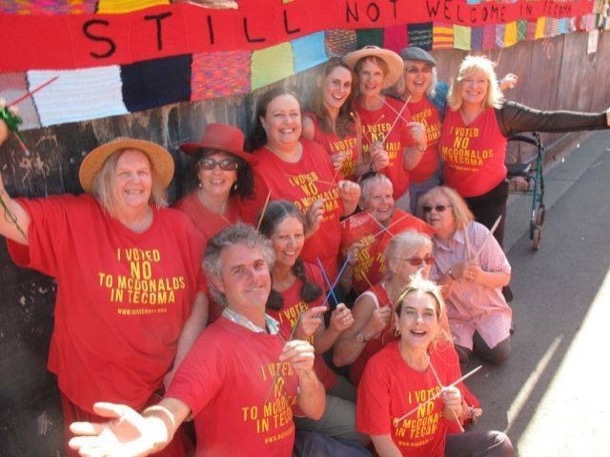
Sue and Margaret protesting together at Tecoma
MARGARET
July 4th 1967. It is winter in Melbourne and it is raining. The puddles flash …blue…black…blue…black…
“Link arms!” call the young bearded marshalls running up and down the line of marchers. We are marching on the American Embassy, protesting atrocities in Vietnam, pressurising our government to change their “All the way with LBJ” policy. Police horses charge the crowd. One of my companions, my forty-three year old mother, loses her handbag.
Five years later a New Yorker I go out with a few times, assures me that there would have been fully armed Marines in the embassy, and that they wouldn’t have hesitated to shoot, had we successfully “stormed” the building.
This was my first real “demo”. I don’t remember why it was just my sister, my mother and I there. I was fifteen.
Over the ensuing fifty years, I have waved banners demanding many things: the end to the logging of old growth forests and the creation of National parks; that uranium be left in the ground; that there be land rights for our indigenous populations; smaller class sizes; a fairer allocation of education funds and more of them; that we not go to war and/or bring our troops home; that the public service not be decimated by cuts; that the separation of power between the judiciary, the legislature and the executive be maintained; that MacDonald’s stay out of our Hills community.
Most recently I marched with Michael and Chris to urge our planet to act on Climate Change:
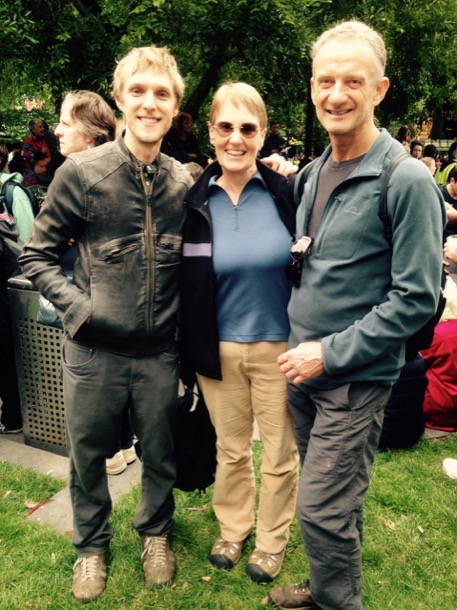
Marching for climate justice... a family affair
The thread that links these causes, is the same thread that runs back to the 1930s around the Coates’ dinner table in Croydon. It involves words like environment, justice, democracy, fairness, equity, peace, kindness and conservation.
Great Great Grandparents
Like many Australian families, ours is a story of migration to a new country. All four of our maternal great great grandparents were European: English, German, Danish and Irish.
These four migration stories happened between the 1850s and 1870s. Three of the migrants were our great great grandparents, and one was a great grandparent.
COATES, ARRIVED VICTORIA 1860s
Coates was an English engineer who travelled with his wife to Australia in the 1860s. Their first names are not known.
The Barwon River is the large river than flows through Geelong. In the new colony, there were no iron works: the worked iron had to be imported from England, along with the experts to do the work.
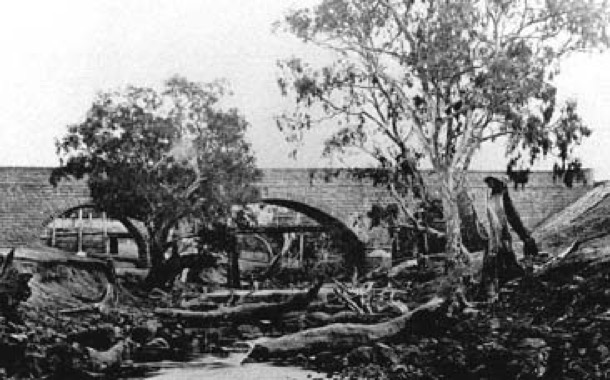
Barwon Bridge then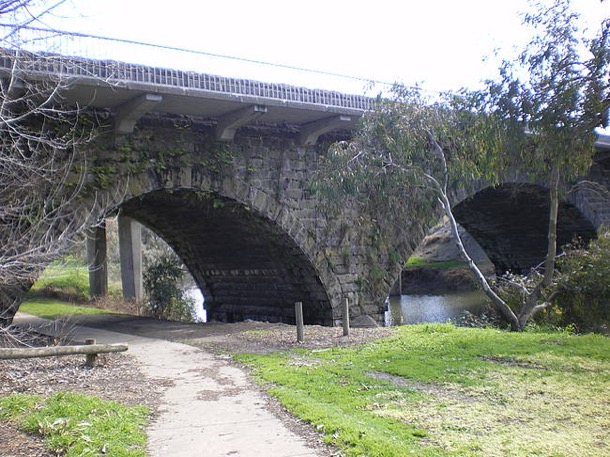
Barwon Bridge now
We don’t know whether Mr and Mrs Coates planned to do this job and then return to England, but they would have found a thriving, wealthy colony. Gold had been discovered in central Victoria just ten years earlier.
DOW, ARRIVED VICTORIA 1860s
Dow was a German farmer who arrived in Australia in the 1860s. He married a fifteen year old girl, of whom we know very little. Wandong is 70 Kilometres north of Melbourne. In the years the Dows lived there there was a thriving timber industry and some gold mining. By 1880 there was a railway line from Melbourne.
HOLM, ARRIVED ADELAIDE 1872
Roger Holm: this one is our great grandparent, a baker, who himself arrived in Australia from Denmark via England in 1872.
Roger had been born in a part of Denmark called Schleswig-Holstein, that had been disputed territory for centuries. At the time when he was a child, Germany did not yet exist. It was still a whole lot of little countries. When Roger was twelve, Otto Von Bismarck’s army invaded Schleswig-Holstein.
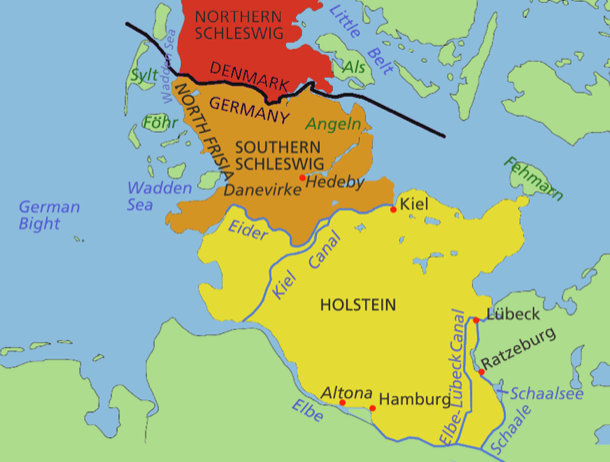
Map of Schleswig-Holstein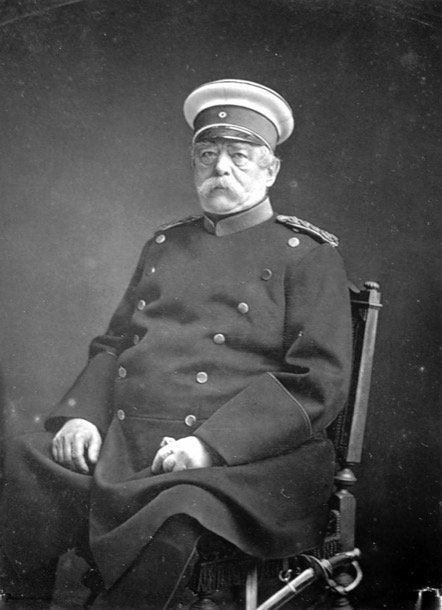
Otto Von Bismarck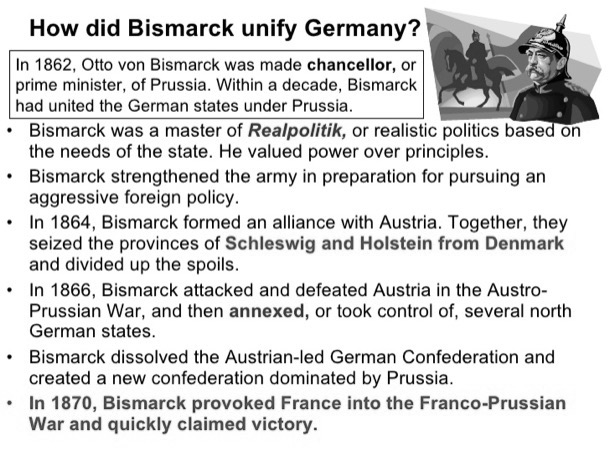
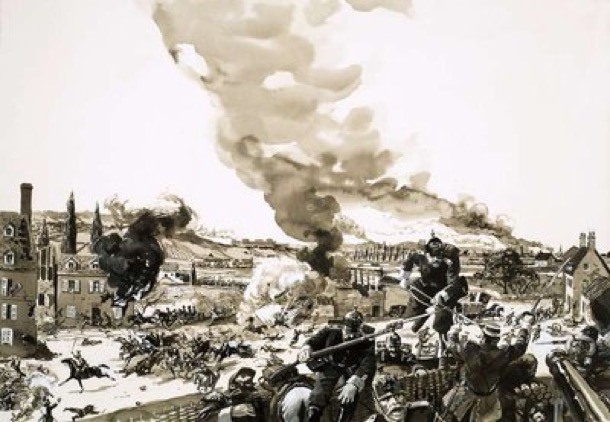
Painting: Bismarck Wresting Schleswig Holstein From The Danes
BELL, ARRIVED VICTORIA 1850s
David and Martha Bell was an Irish flax farmer, who arrived in Australia with his wife Martha (born Martha Elvidge) in the 1850s. Belfast was a prosperous modern city at that time.
The area had become a specialist for farming and processing flax, which was woven into linen, used among other things for ships’ sails.
First Year Teaching 1909
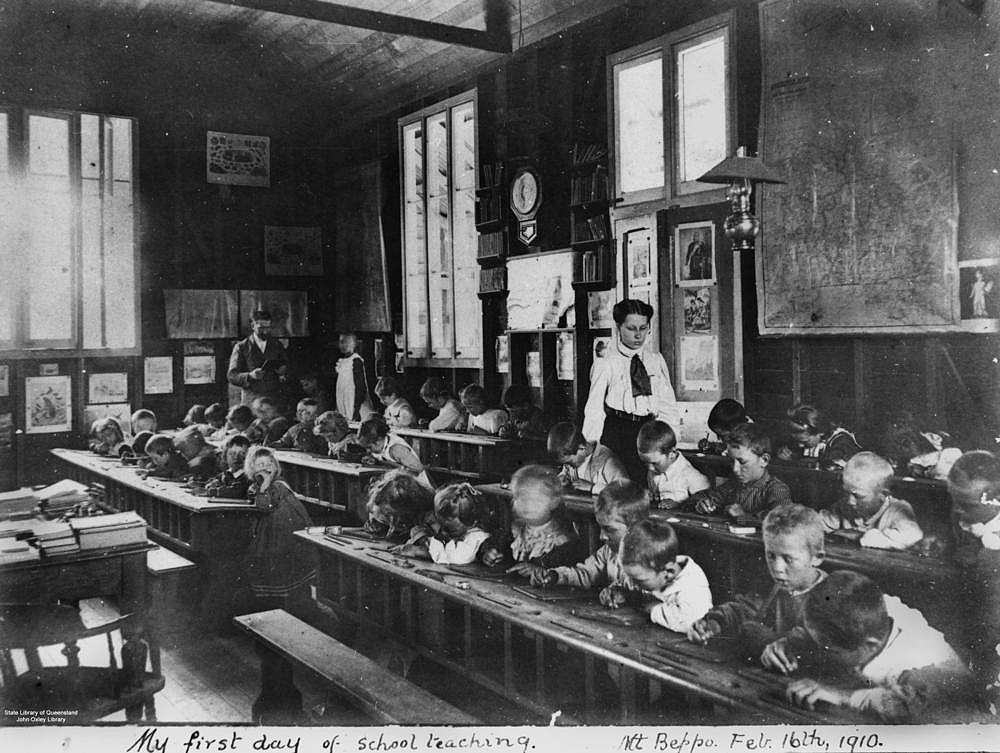
These children, photographed in 1910, are writing on slates with chalk, as did the children in our grandfather Alf's classroom in 1909. The holes in the desk in front of each child hold inkwells, in which they dipped their pens. The little children are in the front, the older ones at the back.
Alice, our mother, described her father's brief teaching career in 1909-10. The recording was made during the family history taping sessions with her sister Marge, in 1990.
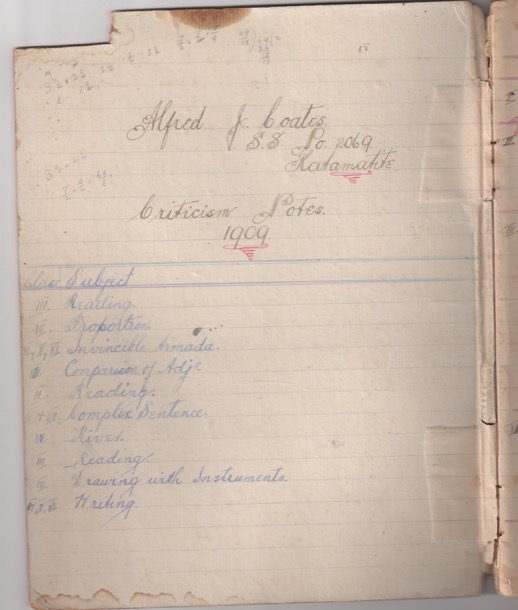
Alfred J. Coates
SS No 2069 (State School number)
Katamatite
Criticism Notes
1909
Class iii Reading
Class iv Proportion
Class iv, v and vi Invincible Armada
Class iv Comparison of Adj's (adjectives)
Class ii Reading
Class v and vi Complex Sentence
Class iv Rivers
Class iii Reading
Class iii Drawing with Instruments
Class iv, v and vi Writing
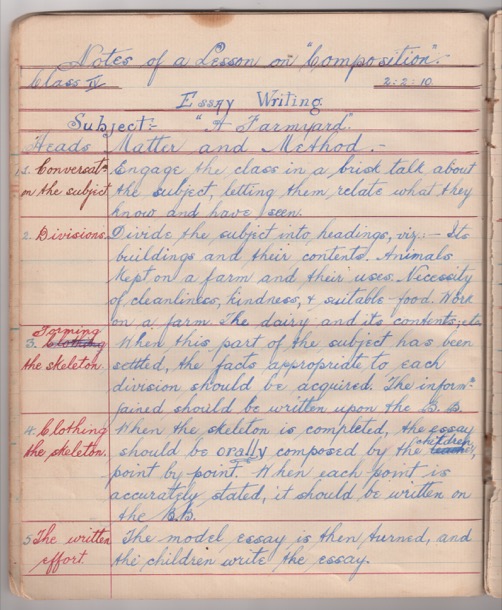
Notes of a Lesson on "Composition"
Class vi 2:2:10
Essay Writing
Subject:- "A Farmyard"
1. Conversation on the subject.
Engage the class in a brisk talk about the subject, letting them relate what they know and have seen.
2. Divisions
Divide the subject into headings, viz :- Its buildings and their contents. Animals kept on a farm and their uses. Necessity of cleanliness, kindness, and suitable food. Work on the farm. The dairy and its contents; etc.
3. Farming the skeleton.
When this part of the subject has been settled, the facts appropriate to each division should be acquired. The information gained should be written on the B.B. (blackboard).
4. Clothing the skeleton
When the skeleton is completed, the essay should be orally composed by the children, point by point. When each point is accurately stated, it should be written on the B.B.
5. The written effort
The model essay is then turned and the children write the essay.
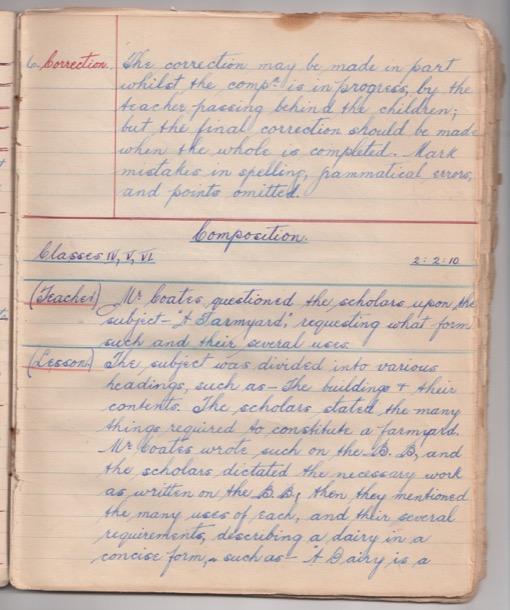
6. Correction
The correction may be made in part, while the composition is in progress, by the teacher passing behind the children; but the final correction should be made when the whole is completed. Mark mistakes in spelling, grammatical errors, and points omitted.
(Lesson critique by Headmaster)
Composition
Classes iv, v and vi, 2:2:10
(Teacher) Mr Coates questioned the scholars upon the subject "A Farmyard," requesting what form such, and their several uses.
(Lesson) The subject was divided into various headings, such as - The buildings and their contents. The scholars stated the many things required to constitute a farmyard. Mr Coates wrote such on the B.B, and the scholars dictated the necessary work as written on the B.B., then they mentioned the many uses of each, and their several requirements, describing a dairy in a concise form, such as - "A Dairy is a
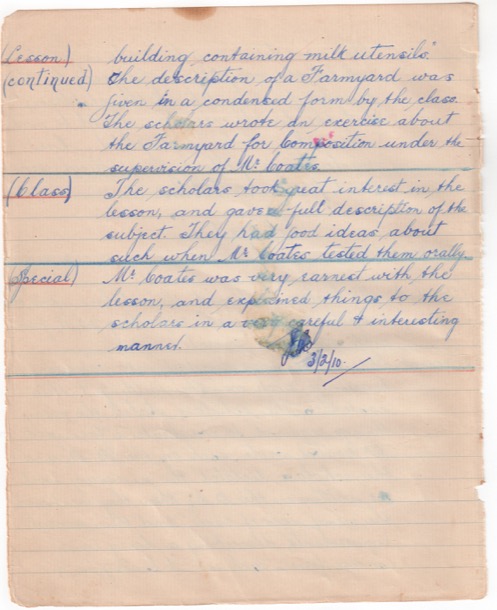
(Lesson) (continued) building containing milk utensils." The description of a Farmyard was given in a condensed form by the class. The scholars wrote an exercise about the Farmyard for Composition under the supervision of Mr Coates.
(Class) The scholars took great interest in the lesson and gave full description of the subject. They had good ideas about such when Mr Coates tested them orally.
(Special) Mr Coates was very earnest with the lesson, and explained things to the scholars in a very careful and interesting manner.
JM
3/2/10
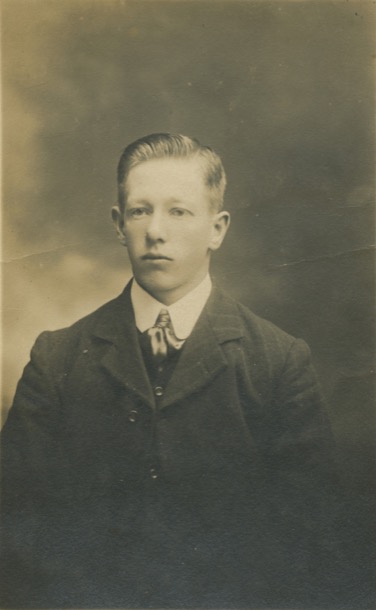
Alf 1910
Marge and Alice went on to discuss some other aspects of Alf's early life.
More of Alf's Teaching Notes are available in the Resources Page, which can be accessed from the Navigation Bar at the top of this website. If you are using a phone, or a tablet in portrait rather than landscape, click the tiny + under the logo and heading, to reveal the Navigation options. Our site is much better viewed on a computer or at least in landscape rather than portrait.
Twelfth Birthday Letters to Alice
These two letters were written to our mother Alice on her 12th birthday. Alice was staying with her grandparents , Roger and Martha Holm at their house in Boronia Street Surrey Hills. By the way, the house is still there, but more of that later in another story. Living with Roger and Martha was another of their daughters, Bertha or Auntie Bert, unmarried and with a flourishing dressmaking business in the front room of the house. Later she moved the business to Camberwell at the Junction. These letters were written by Alice's father Alfred, usually known as Alf, and her mother Alfreda or Freda. The letters reveal two very different personalities that both had a powerful and enduring influence on their young daughter. Our joint memories of the two authors of the letters are of two very different individuals.
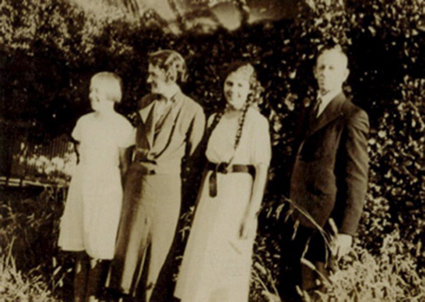
From left Alice, Freda, Marge, Alf
ALF'S LETTER
CROYDON
23.9.35
My Dear Baby,
Although you will be 12 years old tomorrow you are still my baby, and you always will be. Your old Pop wishes you many happy returns of the day, and hopes that the sun will be shining brightly, so that you will be able to enjoy yourself.
I am sitting beside the stove writing this, although the night is not cold; but you know how I love the fire. (Mummy has just burst in on my meditations with a dose of Cascara.) (herbal laxative)
The Kettle sings upon the stove,
It sings a lovely song to me.
It sings a song I dearly love-
“I’m boiling for your cup of tea”
(Auntie will appreciate that verse)
The chooks have settled down to rest
Their daily duty nobly done.
Each one has given of her best,
And Mummy loves them, every one.
(That verse will appeal to Nanna)
The cats are sleeping in the straw,
Their stomachs full of meat and mice.
They sleep so sound - I heard them snore.
Their beds are comfy, soft, and nice.
The house is quiet. All noise is stilled.
Outside the night is calm and clear.
My cup of love has now been filled.
I drink your health, my Baby dear.
(A. J. Coates Poet)
Don’t stay away too long. I can’t spare you. I haven’t any anybody to get in the gun. The cow got out of the paddock, and I told her she was in the gun; but she didn’t take any notice of me. So what’s the good of that.
Good-night, Snowy-Bob, with your
Dad’s best love.
X x x x x x x x
Give my love to everybody.
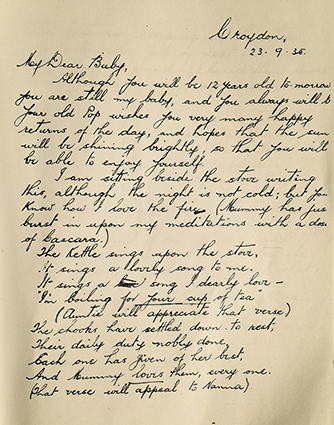
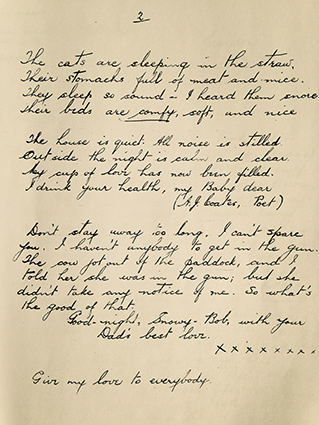
ALFREDA'S LETTER
CROYDON
23.9.35
My dear little Girl,
I cannot find a pen but I must write and wish you many happy returns of your birthday even if I only use pencil. It is rather superfluous for mothers to wish their children that formal wish, isn’t it dear? Because every day we are doing things to make our little children well and happy so that they will have many happy returns.
When you are away from me I realize how much every minute of the day is spent in doing this and how much I love my little baby girl. My mother and father did that for me and some day you will do that for your little children and then you will realise what a big love mothers and fathers have for their children It is the love that makes life worth living - the giving love, or shall I call it: the love that forgets self. That is the kind of love that makes the giver happiest.
It is one of the big true things that Jesus taught. I think the best I can wish for you on your 12th birthday is that you will realize more and more as the years go on just how true and real are all the things that Jesus taught, and dear you can only get to know by letting God teach you, asking Him to teach you.
What a funny old letter to be writing to you today dear.
I wonder if it is because I realize you are growing up. You will be finding things out yourself more, in other words “growing up”. I think you started growing when you were a baby but I don’t just mean that kind of growing up.
Well dear we have had quite a gay weekend, the pictures were beautiful. I was wishing you and Marj were there. Tell Auntie to ring Dad if she has any other plans for Wednesday.
Good-bye my dear little one.
All my love is going to be sent to you at 12 o’clock tomorrow by thought waves.
Do you know what I mean? I will think of you at 12 o’clock and you think of me and that that will mean a birthday kiss and all my love.
Mother
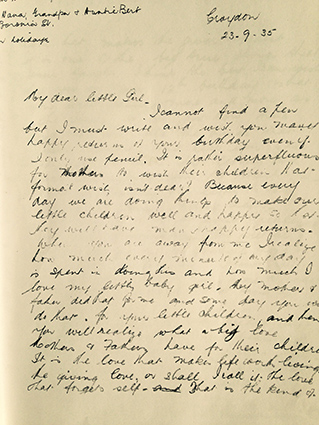
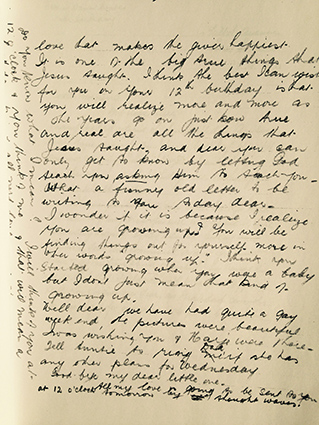
Here are Martha and Roger with Alice and Marge and other younger grandchildren in the Boronia Street Garden
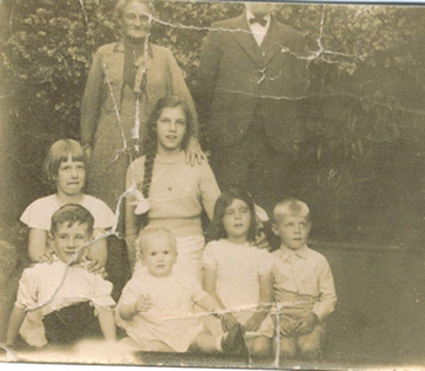
Memories of Alf
“A J Coates, poet.” That dry humour is so much as I remember my papa. My strongest memories of him are from his time living in the flat attached to our house in the nineteen sixties. By that time his red hair was greying and although he was still tall, he was a bit stooped.
“What do an old spud and a man watching a football match have in common? They’re both “specked taters”. His jokes were all like that.
But his sense of humour was strangely coupled with an enduring air of melancholy. He had several “nervous breakdowns” in his life. Nowadays these would be called bouts of clinical depression.
Alf had been a very gifted student and had spent his very early working life as a teacher. The precision of his letter writing is evident in the setting out and punctuation.
We remember his collection of classics and poetry books and often he would lend them to us. He loved reading, including poetry. The “bush poets” Henry Lawson and Banjo Patterson’s best work was behind them by the time Alf was at school, but their work, and that of other Australian poets were very strongly part of the everyday curriculum. This gives a context to Alf writing a mock bush poem as he did in his letter, and signing it like that. But that wry, self deprecating humour is there too.
The other aspect of his personality that shines through is his gentle warmth. This was a time when Australian men were loathe to express such softness. Our mother told us about how he struggled with his own sense of masculinity. Although he worked in timber yards, his work was behind the hardware shop desk. He was ashamed of this. His insistence on only ever wearing black socks was seen as symbolic of his fear of being seen as a sissy. And yet here is this loving, expressive father writing to his daughter, apparently at ease with openly expressing his love.
Memories of Alfreda
Alfreda was also tall. I remember her as a rather elegant, formal figure, clad in beautifully tailored clothes, no doubt made for her by her clever sister. She had very long hair always worn in a loose bun. I do not remember her ever being without her stockings and high heeled lace-up black shoes. The two times I remember staying with Nana and Papa I can remember watching Nana in her dressing gown, sitting at her dressing table, brushing her hair and loosely plaiting it for the night. She was quite a remote figure, not one for hugs and cuddles. However, my memories are of warmth and affection towards her two daughters and her husband.
Neither Margaret or I have any memories of her obviously very strong religious beliefs, that seem to have been very much part of her everyday life and thoughts. We only learnt of these through reading her letters. It would be gratifying to Alfreda that her daughter Alice did indeed see “just how true are all the things that Jesus taught". In fact, in the latter part of her life, Alice’s interest in theology provided her with both intellectual stimulation and solace. I suspect mother and daughter were very alike.
How we remember Alf and Alfreda, in their seventies:
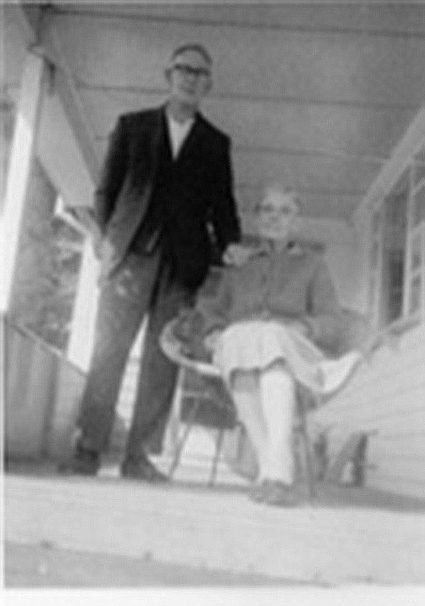
Historical, Social and Geographical context
Main Street Croydon, 1930s
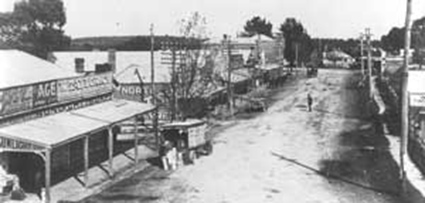
At the time of these letters, the Coates family lived in Hewish Road, Croydon, close to where the Croydon swimming pool is today. The Great Depression of the nineteen-thirties was at its height. Alf never lost his job at the Croydon Timber Yards, even though many men did. The family kept chickens, whose eggs they sold, and a cow and had a large vegetable garden.
Alice and Marge remembered the desperate men who would come to the house for a chance to do some odd jobs around the house. The Coates family were not well off by any means, but they were grateful for what they had and shared it generously with others.
Politically the nineteen-thirties was a time of turmoil and change. Thirty percent of the Australian workforce was unemployed, and this was reflected across the western world. Economic theories about how to deal with the crisis ranged from the Keynesian “spend your way out” adopted by America, to severe austerity and cuts in Government spending practised in Australia. Political “isms” and experimentations like Communism and Nazism were being explored and discussed around kitchen tables everywhere, and nowhere more ardently than at the Coates’. Alice remembered such pearls of wisdom from her mother as “you can’t educate for goodness and you can’t legislate for goodness”.
The young Alice drank in all this talk and even as a twelve year old, when these letters were written, she was developing the philosophies that would engage her for all of her life.
Croydon, a busy suburb nowadays, was a country town, connected by rail to the Eastern suburbs and the city. In 1935 Alice would have been going to Mont Albert Central School (until Year 8) and Marge to the city based Melbourne Girls' High School, soon to be renamed McRobertson Girls' High School. They travelled on the steam train that went as far as Healesville and Warburton. Incredibly this was the closest school for them that went past Year 10. Expensive school fees were a stretch for the family, but education was valued very highly.
Our Little Allie 1895-1906
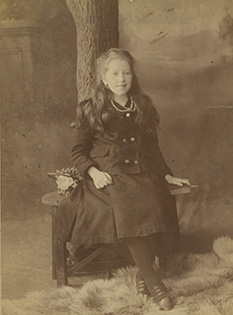
Late July 2007, on a clear winters day in Chiltern, a small Northern Victorian town I found myself standing by my great aunt’s graveside. Alice Martha Coates died on the 8th of October 1906, aged eleven and a half.
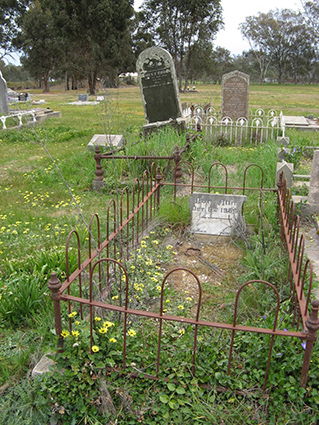
Thomas and Tessa had just been married at Nagambie and we were heading up the Hume Highway for a little R & R with Anne and Ben in the vineyards of Rutherglen. As we approached the turn off to Chiltern, 38k past Wangaratta where my grandfather Alfred had lived as a boy, we decided to have an ‘explore’. We turned towards Chiltern and found ourselves in the historic main street, complete with restored shopfronts, antique shops and the Historical Society, open for business.
Margaret and I, aware that our mother had been named after her, had grown up hearing our grandfather talk in hallowed tones of ‘our little Allie’ who, in our childhood memories, was almost saint like. You must remember that Margaret and I had grown up on a diet of novels such as Little Women by Louisa May Alcott, one of our favourites. In this novel Beth March, a child almost too good to be true and therefore likely not long for this world dies a lingering but saintly death, nursed by her adoring older sister. Fertile imagination conjured up such scenes as we heard the stories of little Allie's death or held the remembrance badge portraying her as a pretty, serious child. Allie died at Chiltern but that was all I knew, so into the Historical Society to find out more.
The building was slightly musty, its walls covered in old photographs and fortunately for us, as is so often the case, it was staffed by an enthusiastic and knowledgable volunteer. Yes, he knew about Reverend Alfred Coates : We think he lived in this house and yes his youngest daughter died here. After rummaging in the filing cabinet we had the location of the grave in the Chiltern Cemetery and we were able to read a newspaper report on the well attended funeral. Alice had obviously been ill for several weeks and it was no doubt a big topic of conversation in the town, especially as she was the daughter of a much loved Pastor. Maybe other children in the town were also ill in those same weeks.
Who was Alice Martha Coates, our great aunt who died aged eleven?
Our grandfather’s parents were Alfred senior, a Methodist parson, and Emma. The church chose his positions and moved the family every three years, in their case throughout country Victoria. They had four children, Florence, Alfred (our grandfather), Alice and Arthur. The photographs below show Allie with her parents and their house in Chiltern.
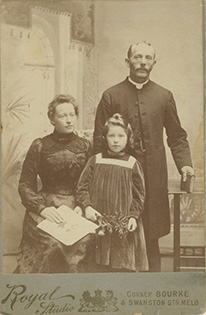
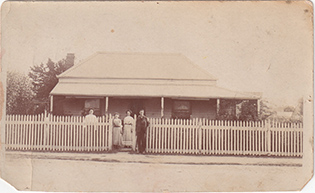
Allie died from the disease Diphtheria. This was a very common childhood disease of the times. Nowadays we have a vaccine for it, and antibiotics to treat it, but in those days it was one of the most feared childhood diseases.
It was highly contagious, and Emma and Alfred must have been very worried about the other children catching it. At first the symptoms are like those of a cold, but a horrible film, like a spider web, grows on the back of the throat or in the nose, and makes it hard to breathe. Alice must have had a really bad dose, because only one in ten people over five died from Diphtheria.
Armed with directions to the cemetery we politely extracted ourselves before we heard the complete history of Chiltern and stepped outside into the twenty-first century world. The cemetery is located outside the now small town, in slightly undulating country. It was chilly that day but this small country cemetery would have seen many blistering hot summer days. My thoughts turned to my grandfather: Allie’s older brother Alf, standing with his family at the graveside during the funeral. Some memories were no doubt already etched in his memory and others were forming These would combine to become the story of this tragic event passed down to us.
The little remembrance badge of Allie (shown below) lived in a wooden box on Alf’s desk. As children, we drank in the pathos of her beauty and goodness, amplified by the Victorian novels we read. The telling and retelling of little Allie’s story first by our grandfather and then our mother and aunt has helped Allie’s story retain its enduring poignancy, lifting it out of the commonplace into the world of idealised tragic heroines.
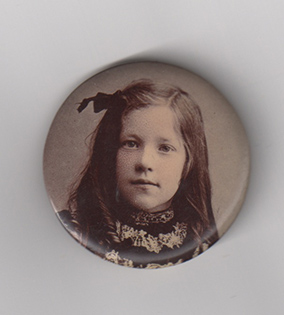
Allie’s grave is indeed in the Chiltern Cemetery, still intact. The modest headstone is there surrounded by the typical wrought iron fence of the era. The only flowers are those of the Cape Weed Daisies growing in abundance throughout the cemetery. The inscription is still legible and simply reads: Our Allie October 8th 1906. As I stood there the story suddenly seemed much more real. Allie was no longer the tragic heroine, but a little girl who died an unpleasant death, mourned by her distraught family.
I picked a small bunch of the Cape Weed daisies and placed it front of the headstone.
